
® edible NEW MEXICO MEMBER OF EDIBLE COMMUNITIES THE STORY OF LOCAL FOOD, SEASON BY SEASON Design ISSUE 85 · EARLY SUMMER MAY / JUNE 2023


505 CERRILLOS RD SANTA FE . 505.930.5325 radishandrye.com Open 7 nights @ 5pm!
GRIST FOR THE MILL
By Briana Olson and Susanna Space
CONTRIBUTORS
LOCAL HEROES
The Skillet, Safe House Distilling Co., Sam Coca, Paloma, and Vivác Winery
TOUCH AND GROW

Sharing Space by Marisa Thompson
THE PLATE
Food for Thought by RoseMary Diaz
FRONT OF HOUSE
Romancing Home by Mariko O. Thomas
COOKING FRESH
Designing a Menu by Stephanie Cameron
EDIBLE INGREDIENT
Steak Pizzaiola
LOCAL SOURCE GUIDE
by Jennifer C. Olson
DESIGNING AGRICULTURAL LANDSCAPES FOR HUMAN WELL-BEING by Robin Babb
EMBODY
MAY / JUNE 2023 75 New Mexico Cocktail Week GUIDE

Food, Fashion, and Landscape by Christie Green

1 EDIBLENM.COM DEPARTMENTS 2 4 6 26 30 34 40 52 68 96
LAST BITE Cocina Azul 54 58 62 DESIGNING NEW DOWNTOWN DESTINATIONS IN OLD DOWNTOWN SPACES
Founders of Ex Novo
Vinaigrette
Modern-Day Perspectives to New Hangouts
The
and
Bring
FEATURES ON THE COVER
® edible NEW MEXICO THE STORY OF LOCAL FOOD, SEASON BY SEASON Design ISSUE 85 EARLY SUMMER MAY JUNE 2023
Design. Photo by Stephanie Cameron.
Design

It is the season of gathering on patios, in gardens, at farms, over cocktails, at tables illuminated by chandeliers or candles or summer’s late dusk. And in the spirit of this whole-bodied season, this season of growth, this issue of edible embraces all the senses. It is a savory electropop ballad of place, a sweet classic rock chorus giving rise to change, a jazz riff on taste.
Why design? Because, as says designer and founding president of the Eames Institute of Infinite Curiosity John Cary, “Design functions like the soundtrack that we’re not even fully aware is playing.” It is in the shades on the windows we look out of while eating breakfast, the chairs we sit on at lunch; it is in the art on the walls of the rooms where we meet for dinner. It is in the workarounds we rely on in our kitchens. It is in our gardens. It is in the arrangement of food on our plates.
In these pages, we share the perspectives of two culinary entrepreneurs and the architects working with them to remake historic buildings in downtown Albuquerque. With Mariko O. Thomas, we immerse ourselves in the space at two Taos restaurants, tempted not only to visit those places but to sink into and revel in every meal we sit down for. We explore the art of presentation and include blueprints for a dinner party to remember.
We also consider agricultural space, featuring two farm projects that illustrate the possibilities of designing for the well-being of the humans who will use them. Writing on fashion design that draws inspiration from local landscapes and foodways, Christie Green investigates the practice of deepening the connection to animals hunted or raised for food by preserving and using their hides. Turning to her own backyard, Marisa Thompson offers tips on designing a habitat that welcomes wildlife.
If there is a common refrain in these stories, it is the belief that good design, like good food, is rooted in place. To be sustainable, whether with a brewery or a farm, means designing space that will last. Whatever your vantage, this issue of edible politely urges you, empowers and entreats you, to believe that you and your guests, your team, your people—our people—deserve it.
PUBLISHERS
Bite Size Media, LLC
Stephanie and Walt Cameron
EDITOR
Briana Olson
ASSOCIATE EDITOR
Susanna Space
COPY EDITORS
Marie Landau and Margaret Marti
DESIGN AND LAYOUT
Stephanie Cameron
PHOTO EDITOR

Stephanie Cameron
EVENT COORDINATOR
Natalie Donnelly
VIDEO PRODUCER

Walt Cameron
SALES AND MARKETING
Kate Collins, Melinda Esquibel, Gina Riccobono, and Karen Wine
PUBLISHING ASSISTANT


Cristina Grumblatt
CONTACT US

Mailing Address: 3301-R Coors Boulevard NW #152, Albuquerque, NM 87120 info@ediblenm.com ediblenm.com
SUBSCRIBE ∙ LETTERS



EDIBLENM.COM
We welcome your letters. Write to us at the address above or email us at INFO@EDIBLENM.COM
Briana Olson, Editor
Bite Size Media, LLC publishes edible New Mexico six times a year. We distribute throughout New Mexico and nationally by subscription. Subscriptions are $32 annually. Subscribe online at ediblenm.com/subscribe
No part of this publication may be used without the written permission of the publisher.
© 2023 All rights reserved.
2 edible New Mexico | EARLY SUMMER 2023
GRIST FOR THE MILL
Stephanie and Walt Cameron, Publishers
Susanna Space, Associate Editor

www.blackdiamondcurio.com @blackdiamondcurio 219 W San Francisco Street in Santa Fe next to the Lensic find your west
CONTRIBUTORS
ROBIN BABB has written for edible New Mexico for several years, and has also been published in Southwest Contemporary, New Mexico Magazine, and Modern Farmer. She has essays forthcoming in phoebe journal and Conceptions Southwest. Babb is an MFA student at the University of New Mexico.
STEPHANIE CAMERON was raised in Albuquerque and earned a degree in fine arts at the University of New Mexico. Cameron is the art director, head photographer, recipe tester, marketing guru, publisher, and owner of edible New Mexico and The Bite.

ROSEMARY DIAZ is a freelance writer based in Santa Fe. She studied literature and its respective arts at the Institute of American Indian Arts, Naropa University, and the University of California, Santa Cruz.
CHRISTIE GREEN catalyzes connection through food. She is a mother, hunter, writer, and landscape architect. Green is the proprietress of the newly established, wild-inspired fashion collection christie nell designs.

DOUGLAS MERRIAM is a travel and lifestyle photographer with a passion for anything food related. He published Farm Fresh Journey, Santa Fe Farmers Market Cookbook in 2017, and gives the market a percentage of every book sold.
BRIANA OLSON is a writer and the editor of edible New Mexico and The Bite. She lives in Albuquerque.
JENNIFER C. OLSON tells the stories of the Land of Enchantment’s people, places, and culture through outlets like edible New Mexico and New Mexico Magazine. Whether shining a light on a single fruit or diving into the complexities of the rural food system, she relishes the grains of stories in all of life’s moments. She lives on the outskirts of the Gila National Forest.
SUSANNA SPACE is a writer and the associate editor of edible New Mexico and The Bite. Her essays on topics ranging from meteors to filmmaking to beluga whales have appeared in numerous literary outlets. She lives in Santa Fe.
MARIKO O. THOMAS is an independent scholar, instructor, and writer living in Taos. She is interested in plant-human relationships, environmental justice, and storytelling.
MARISA THOMPSON is New Mexico State University’s Extension Service urban horticulture specialist. In addition to landscape mulches and tomatoes, her research interests include abiotic plant stressors like wind, cold, heat, drought, and soil compaction. She writes a weekly gardening column, Southwest Yard & Garden, which is published in newspapers and magazines across the state. Readers can access the column archives and other resources at desertblooms.nmsu.edu. Find her on social media @NMdesertblooms.
Photo by Stephanie Cameron.





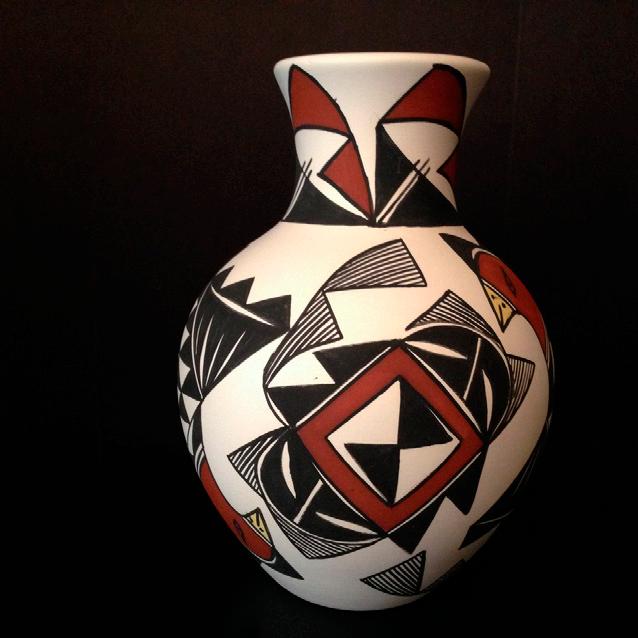




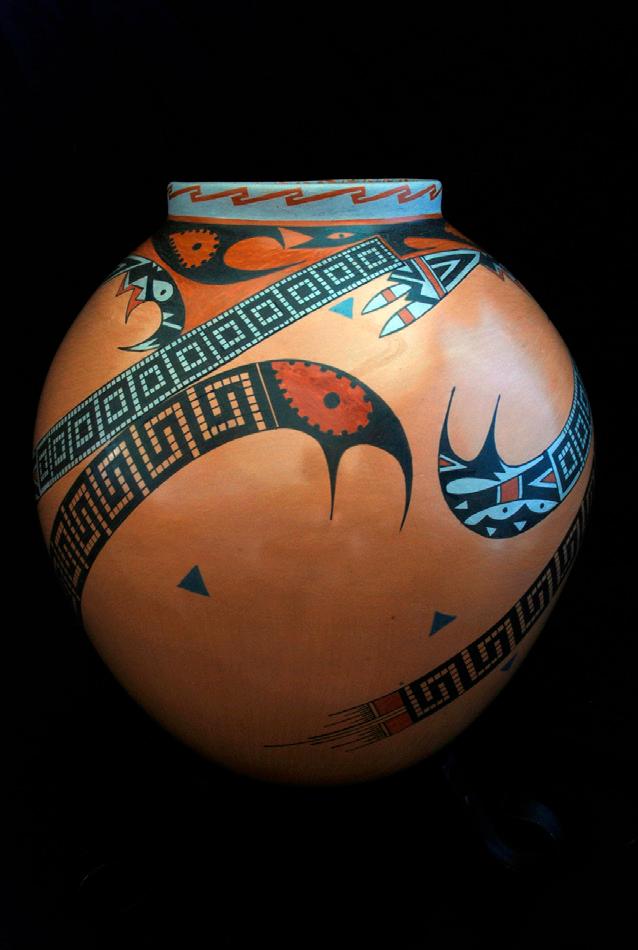

(505) 557-6654 • galleryethnica.com Thursday-Sunday, 10 am–5:30 pm
LOCAL HEROES
An edible Local Hero is an exceptional individual, business, or organization making a positive impact on New Mexico's food systems. These honorees nurture our communities through food, service, and socially and environmentally sustainable business practices. Edible New Mexico readers nominate and vote for their favorite local chefs, growers, artisans, advocates, and other food professionals in two dozen categories. (Winners of the Olla and Spotlight Awards are nominated by readers and selected by the edible team.) In each issue of edible, we feature interviews with a handful of the winners, allowing us to get better acquainted with them and the important work they do. Please join us in thanking these Local Heroes for being at the forefront of New Mexico's local food movement.
THE SKILLET
GASTROPUB AN INTERVIEW WITH ISAAC SANDOVAL, OWNER AND CHEF
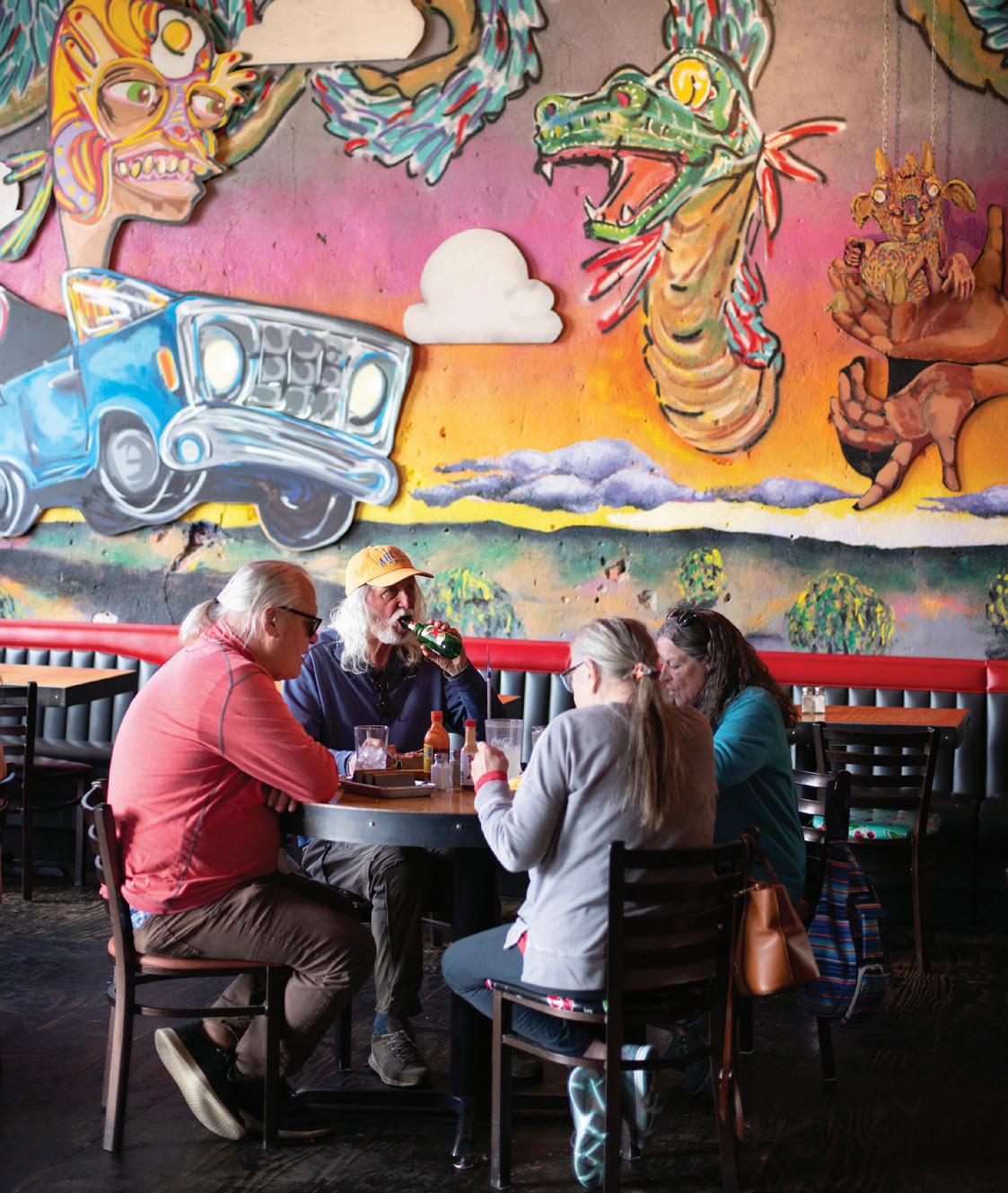

Photos by Douglas Merriam
It began with a three-hundred-pound, three-feet-wide cast-iron skillet. That’s right! Isaac Sandoval cast the skillet during his art school days at Fort Hays State University in Kansas. He’s even cooked in it. Now it hangs above the entrance to The Skillet, a gastropub in Las Vegas, and is its namesake. Most commonly referred to as an “art bar,” the majority of the artwork at the restaurant was created by Sandoval
himself, who grew up working in his parents’ iconic New Mexican restaurant, Charlie’s Cafe and Bakery. “My goal is for The Skillet to be a place where every single one of your senses are activated, a place where visitors are immersed in the environment with bright visuals, lively sounds, wonderful smells, and a genuine good energy,” he says.
6 edible New Mexico | EARLY SUMMER 2023
Left: Tacos and cocktails. Right: Customers in front of mural at The Skillet.

You are an artist, and in February you created a new, permanent installation inside your space in partnership with New Mexico Highlands University. What should people expect to experience when they enter The Skillet these days?
I love to watch people walk in for the first time. Although the restaurant business is strong in my blood, my artistic practice plays a major role in my daily life and at The Skillet. I invited NMHU Media Arts Club to help develop a set of projected animations over the existing murals and sculptures at the restaurant. What they came up with is really exciting and literally brings the room to life. The restaurant was built inside a ninety-nine-year-old building with great natural light, and the best time to see this installation is after sunset.
Your menus are playful, with dishes and drinks that feel energetic and innovative. How do you decide what makes the final cut?
Ultimately, what makes the final cut are dishes that we find delicious and authentic to the restaurant. I like the food to reflect the space—I want to make things that I would get excited to eat and that would make other people excited. It’s also important to me that my staff is excited about the food they serve. I get so psyched hearing the staff talk to customers about their favorite items and be genuinely excited and proud of the food they’re making.
Before your brick-and-mortar space, you ran a food truck. Is there anything you miss about working that way?
I learned so much while operating the food truck. The food truck way
of life is a tough one. Everything needs to be tied down, the crew is usually one or two, which means you’re running every station, and lots of times sales are limited to what you can fit in the truck. It’s worth every ounce of work though.
The scale of the food truck gave me the opportunity to keep the menu small and work with local farmers selling produce and meats, and helped keep it affordable, something I have a difficult time with at the volume The Skillet is currently operating at.
The food truck had a very different energy than brick and mortar. Everything was more “in the moment” on the food truck. There were always some unforeseen circumstances we needed to adapt to. Now, the stakes are higher, planning is more crucial, and I have to anticipate farther into the future than I had to on the food truck.
How are creating food and serving customers similar to creating visual and performance art?


Both art making and cooking go through similar stages—the concept, development, researching, practice, repeating steps over and over again. A burrito, a five-course dinner, and a drawing all take their own time, attention, and care. Cooking on the line is a time when a cook can have the same gratification as an artist creating a work, making something with their hands and bringing an item to completion. The most common factor between the two is that both require time and tons of hard work.
What’s next for The Skillet?
Hopefully, the busiest summer ever, filled with patio cookouts, cocktails, giant joints, and tacos.
623 Twelfth Street, Las Vegas, 505-563-0477, giant-skillet.com
8 edible New Mexico | EARLY SUMMER 2023
Left: Isaac Sandoval, owner and chef. Right: Green chile cheeseburger.
A TRADITION OF BOTANICAL DISTILLATION
Our passion began a quarter century ago with distilling lavender essential oil and botanical hydrosols for our artisanal spa products. Now it has blossomed to include botanical spirits. Crafted by a team of dedicated farmers, gardeners, herbalists, distillers and mixologists, our new western-style gins are made with traditional steam distillation techniques and a blend of botanicals that express the flavor of Los Poblanos’ historic farm and gardens and the essence of the Rio Grande Valley.
Enjoy a signature gin cocktail at Campo, Town and Ranch or Bar Norte in Santa Fe. Available by the bottle at Los Poblanos’ retail locations and purveyors throughout New Mexico.
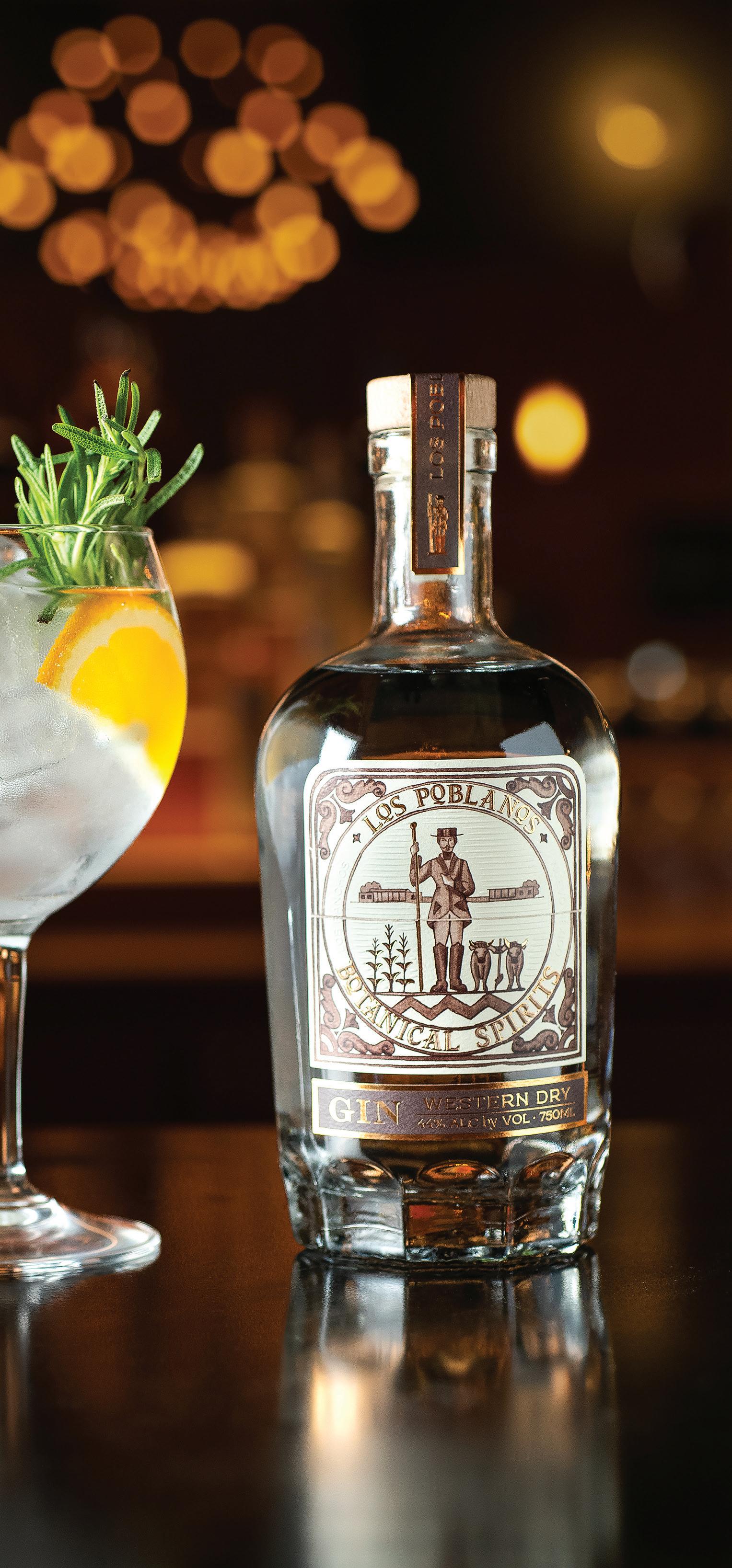
LOSPOBLANOS.COM

SAFE HOUSE DISTILLING CO.
BEVERAGE ARTISAN, SPIRITS
AN INTERVIEW WITH CHRIS LEURIG, MASTER DISTILLER

Photos by Stephanie Cameron
Chris Leurig, Safe House’s master distiller, oversees all distilling activities, manages staff and product development, and designs and engineers all equipment. Leurig also mentors others who are interested in becoming distillers themselves, a role about which he is passionate since returning to the Land of Enchantment. He began distilling in Lewisville, Texas, where he led operations and a production team for mashing, distilling, barreling, and bottling spirits, including whiskey, rum, agave, gin, and brandy. In 2018 he brought his talents back to Albuquerque to found Safe House Distilling Co. The company’s name grew from the building’s former tenants, a financial business. Safe House spirits and canned cocktails are available throughout New Mexico. Outside of work, Leurig can be found snowboarding, building Legos, and trying new whiskeys.
What led you into the world of spirits?
My interest in distilling and spirits started when I was in college, witnessing the booming craft beer scene in Albuquerque, like La Cumbre and Marble. I appreciated the art each brewer put into their work. Although I love craft beer, I had more of a passion for spirits. After I graduated from the University of New Mexico, I relocated to North Dallas to work at Witherspoon Distillery, where I learned the art of distilling. I always knew I wanted to bring this art back to New Mexico, so I was thrilled when this opportunity to start my own distillery in Albuquerque presented itself.
Not to read too much into a name, but what makes Lock Pick a high-desert gin?
10 edible New Mexico | EARLY SUMMER 2023 LOCAL HEROES
Chris Leurig, master distiller at Safe House Distilling Co.

11 EDIBLENM.COM 1318 4th Street NW, Albuquerque 87102 LOSPOBLANOS.COM Introducing Town and Ranch – a downtown destination featuring the new Los Poblanos Botanical Spirits gin, on-site distillation, New Mexican beers, wine and spirits, artisanal market foods and housewares, and our complete line of Los Poblanos lavender apothecary and Farm Foods products.
Lock Pick gin encompasses the true definition of a high-desert gin, perfectly named for our Albuquerque climate. This small-batch craft gin is made in handmade alembic stills from Portugal. The name Lock Pick reinforces our banking theme for all of our spirits. One of four medals awarded to Safe House in the 2022 American Craft Spirits Awards was for your Teller Blueberry Lavender Lemonade canned cocktail. Why canned cocktails, and how does the process of developing one differ from developing a straight vodka or gin?
Although nothing is better than a craft cocktail from your favorite local bartender, canned craft cocktails offer a simple and accessible option for customers to enjoy their favorite Teller spirits or cocktails wherever they are. You can enjoy them camping, snowboarding, on the lake, or even at a family reunion where you don’t want to be. The process of developing canned cocktails is a balance of art and science. While your local bar has fresh produce like limes or oranges, we have to master the art of re-creating this balance of taste, aroma, and texture in an all-natural, ready-to-drink can.
Before you got into distilling, you had a stint as a snowboard instructor at Angel Fire. What’s your preferred elixir after a day on the slopes?


To start the day, nothing is better than a Teller Green Chile Vodka Bloody Mary. The roasted and spicy flavors serve as a great base. After
shredding fresh powder in northern New Mexico, I like to finish the day with a PBR and a shot of whiskey—just to warm myself up, of course. Talk about your expansion plans. What’s next for Safe House, and when can readers anticipate sitting down to order their favorite specialty cocktails again?
We’re proud of what we have accomplished with Safe House thus far, but we are even more excited about the future. We are consistently reviewing expansion options and look forward to growing our community partnerships. Over the last three years, we have expanded our distribution to over seven hundred bars and liquor stores across the state, and we’re not stopping there. Soon our neighbors to the north, west, and east will be able to enjoy Teller Vodka. As for the bar, readers should stay on the lookout for a special announcement we plan to make this summer, including a reimagined tasting room and new spirits for customers to try. Specifically, [it is] something that has been aging since the inception of Safe House over three years ago.
Describe a perfect day off in June. What’s on the menu?
When I get a day off in June, I like to be outside. Whether that is hiking, camping, or even cliff jumping in the Jemez. After a long day, I like to find local restaurants and bars to try for the first time. Lately, I have been attempting to try as many different green chile cheeseburgers as I can. Check back in with me next year for my favorite.
Anything else you’d like to share with edible readers?
Leading up to four years in the Albuquerque industry, we have been overwhelmed with the support we have received from our customers and friends. Although we’re proud of the work we have done, we still have a long way to go.
616 Gold SW, Albuquerque, 505-318-0150, safehousedistilling.com
12 edible New Mexico | EARLY SUMMER 2023
Left: Filling bourbon barrels. Right: Checking the still.

13 CompoundRestaurant.com 505.982.4353 653 Canyon Road Santa Fe lunch • dinner bar • patios
food served with style
photo: Gabriella Marks
SAM COCA, BAR CASTAÑEDA
Photos by Douglas Merriam
Sam Coca started as a dishwasher and line cook at sixteen years old and has been in the industry ever since. “I love the food and beverage industry and the evolution of it,” he says. Beginning at Bar Castañeda in Las Vegas as a sous-chef, Coca became the mixologist and general manager following the restaurant’s shutdown during the pandemic. “I immediately fell in love with being behind the bar. It was like my liquid kitchen.” Although he was born and raised in the other Las Vegas, Coca’s family roots are in New Mexico, and he currently lives in Las Vegas with his wife, Lucinda Coca; their four children; and two dogs. “A dish or a drink can make such an impression that it’s more than just an experience, but an everlasting memory,” Coca adds. What was the first drink you ever mixed, and what brought you from that moment to this one?
The first cocktail I ever mixed was a Tommy’s margarita. I remember trying it for the first time and being amazed at how three simple
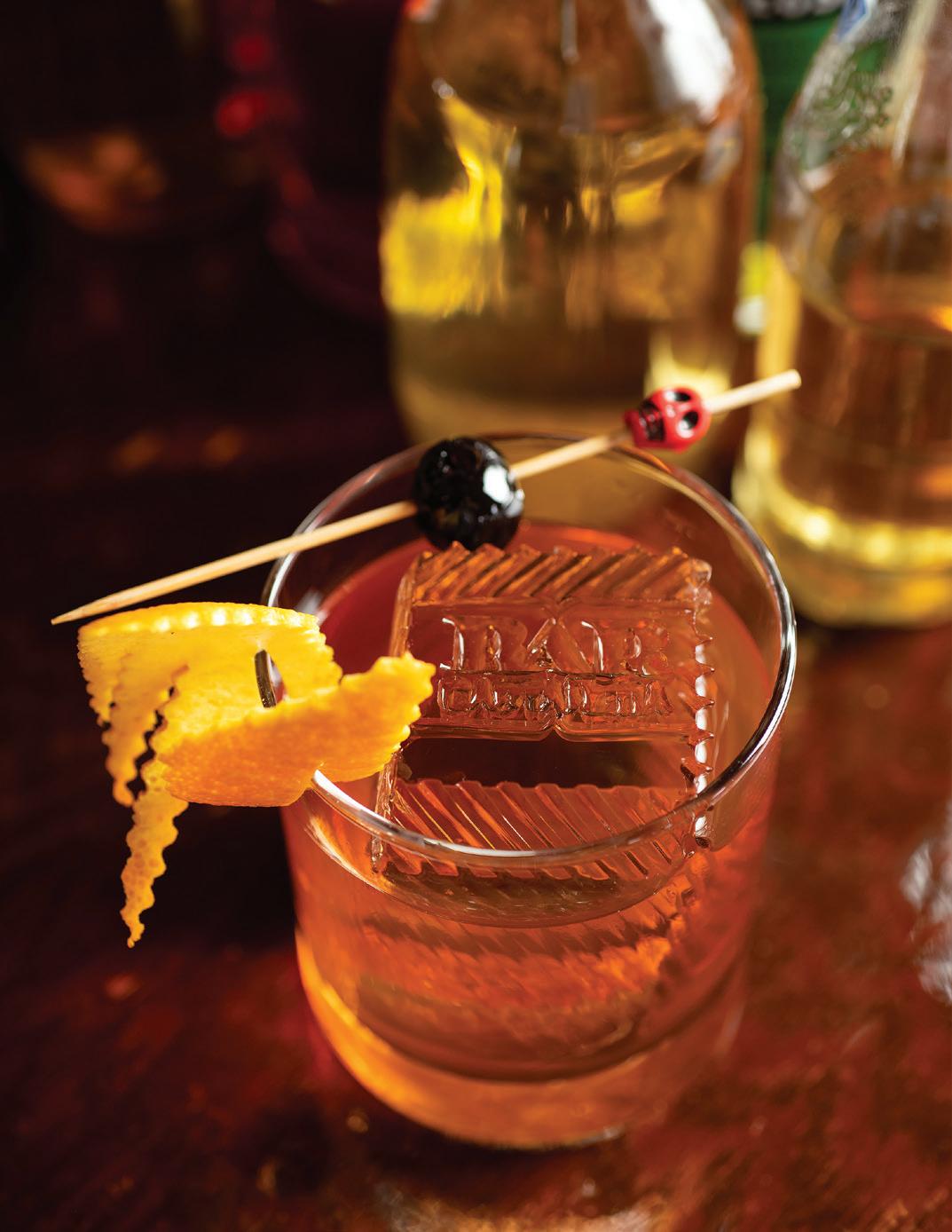
ingredients (tequila, agave, fresh lime juice) in the proper proportions could create such a well-balanced drink. I have been working in kitchens for over twenty years. With all that kitchen experience, the transition to the bar was rather easy for me, and being able to integrate flavors with balance came somewhat naturally.
Balancing flavors is essential to crafting cocktails, but beauty matters too. How do you play to senses other than taste in your own cocktail design?
We taste with our eyes and our nose before our mouth, so appearance and smell are extremely essential. Using different methods like smoking, infusing, and spritzing distinct aromas, the use of citrus, bright colors, fruits, and vegetables, when used together correctly, can be extremely attractive to the eyes and nose, and can make the cocktail not just taste great but look beautiful.

14 edible New Mexico | EARLY SUMMER 2023 LOCAL HEROES
MIXOLOGIST
Right: Sam Coca.
Left: Eagle Rare Old Fashioned. Right: Sam Coca, general manager and mixologist.


Pre-order food and coffee for take-out or dine-in @ Iconikcoffee.com Free parking everywhere Amazing coffee, incredible food. 1366 Cerrillos Rd 314 S. Guadalupe St 1600 Lena St
Do you have a favorite ingredient? Where do you source it?
At the moment I’m really enjoying Altar Spirits Aradia (an aperitivo liqueur) with notes of cherry bark, citrus peel, and osha root. It makes for a delicious negroni. Though we are a fully licensed bar, we try to support as many local businesses as possible. In the past few years, some really amazing spirits and beers have been produced right here in New Mexico and we love to showcase those items on our menus and in our package liquor store.
This award is for mixology, but you’re also Bar Castañeda’s general manager and, according to your Instagram profile, lead dishwasher. What’s the most challenging part of your job? What’s the most underappreciated?
I’m actually the general manager, mixologist, and former sous-chef. The lead dishwasher part was just a little inside joke. I think the most challenging part of the position is managing many different moving parts on a daily basis, like organizing events, helping in the kitchen as needed, bartending, serving, placing orders, etc. Wherever I’m needed, that’s where I’m at during any given dinner service. It’s also the most rewarding, and the dishwashing would definitely be the most underappreciated.
Is it true that a ghost resides at the Castañeda? What do you recommend to guests hoping for an encounter?
The Castañeda Hotel was originally opened in 1898, so there are lots of ghost stories. Historical figures like Theodore Roosevelt, Billy the Kid,
Wyatt Earp, Pat Garrett, and Doc Holliday all frequented this hotel, so you can imagine the kind of stories you’d hear if these walls could talk. I’ve personally only experienced a couple of friendly encounters—the occasional bathroom door opening and toilet flushing. We have had guests send us pictures with strange apparitions, but I think the ghosts are happy to see the hotel bar and restaurant functioning. I feel like the most active space for ghosts would probably be the hotel lobby. That’s where some pretty cool images have appeared in pictures.
How has working with the team at Castañeda influenced your approach to bartending and/or mixology?

Definitely working alongside Chef Sean [Sinclair] and Chef Jeremy [Schmidt] has been the most inspiring kitchen I’ve had the opportunity of working in. When I moved to the bar, I knew drinks had to have the same passion and attention to detail as our dishes. That made me even more excited to produce signature cocktails that would reflect and complement our food.
What (or who) have been three of your greatest influences?
I would say I have two big influences. As I said previously, Chef Sean is a very talented chef, so he has been a huge influence on me wanting to evolve, create, and consistently execute quality cocktails. My other influence would be other craft cocktail bars and mixologists. This industry is a very tight-knit community and I get excited to try new places and new drinks and get ideas.
What kind of food did you grow up eating, and what’s your go-to comfort food? Do you have a favorite food-drink pairing for a late-spring evening?
Growing up in Las Vegas, Nevada, wasn’t as cultural as New Mexico, so we ate a lot of different foods. My mother was an amazing cook, so dinner was always exciting, especially when the family from New Mexico would ship us red and green chile. Enchiladas and huevos rancheros are two of my favorites. As a kid I really enjoyed Italian food, so anytime we went out for dinner, and it was available, shrimp Alfredo it was. These days I enjoy a nice steak with calabacitas, but I love trying new dishes. One of my favorite dishes and cocktails here at the Bar Castañeda is our lemon ricotta ravioli paired with my personal signature cocktail, the Caterpillar Crawl (mezcal, vodka, agave, lime juice, green Chartreuse, and a piece of muddled poblano pepper). This cocktail is smoky, citrusy, and boozy all at the same time, so it does really well to cut the fats in the ricotta and complement the lemon flavor.
Anything else you’d like to share with edible readers?
Yes, I’d really like to attribute the award to everyone that helped and supported our cause to feed displaced families and all the first responders involved in last summer’s fires. That includes our fellow restaurants in Las Vegas and throughout New Mexico, many of whom are also edible award winners or former award winners, and who came together with us in such a huge way. Generosity came pouring in from everywhere at a time when people were losing everything. I’m proud of our tiny community and our state for stepping up in such a difficult time.
524 Railroad Avenue, Las Vegas, 505-434-1005, kinlvnm.com
16 edible New Mexico | EARLY SUMMER 2023
Caterpillar Crawl cocktail.


PALOMA RESTAURANT,
SANTA FE
AN INTERVIEW WITH MARJA MARTIN, OWNER AND GENERAL MANAGER, AND NATHAN MAYES, EXECUTIVE CHEF
Photos by Stephanie Cameron
“We are not a fine dining restaurant. Neither are we a taco truck. I like to think we reside right in the middle of these two genres, which creates a sweet spot unique to Santa Fe,” says Paloma’s owner and general manager Marja Martin. “Our menu is inspired by our great love of Mexican cuisine, culture, and hospitality.” Entering their seventh year, Paloma features a simple menu serving fresh, lively dishes that use as many local ingredients as possible. Their beverage program focuses on quality agave spirits that are produced traditionally and as sustainably as possible. Almost every component of its dining room, from wallpaper to metal planters, is the work of local artists, craftspeople, and fabricators. Paloma honors the vibrant, diverse food culture of Mexico in an artfully designed space.

Santa Fe’s restaurant scene offers cuisines from all over the world, as well as an abundance of spins on Mexican and New Mexican cooking. Why choose to offer Mexican-inspired here, and what does that mean to you?

Mayes: New Mexico is just that, a landscape inspired and influenced by the history and culture of Mexico. I am inspired by the agricultural components woven through the community of greater New Mexico. The chiles, the maize, and the flavor profiles are ingrained into the identity of the state. There is such a rich culinary history that links New Mexico to Mexico, so inspiration is everywhere.
How do you decide whether or not to source something locally? What are some of the considerations involved in sourcing staples like corn versus local or seasonal ingredients?
Mayes: The simple rule is that if it is local, we will use it in place of any bulk ingredient from California, Arizona, or Mexico. During the
18 edible New Mexico | EARLY SUMMER 2023 LOCAL HEROES
Left: Mushroom Sopecitos with almond salsa. Right: Tuna Tostaditos with salsa macha and crispy scallions.

OLD TOWN ALBUQUERQUE seasonsabq.com 505.766.5100 ALBUQUERQUE HEIGHTS savoyabq.com 505.294.WINE HISTORIC NOB HILL zincabq.com 505.254.ZINC (9462) Now Open!
winter, we maintain a steady supply of potatoes, radishes, lettuces, root veggies, black beans, and whole pigs. I always say our menu tastes the best in mid-August, when our peppers, tomatoes, and summer veggies are all local and bursting with flavor. We usually change to our warmer weather menu in May and slowly fill in the local ingredients. This way we can build a menu and slip in the local items once they are abundant— for example, our Squash Blossom Quesadilla with blossoms from Jason Klemmer, our Tres Leches with stone fruit from Freshies, and our Mixta Salad that becomes a market bounty in the warmer months.
How does Paloma support the preservation of New Mexico’s agricultural traditions, and why is that important to you?
Mayes: I think the best way to support agricultural traditions is to purchase as much from small farms as possible. It not only feels good to contribute to a small business (like our own), but ten out of ten times, the product tastes and looks better. It’s a way to have a conversation with the cooks and the guests who dine with us. It is a delicious way to explore the history as well as the future of farming and food in New Mexico.
What are some of your favorite vegetarian or vegan dishes? How do you see tastes changing as far as meat consumption?
Mayes: Cooking and eating plants has always been second nature to me. My father was the chef and owner of one of the first vegetarian restaurants in Austin, Mother’s Cafe, and my parents raised my siblings and me on a mostly plant-based diet; beans were the main source of protein, with some fish and shellfish every once in a while. It has been cool to see more and more people turning to plants as a source of not only nutrition but flavor. At Paloma, our Cauliflower
Rostizado is one of my favorites. We marinate and sous vide cauliflower before searing and roasting. Just like a piece of meat, we often baste the cauliflower with fat to finish cooking. We have also played with substituting vegetables in ceviche-style dishes such as our Beet and Melon Aguachile.
Your staff’s friendly vibe is a big part of the experience of dining at Paloma. How do you approach recruitment and retention at a time when restaurants are struggling to keep good people?

Martin: I am very proud of the staff retention we have in the front of house at Paloma. Many of my current staff worked through the pandemic with us; a few have been with us since 2017. Our beverage director, Andrea Duran, continues to amaze me with her creative, can-do attitude, problem-solving skills, willingness to research anything, and attention to detail. Both of my floor managers, Nicolás Garcia and Rita Goodrich, bring warmth, personal attention, and true love of hospitality to the floor.
I encourage my staff to be themselves and to have fun at work. For example, everyone gets to dress how they like, which I think contributes to the lively and artistic vibe at Paloma. We also share a family meal together every day prior to opening. Our staff being proud of and inspired by our food and drinks is truly the secret to our happy vibe.
Mayes: We have been fortunate to maintain a core group of people in the kitchen. While raising wages is a huge help, giving the staff a reason to come to work every day is equally effective. I call on kitchen staff all the time for their opinions and ideas for new dishes. I like to involve cooks in the process of breaking down whole animals and chatting with farmers when they drop off their produce. I’ve learned, and am still learning, that a sense of community and purpose is very important to keeping people motivated and able to take pride in their jobs.
What do you enjoy eating on your days off? Do you ever sample other local restaurants’ dishes, and if so, where do you like to go?
Martin: My mainstays are Bread Shop, Dolina, Horno, La Boca, and Joseph’s Culinary Pub. I also enjoy Altar Spirits and Palace Prime for creative cocktails and snacks. We are thinking a lot about what it means to be good neighbors and a supportive industry community. I love where we are located, so near to many of our favorites. I also love eating in Albuquerque, particularly Mesa Provisions and Oni. At least once a month, I plunge into very creative cooking at home with my friend Marijke Uleman of Cocoon. We have been playing with immersive single-ingredient dinners. Cooking in this way gives me a lot of opportunity for creative expression.
Anything else you’d like to share with edible readers?
We have a sister restaurant right next door that was founded on the same principles as Paloma. Using the freshest and highest-quality ingredients we can find, Esquina Pizza serves wood-fired pizza, creative salads, and a fresh rotation of wine and beer.
401 S Guadalupe, Santa Fe, palomasantafe.com
20 edible New Mexico | EARLY SUMMER 2023
Nathan Mayes, executive chef, and Marja Martin, and general manager.
VEGETARIAN KITCHEN
Fine International Vegetarian and Vegan grab and go including ready to serve complete meals.

Environmentally Packaged Fresh and Nutritious Food


ALBUQUERQUE
La Montañita Co-op–Nob Hill & Rio Grande

Lowe’s Market on Lomas
Moses Kountry Natural Foods
Silver Street Market
Triangle Market in Sandia Crest
Lovelace Main Hospital
Heart Hospital of New Mexico
Sandia National Labs
UPC at UNM
UNM Hospital in Cafe Ristra
Presbyterian Rust Hospital - Rio Rancho
INTEL
Nusenda Corporate Office
Presbyterian Cooper Center
UNM Campus - Mercado, SRC, Cafe Lobo
My Market - Mesa del Sol - Netflix Studios
Frontier Market - Corrales
Lantern Ridge Market - Sandia Park
PLACITAS
The Merc
SANTA FE
La Montañita Co-op
Kaunes Market
Eldorado Supermart at the Agora
Christus St Vincent Hospital
Pojoaque SuperMarket
LOS ALAMOS
Los Alamos Cooperative Market
Los Alamos National Laboratory
ESPAÑOLA
Center Market
Presbyterian Hospital
TAOS
Cid’s Market
GALLUP
La Montañita Co-op
SOCORRO
NMTECH - Fire and Ice Cafe
21 EDIBLENM.COM
MATA-G.COM
116 Amherst Dr SE, Albuquerque, 505-266-6374
CATERING AVAILABLE 505-266-6374 MATA-G.COM
VIVÁC WINERY
BEVERAGE ARTISAN, WINE AN INTERVIEW WITH MICHELE PADBERG, CO-OWNER

Photos by Douglas Merriam
Vineyards near six thousand feet, four owners in one family, a deep commitment to community, and living in the oldest winegrape-growing region in the United States—that’s Vivác Winery. Pronounced vee-vok and meaning a high-altitude refuge, Vivác began with the intention of making dry European-style wines in New Mexico. The winemakers are brothers Jesse and Chris
Padberg, who grew up on an apple farm in northern New Mexico. Their wives, Michele and Liliana Padberg, share the business management for the family’s work, from the tasting room and distribution to marketing and wine clubs. All four Padbergs are certified sommeliers whose love for travel expands their professional and personal passions.
22 edible New Mexico | EARLY SUMMER 2023 LOCAL HEROES
Jesse, Michele, Chris, and Liliana Padberg at Vivác Winery tasting room in Dixon.
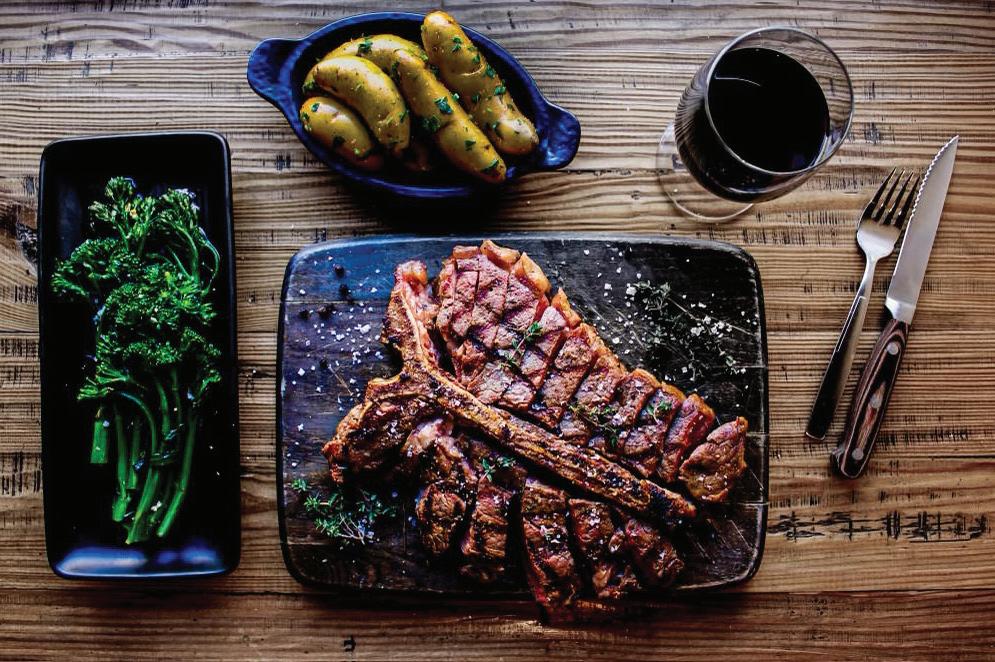
Re stau r ant , Ba r , Li v e E nt er tain me n t
You opened your tasting room in Dixon twenty years ago. How have your wines evolved over that time? What about your own tastes, and those of New Mexico wine drinkers?
When we started the winery twenty-five years ago, there was a steep learning curve. Jesse and Chris realized quickly that they needed formal education from the University of California, Davis [known for its viticulture and winemaking certification programs]. Luckily, by the time we opened the tasting room in 2003, we had four solid wines to present. Over the years, our winemakers have continued to study advanced wine chemistry, yeast strains, and deep dives into elements of fermentation in order to craft better wines with each vintage. We had a lot of naysayers early on, the belief being that the New Mexico wine drinker wouldn’t like dry European-style wines, but what we found was the opposite! We have been incredibly fortunate to have the love and support of New Mexicans. Their sharing of our wines with friends and family across the country has been a big part of the incredible success of our wine clubs.
Vivác is a family affair. Is there a magic formula for balancing your various roles without creating discord?
We recognize that we have a rare gold mine with our dynamic foursome. Jesse and Chris work side by side every day taking care of the winemaking and viticulture. Amazingly, when they get home, they still get on the phone to chat with each other! Liliana and I both joined the team in 2001, Lili having moved to New Mexico from her home in central Mexico, and myself foregoing a move to New York City to stay here. The four of us put everything we had into starting the winery. That meant working other jobs to fund it, living in the small back rooms of the house Jesse and Chris grew up in, and living on food stamps well after having our first children. Somehow, looking back over those really tough first years, we reminisce about how much fun we had. The four of us have a similar aesthetic, we recognize the same issues, and have the same goals. It is truly magic that all these years later, we are all still in perfect step.
Who’s your favorite local/national/international authority on wine?
Any recommendations for readers intimidated by winespeak?
LOL, well, us!
My passion is to teach people how to appreciate wine on a real-life level, to specifically take the snob out and make it relatable. Jesse and I are both advanced sommeliers working toward mastery, yet I teach classes at the American Wine Society national conferences with topics like “Yes Way, Rosé,” where I introduce people to new rosés while explaining the history of and reasons for its popularity. Another class is “Chocolate & Wine, Need We Say More?,” where I create pairings to open people to the possibilities while also explaining the chemical process happening in your brain when you combine these two substances. I also host wine events around the world.
We need to give credit to Claude Robbins of the International Wine & Spirits Guild in Colorado. He is, simply put, a legend. In the greater wine world, Andrea Immer Robinson is a master of wine who makes wine fun and was a huge influence on how we wanted to teach people to love wine.
Why wine kegs?
We are dedicated to doing our part for the environment. We organically farm our estate vineyards, and we partner with Eden Reforestation Projects to plant a tree every time someone buys a bottle, creating a carbon-neutral footprint for our winery. We utilize kegs to cut down on waste. Wine never goes bad in a keg. With bottles, slow sales always lead to waste, and it also means a high cost to the customer. Wine kegs allow you to have our international award-winning wines, made entirely from New Mexico grapes, at incredibly affordable prices. And we offer refillable growlers at our tasting room.
Describe one of the most memorable meals you have had while traveling internationally.
We LOVE to travel! In fact, part of the mission statement when starting the winery was to have our two families capable of doing all the jobs so that one family could travel while the other held down the fort. Travel is not only important to our theories on raising our children but a huge part of our education for the winery. Spending time with winemakers around the world is invaluable.
Chris has talked about the incredible flavors he fell in love with in Thailand, Vietnam, and Cambodia. Lili loves all kinds of international dishes, but can’t help missing the phenomenal meals her mom makes back at home in Aguascalientes, Mexico. Jesse and I have a special place in our hearts for Italy, from the pappardelle with cinghiale at our wedding in Tuscany to the oryx dipped in fontina fondue in Aosta.
What is a local food issue that is important to you? Why?
Keeping the land agricultural is very important to us. Keeping water rights local and teaching our future generations to nurture the land and be sustainable is a goal of ours. We love working with local chefs to create amazing experiences that fulfill your hunger for nourishment on many levels. There is nothing like the exhilarating moment a wine and morsel combine to blow your mind, and knowing it was all sourced locally makes it even better.
2075 State Hwy 68, Dixon, 505-579-4441, vivacwinery.com

24 edible New Mexico | EARLY SUMMER 2023








Chocolate Handcra�ted Bean to Bar 8114 Edith NE ■ Albuquerque 87113 eldorachocolate.com ■ 505-433-4076 Call for tour information WEDNESDAY–SUNDAY, 5–9PM 3120 Central Ave SE, Albuquerque mesaprovisions.com MESA PROVISIONS Reservations required 505.494.5264 at The Jam Factory 3427 Vassar Dr NE 87107 wed-fri 12pm - 7pm Sat,sun 11am - 7pm NOW OPEN!
SHARING SPACE
IN YOUR BACKYARD HABITAT
Words and Photos by Marisa Thompson
Supporting climate-stressed wildlife in our urban landscapes is as essential as it is approachable and rewarding. To paraphrase restoration ecologist Dr. Brianne Palmer, this type of work/hobby/play is also an act of applied optimism.
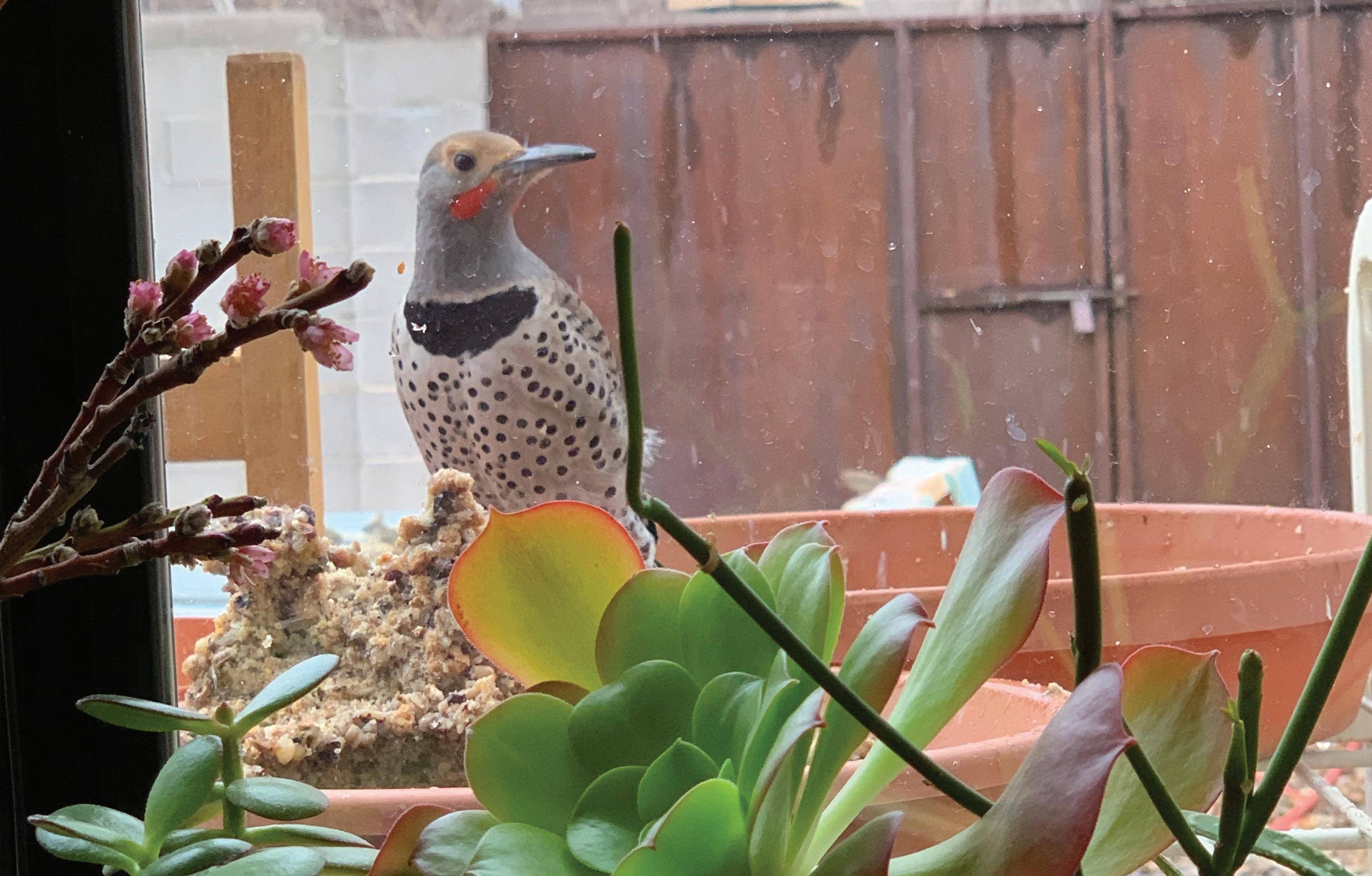
“Every little bit of habitat counts,” says Laurel Ladwig, the ABQ Backyard Refuge Program director at the Valle de Oro National Wildlife Refuge. “We really want to get the idea of sharing space out there. Not everybody realizes how much you can do for our wild neighbors and how easy it is.” This popular backyard habitat program is not limited to Albuquerque; it extends across the state and has several levels of habitat commitment so that even those with a container garden on a patio or balcony can qualify. “It really does help—especially with pollinators—just having a little place to stop over before they get to another, larger spot of habitat.”
Food, shelter, and water. That’s it. These are the essentials.
Food: Most of us probably think first of birdseed when considering food for backyard wildlife. Birdseed is certainly a great option. Highquality nyjer seed, also called thistle and usually presented in a socklike mesh bag or feeder with tiny holes, is a sure way to attract small finches. I specify “high quality” here because nyjer seed has a short shelf life and the finches in my yard definitely prefer the good stuff. Black oil sunflower seed is my main go-to for other birds, like the northern flicker. And ladder-backed woodpeckers return year after year to snack on woodpecker cylinders.
For those of us who struggle to keep feeders refilled, plants are even easier! Of course they will need regular watering, particularly during establishment. In “Designing Your Habitat Garden,” a recent webinar in the New Mexico State University gardening series Ready, Set, GROW!, local landscape designer and garden writer Judith Phillips suggests several species that are climate-ready and wildly popular with
26 edible New Mexico | EARLY SUMMER 2023 TOUCH AND GROW
Northern flicker in March, Los Lunas, taken through the author’s kitchen window.






Garduño’s at Old Town in Hotel Albuquerque Open Daily from 7am - 11pm 800 Rio Grande Blvd. NW | 505.843.6300 | HotelABQ.com
The garden patio at Garduño’s at Old Town in Hotel Albuquerque
birds and pollinators. Examples include Utah serviceberry, wolfberry, prickly pear, and broom dalea. “Don’t kill them with kindness!” Phillips warns that we tend to overwater our desert-adapted landscape plants, and broom dalea in particular. She also suggests providing food sources throughout the seasons. “Create a buffet for diverse insects, birds, and animals at different life stages. . . . If you want butterflies, that means supporting them in their caterpillar stage too.”
If you’re curious about creating a hummingbird haven in your yard, the book Hummingbird Plants of the Southwest by Marcy Scott is a great start. On top of excellent details about 120 hummingbird plants for our region, the New Mexico author profiles the fourteen hummingbird species found in the Southwest and provides precise information on how to create prime hummingbird habitats. “For beginners, especially, penstemons are great starter plants for the hummingbird garden and, given a mostly sunny spot and good drainage, they are easily grown most anywhere in the Southwest.”
Shelter: Phillips recommends creating “layers of plantings for roosting and nesting, from tree canopies to organic mulch and bare ground [because many native bees are ground nesting].” Species that she highlights as shelter for wildlife include screwbean mesquite, chocolate flower, Apache plume, desert marigold, and desert four o’clock.


Phillips notes that desert willow is another important plant for both shelter and food. “Hummingbirds work the bottom part of the tree and orioles . . . the top, sometimes sharing at the same time,” she says. Also, “Boulders are great habitat for lizards—and moisture condenses around the edges, rewetting the soil and supporting plants nestled alongside.”
Water: Many of us overlook the importance of water. Early on in my home landscape journey, I talked myself out of having a water feature of any sort because I live within a mile of the river and thought it unnecessary. I was wrong. That second winter, when I’d barely started getting interested in backyard birding, I asked Santa (a.k.a. my mom) for a feeder. Santa and my aunt sent fun bird feeders, and a birdbath too. Within a few days, little birdies were flitting around the newest
spot in town. My yard became a mini mecca. And later, during the hottest part of the summer, a gorgeous hawk would occasionally take a midday soak in that same small birdbath from Santa.
Moving water is the next step, as it attracts more diversity. Plus, adding an agitator is fun. The small floating solar water fountain pumps work great, even in smaller birdbaths. Just be sure to adjust the nozzle so water doesn’t splash out without being replenished.
If this still seems like a lot to take on, consider the other resources in your vicinity and focus on the one element that might be lacking. Finding and filling a resource vacuum is a great way to make a big impact with less input. Perhaps the person next door already has established trees and shrubs that offer excellent shelter but they don’t feed the birds regularly. Or maybe they have beautiful flowers in spring, but not much that blooms into the fall. Late-season sunflowers and marigolds offer great forage for fall birds and a host of insect friends. And any time of year is a good time to try a simple tray of water that you pour out, clean, and refill every few days. Thirsty wildlife will be grateful.
Here are a few more tried-and-true tricks from my own habitat adventure. Place some backyard wildlife features in spots that you can see from inside your house. Birds dining at the feeder suctioned to my kitchen window offer welcome distraction during dish duty. Also, try a hummingbird feeder with a perch. These busy bodies may not need to rest while drinking nectar, but they’re much easier to photograph while sitting still for a split second. When the weather gets quirky and takes a surprising turn, like a light snow or rain on an otherwise clear day or just before a windy storm sweeps in, look out your window or step outside for a moment. Those are the times when bird activity in my yard really escalates. It’s as though they’re all surprised and excited too.
I’m still wowed and still learning three years in. Sharing my backyard with local wildlife continues to bring joy and wonder. Like most hobbies that help you interact with the wonderful natural world around us, backyard habitating is, well, habit-forming—but in the best possible way. I’m excited to hear what you’ll discover too.
28 edible New Mexico | EARLY SUMMER 2023
Left: Swallowtail butterfly on peach blossoms in April, Los Lunas. Right: Mantis in October, Los Lunas.
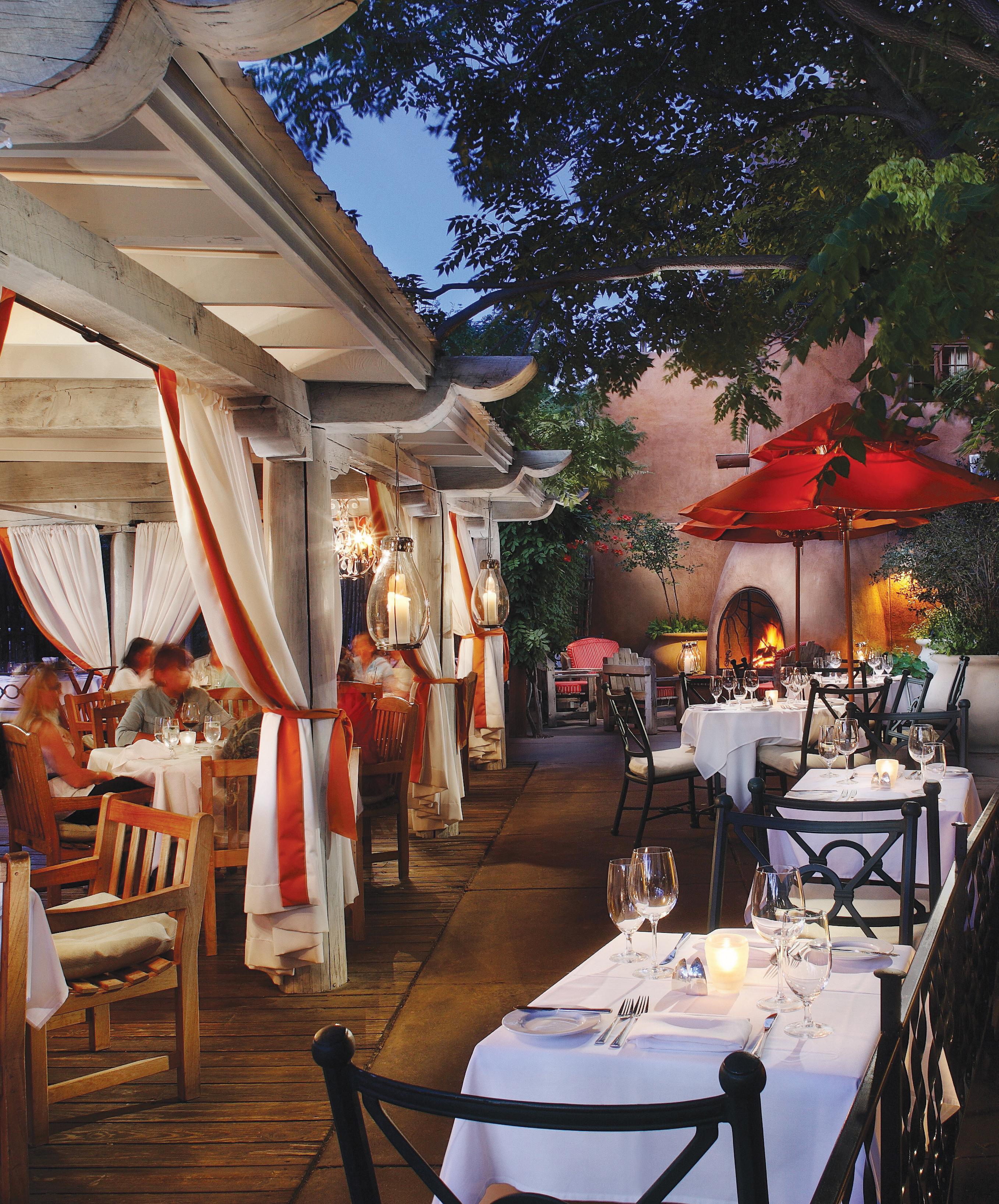
Located at Inn and Spa at Loretto 211 Old Santa Fe Trail | 505.988.5531 HotelLoretto.com
FOOD FOR THOUGHT
THE ART OF PRESENTATION
Words and Photos by RoseMary Diaz
“Keep it simple yet expressive,” advise the authors of “The Plating Manifesto.” Pictured here: dinner setting with lamb chops with red chile raspberry glaze, green and white salad (arugula, brussels sprouts, celery, green apple, pear, fresh dill), and bread.
Extravagant food presentations have been part of the culinary arts story for centuries. In ancient Greece and ancient Rome, affluent nobles staged elaborate feasts that indulged the exotic and seemingly boundless tastes of courtly society. Offering splendid arrays of virtually every gourmet possibility of the time to the well heeled and powerful, these over-the-top displays, replete with crystal, silver, gold, and ivory service, showcased the wealth and status of the host. Excess was the name of the game.

Medieval banquets were no less impressive, awing guests with vast assortments of delectables, including sculpted foods, molded jellies colored with spices and vegetable-based distillations, and baked creations from which live birds were expelled when cut open.
In the early nineteenth century, French chef Marie-Antoine Carême, known professionally as Antonin Carême and considered by some to be the world’s first celebrity chef, introduced the art of plating to the privileged milieu of Napoleon Bonaparte. The display of food, perhaps most notably pastries, quickly became the focal point of the formal dining experience among the elite of his era. Carême elevated the culinary experience to near performance art and his ideas would eventually become templates for presentation in modern haute cuisine. His penchant for decadent presentation was reflected in his fanciful techniques, where placement and color were of utmost importance, and his commanding pièces montées, table decorations sculpted in sugar, were often part of the culinary scape and splendor.
30 edible New Mexico | EARLY SUMMER 2023 THE PLATE





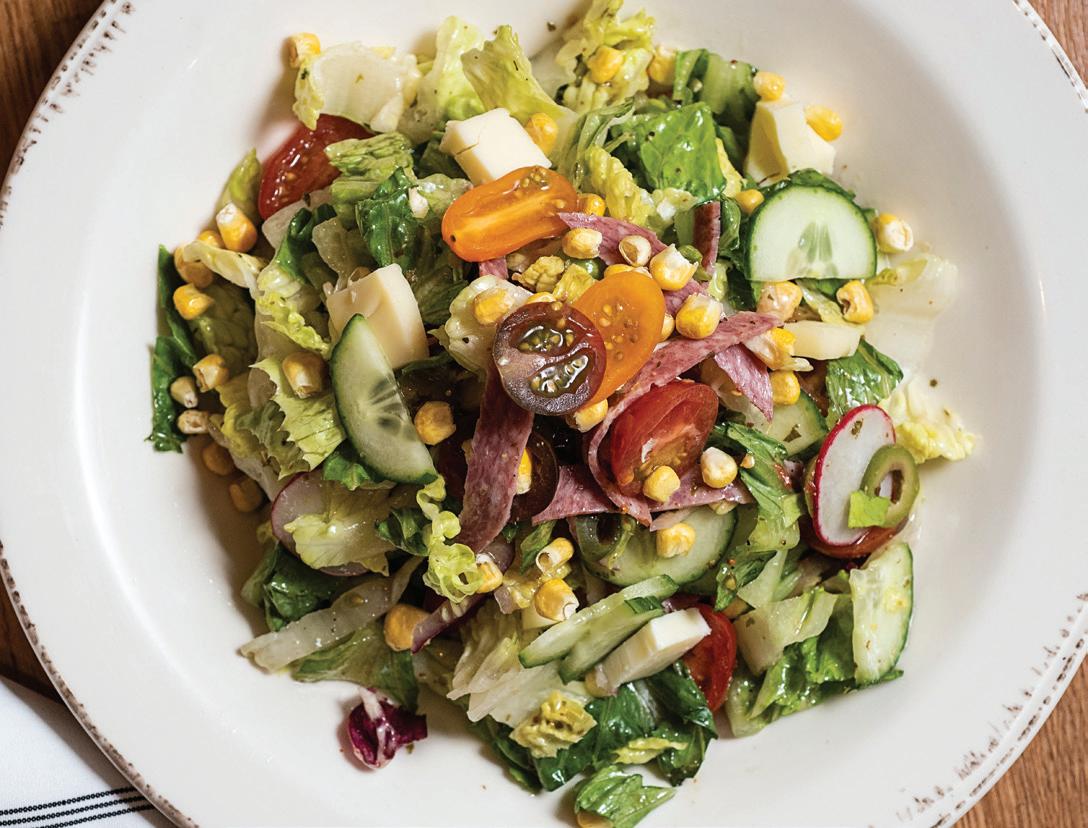



Susan’s Fine Wine and Spirits It’s Rosé season and we have the largest selection in town! 632 Agua Fria Street | 505-984-1582 sfwineandspirits.com | Mon - Sat 10am - 7pm Now Open for Lunch! Fresh Italian Kitchen 505.780.5279 • RusticaSantaFe.com
2574 Camino Entrada, Santa Fe Across from our sister restaurant: The Ranch House
The twentieth century brought even greater emphasis to plating, which began to move away from the long-employed method of piling various foods onto a single dish. More thoughtful arrangements were now en vogue, with color and geometry lending balance and order to the plate and, by extension, to the general atmosphere of the table. In the latter half of the century, nouvelle cuisine, influenced in part by the more minimalist approaches found in the time-honored Japanese traditions of bento box and kaiseki design, ushered in an era of simpler, yet exacting, styles of plating and presentation.
Today, fine dining is a fusion of this culinary backstory, with Carême’s elaborate plating and the spare style of nouvelle cuisine and kaiseki both influencing the innovations and aesthetic preferences of contemporary chefs and food connoisseurs.
In their article “The Plating Manifesto: From Decoration to Creation,” Ophelia Deroy and coauthors assert an approach to plating that diverges from the “more functional and decorative purposes of plate ware, and puts experiments in visual presentation at the heart of modernist culinary expression.”
The manifesto also notes that the best food presentations are likely to bear on all three key components of pleasure: expectation, experience, and memory. That is, a successful presentation is informed by the expectations of the diner upon their initial beholding of the culinary offerings, the experience of indulging in them should engage a sensorial response, and the setting should either evoke a memory already in place or create or inform a new one.
As the culinary arts become more individually expressive, so too has presentation. Efficiency of form and function are no longer the only considerations when it comes to entertaining with food—creativity and a touch of personal flair have also become hallmarks of haute cuisine. Many top chefs are drawing inspiration for their food presentations from their layered culinary and cultural heritage. Vietnamese
American chef Jack Lee created a gourmet version of the humble egg roll, which he tops with sevruga caviar and gold leaf and pairs with a fresh raspberry and sauvignon blanc dipping sauce. Santa Fe chef, author, food historian, and James Beard Foundation Award winner Lois Ellen Frank serves many of her traditionally inspired Native American recipes in handwoven baskets set upon handloomed Navajo textiles.
Here are a few things to consider when setting a memorable table or buffet:
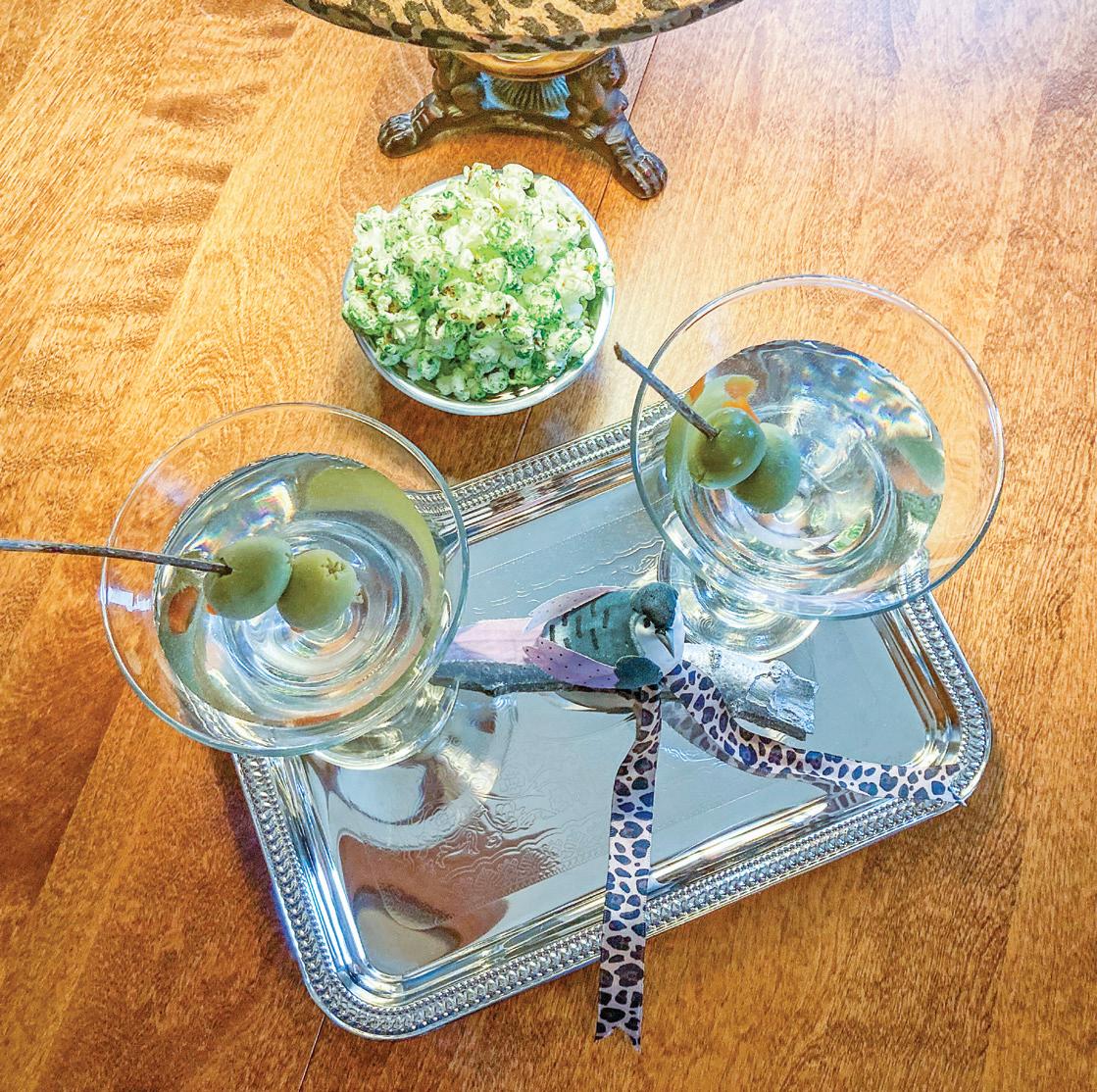
• Highlight the main ingredient to create a notable first impression.
• Plate clockwise and serve an odd number of food categories.
• Balance color, variety, portion size, and nutritional value.
• Focus on color arrangement, balance of textures, contrasting tastes, and ease of eating.
• Match garnishes and decorations to the table’s theme.
• Keep it simple yet expressive.
And keep in mind that plating should not be seen merely as decoration but as an integral part of the multisensory eating experience.
The arrangement of place settings is also an opportunity to indulge one’s unique sense of style. Though there are rules of service placement to be observed when setting a table, especially for formal occasions, the possibilities are virtually endless when it comes to dinnerware, glassware, serving utensils, centerpieces, and the like. Fruit and dessert service need not be confined to conventional forms of presentation, but instead might be offered in fun and unexpected ways that enhance both the table and the conversation.
As with any artistic endeavor, finding one’s own voice when it comes to culinary entertaining may take some time and a bit of practice. But for the novice and the professional chef alike, the table can serve as a canvas of sorts, upon which to create a tasteful and tasty masterpiece in full, living color.

32 edible New Mexico | EARLY SUMMER 2023
Using long-loved or newly acquired treasures can make for memorable settings. Left: Birthday table with Sleeping Beauty cake, dill-garlic popcorn, and sweet rides. Right: Martini service.
Can a HOT DOG CHANGE the World?









OUR SALMON HOT DOGS ARE DELICIOUS, HEALTHY, AND SUSTAINABLE IN EVERY BITE!







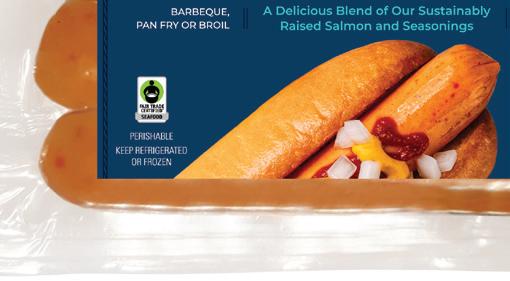




Find Kvarøy’s salmon hot
in the frozen section of the fish and seafood department at Whole Foods Market. Find a store near you
dogs
of
Proud supporter
FRONT OF HOUSE
Romancing Home
INSIDE THE LOVE APPLE AND MANZANITA MARKET
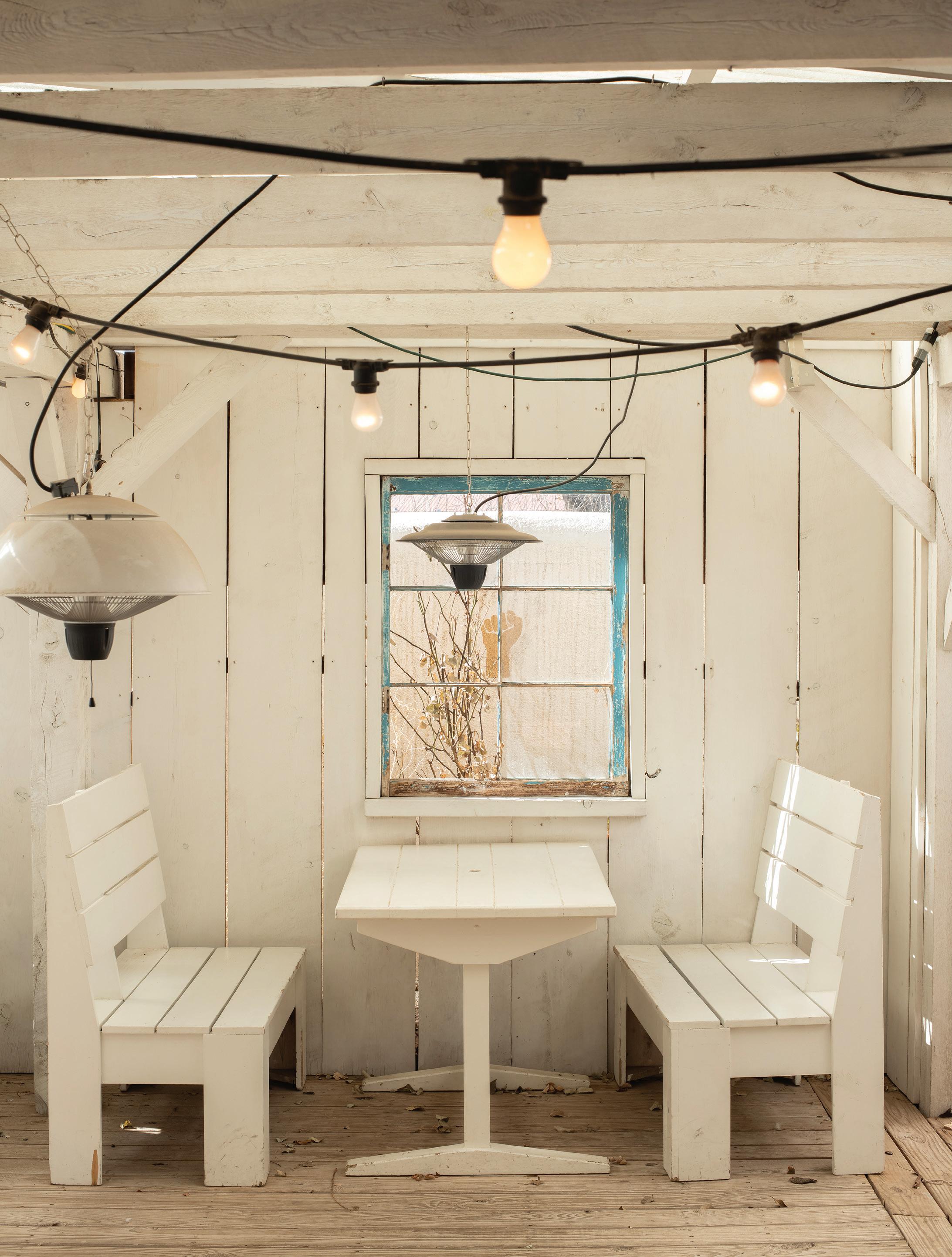 By Mariko O. Thomas
Photos by Douglas Merriam
By Mariko O. Thomas
Photos by Douglas Merriam
The first time I went to The Love Apple was on my twentyfifth birthday. I was a graduate student and was living most of the time up a massively potholed dirt road with no running water. I wore a slightly ripped secondhand black dress and red lipstick that I think I had gotten for a high school graduation gift. I drove the winding way up to Taos and entered what felt like a magical vigil. The white adobe walls cradled me in the flickering candlelight, and the creak of the wooden floors under my heels seemed to say “I think it’s sweet you dressed up
but you didn’t have to,” and from my perch on a worn wooden chair on what was once an altar, I surveyed the space and had never felt more held by the metaphorical arms of a restaurant. A giant painting of rumpled white sheets graced one wall. When the light hit it one way, it was a sensual portrait of post-rising, the sheets remembering warm bodies that had been there a moment before. When the light hit it another way, it was the most generous image of calm I had ever seen. I remember that I ordered tacos (the cheapest item on the menu at that time)
34 edible New Mexico | EARLY SUMMER 2023







FRIDAY • JUNE 2 • 4-7PM Come see & celebrate the completed SEA OF LIFE MURAL by Denise Weaver Ross The Next Best Thing TO BEING THERE —An extraordinary SHOP— OPEN WEDS-SUN: 12–4PM, 1315 MOUNTAIN RD NW, ALBUQUERQUE, NM WWW.BEINGTHEREABQ.COM SUNDAY • JUNE 11 • 1:30-3:30 PM • Poetry by GAYLE LAURADUNN on the Patio ROASTERY | TASTING ROOM | COFFEE BAR 1 2 0 8 R I O G R A N D E B LV D N W, A L B U Q UE R Q UE • C U T B O W C O FF E E . C O M Agua es Vida café es amor
and one glass of wine, and despite the phenomenal imposter syndrome I carried eating at a nice restaurant at that age, I felt welcome.
This is the magic of Jennifer Hart’s restaurants. Both The Love Apple and her newer project, Manzanita Market—a counter-service café on the plaza featuring breakfast, simple sandwiches filled with cured meats and house-made spreads, and bone broth soups—are what I can only call a nourishing embrace of a space. Both restaurants have a clean, simple aesthetic, but not in the vein of Swedish modernism, where spilling something feels like an act you might be reprimanded for. Rather, it is obvious that they were created with intentional, though slow, choices, shaded with a pinch of random opportunities. There is obvious care but also a lack of pretension in Hart’s commitment to local sourcing, the sheer rainbow of colors of the foods served, and the handmade pieces and recycled and refurbished finds adorning both spaces. The community is present in both buildings, whether it is the line of coffee drinkers smoking and chatting along the wall by Manzanita Market’s front door or the vegetables and meats coming to The Love Apple from places you could point out on a map if you’re from around here.

The Love Apple (pomme d’amour, as the tomato is sometimes called in French) is situated in what used to be Placitas Chapel, a high-
ceilinged though tiny adobe church with creaking floors, whitewashed curving walls, and the exposed vigas New Mexico interiors are known for. The steeple is a bit askew, and Hart tells me that the insurance company keeps requesting it be removed, but they “just keep putting BandAids on it because it’s so sweet, it’s our little crooked cross.” There is a tiny red-checkered apron operating as a window shade, with a stitched angel sticking out of the pocket, and the bathroom is a delicious yet unfussy shade of fuchsia.
When entering the belly of the restaurant, my eye is drawn to a giant mirror with carved icons leafed in silver that overlooks the former altar, a raised portion of the floor with a smattering of farmhouse chairs and tiny wooden handmade tables. Overflow wine storage is in the alcoves, laced with white sparkling lights, along with a few more mirrors. Hanging from the ceiling are a few whimsical chandeliers made from curving wire adorned with geometric crystal beads and dangling drops that catch the candlelight. The space has the effect of slow and resourceful romance, of being on a date in an ancient country kitchen, of cleanliness but not sterility. On the courtyard patio, garlands of dried flowers hang above white-painted tables. Hart swears that everything came together slowly, with many weekends of friends helping plant flowers


36 edible New Mexico | EARLY SUMMER 2023
Left: Jennifer Hart, owner of The Love Apple and Manzanita Market. Top right: The Love Apple dining room with its giant painting of rumpled sheets. Bottom right: The former altar with its elaborately framed mirror.




614 Trinity Drive, Los Alamos • 505-662-8877 pajaritobrewpubandgrill.com 730 St Michaels Dr, Santa Fe, loyalhoundpub.com
and trees, building tables and fences, and finally, after a rainy year, putting up a roof outside. When I ask her about her design plan, she says, “It’s not as if I had a lot of money at one point and had this great design plan. It all came together like ‘Oh, now we can afford a wall!’”
The food at The Love Apple also aligns with the design aesthetic in that all dishes are somehow simultaneously decorative and simple. A single-page paper menu boasts delectables like blue corn muffins with orange sage butter and a warm spinach salad with roasted carrots, candied pepitas, and a smoked red pepper dressing. On this visit, I ordered a pan-seared duck breast served alongside a baked green chile tamale adorned with crème fraîche and a dollop of red chile sauce. The duck melted in my mouth, offset by the bitter tang of green chile and the hearty texture of the tamale masa. Intrigued by the sourcing of local wild meat, I also tried the elk medallion. The steak was tender and mild, served with a yam chèvre puree and a pinch of horseradish parsley gremolata that lingered on my tongue. The best way I can describe this food (which is certainly fine dining), is fine dining where the chefs really and truly love and know the landscape where they live.
The space and food at Manzanita Market create a similar sensation— but even more informal and relaxed. The menu comprises sand-


wiches and fresh greens, buttery breakfast biscuits, and generous slices of leek and ham quiche. There is golden milk ice cream. There is a mushroom chai latte. There are sourdough cinnamon rolls—and these, with a strong French press, are heavenly. A large communal table laden with photography and poetry books holds court in the center of the room, and a painting of a kitchen hangs on one wall. The scene depicted in the painting feels so familiar it almost aches: It is a small kitchen with a slightly rumpled rug, a room someone seems like they will enter at any moment with objects that hold the imprint of the humans who touched them. Here, as at The Love Apple, Hart has brought to life a clear concept of belongingness.
What is most magical about both spaces is that human labor and experience is a visible and recognized force. And whether it was the twenty-five-year-old version of me in the thrifted dress, or my current self in—well, I suppose still a thrifted dress—one feels like the table was set with them in mind, and they are welcome to come sit awhile.
The Love Apple 803 Paseo Del Pueblo Norte, Taos, 575-751-0050, theloveapple.net
Manzanita Market 103 N Plaza, Taos, 575-613-4088, manzanitamarket.net
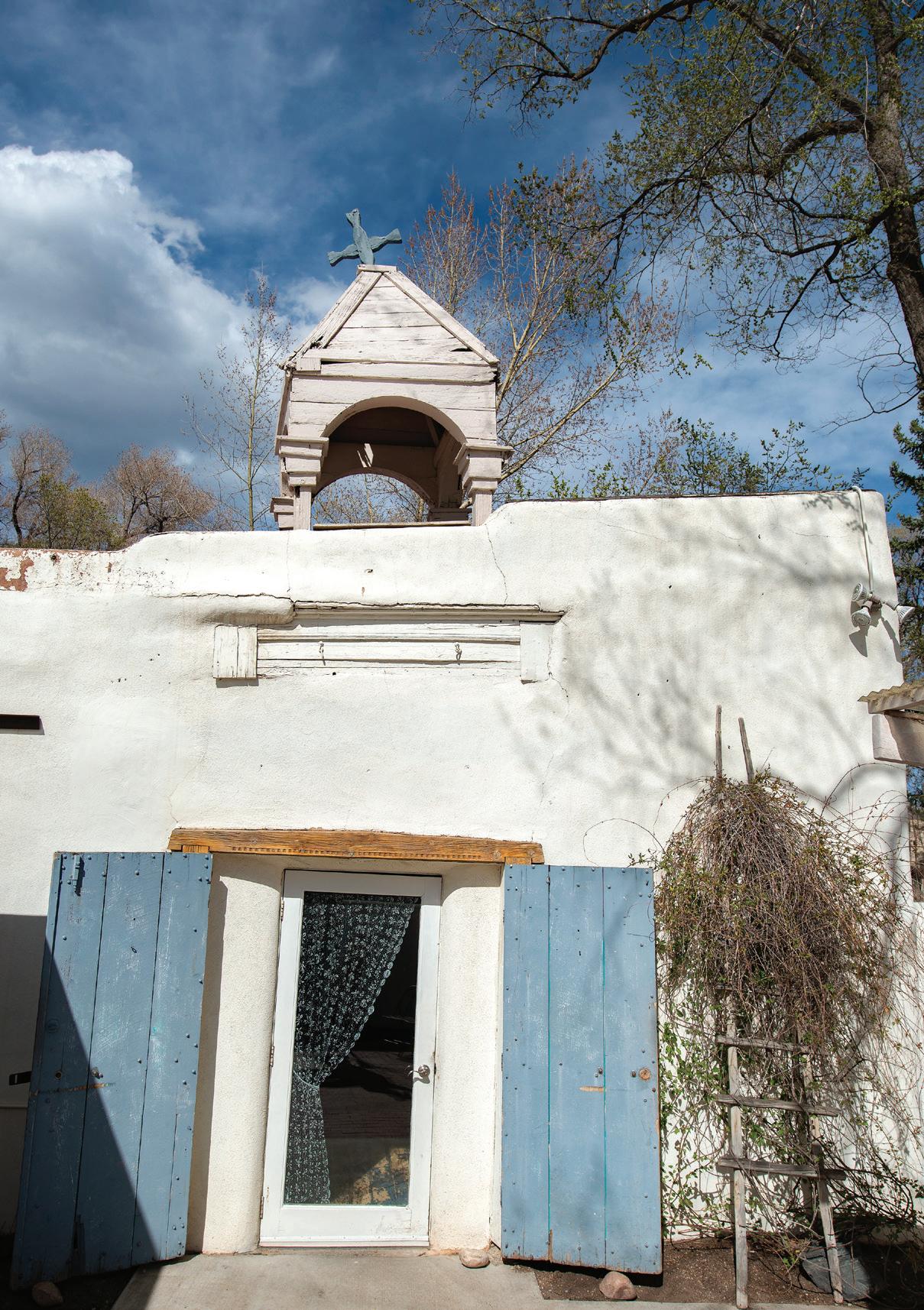
38 edible New Mexico | EARLY SUMMER 2023
Left: Steeple at The Love Apple. Top right: Overflow wine storage in the alcoves. Bottom right: List of the restaurant’s local sources.
PRANZO
upscale Italian cuisine

PRANZO ITALIAN GRILL, 321 JOHNSON STREET, SANTA FE
Tues–Sat, 11:30 am–9 pm, Happy Hour Daily 4–6 pm

100% natural ingredients from around the world
A collection of artisan made products using natural materials, from cashmere wraps to alpaca throws, Oaxacan pottery, and fine art photography.

1610 Lena Street, Santa Fe | 505. 663. 7784 | LivingThreads.org


for Your Next Dinner Party Designing a Menu
Words and Photos by Stephanie Cameron
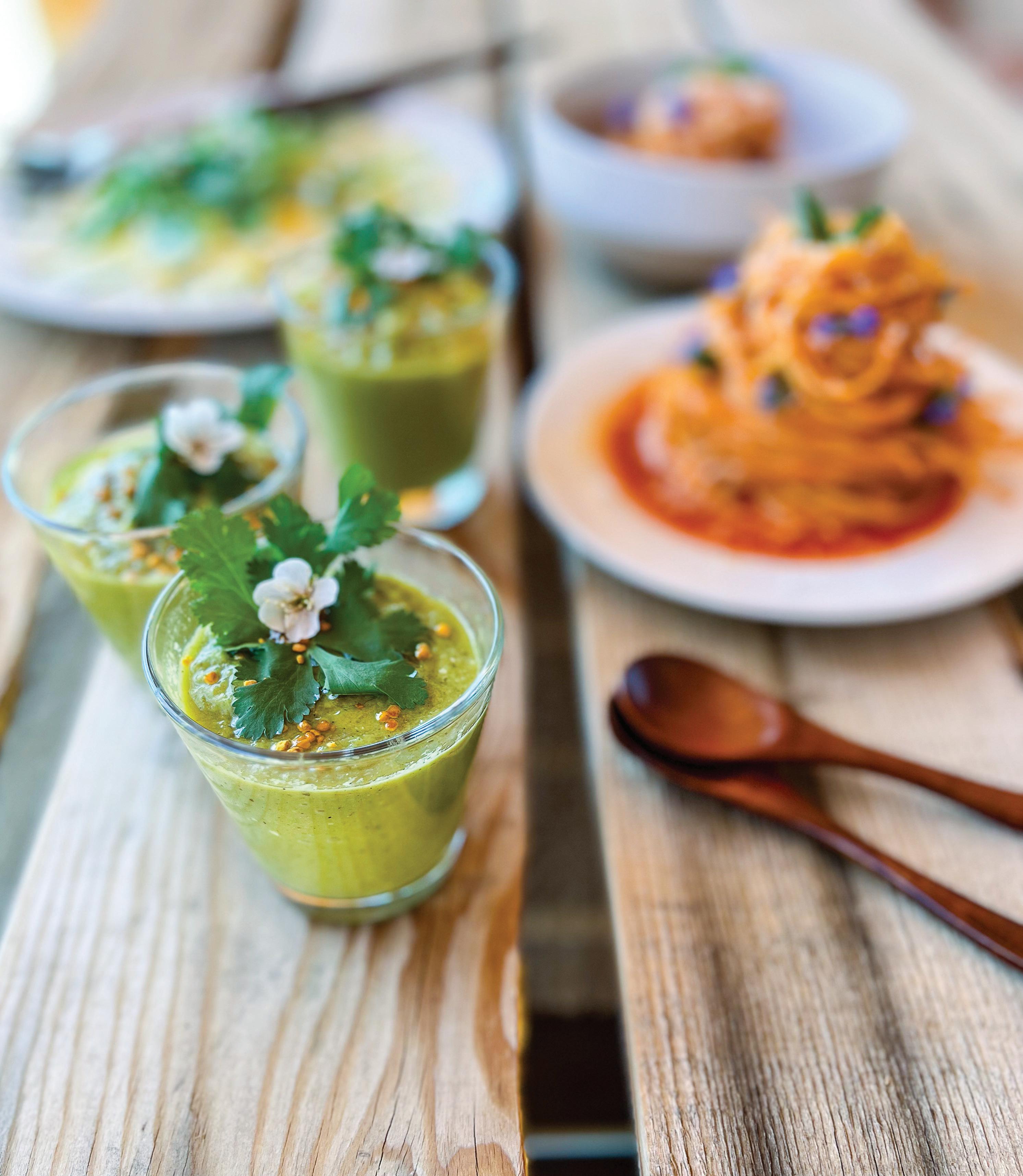
40 edible New Mexico | EARLY SUMMER 2023 COOKING FRESH
The following day there was epic cleanup to be done after a lavish night of feasting and drinking that ended with a viewing of The Cook, the Thief, His Wife & Her Lover . I was hosting my first dinner party and had spent a week skimming cookbooks, referencing food memories, and conjuring my favorite experiences to bring together six twenty-something foodies (before that was even a word) to break bread over a six-course meal. I made everything from scratch, including the bread—which was my first attempt at the endeavor—and thanks to growing up in a kitchen that my grandmother and great-grandmother cooked in every day, I did not fail at my big experiment. I utilized the stovetop, the oven, and the grill to create a feast to pair with the wine brought by friends. It indeed was a grand party in the minds of my friends, who, for many years to come, would say, “Remember that dinner party you threw? That was really something.”
After that night, I was hooked on entertaining. It didn’t matter that I had used every dish and every pan in the kitchen and spent the rest of the weekend cleaning up. The reward of creating a memorable evening with friends and finding something that really bonded us all—the enjoyment of eating food together—was worth it. Many more dinner parties and beautiful messes were to follow.
This training prepared me for taking over holiday family gatherings, where I cooked for sixteen people, and with each dinner I got better at planning and more efficient in mitigating the mess at the end. Now, many of those family members have passed on, the kids are grown, and the gatherings have become much smaller.
Coming out of this prolonged winter (and the last three years of COVID), I decided it was time to throw another grand dinner party. I began by combing through cookbooks and searching the internet for ideas. The number one rule for a successful dinner party is that the food you serve should have a why. With each dish I have cooked for my friends and family, there is always a story behind it. My inspiration for this dinner party will be my garden. From my recent successful growing seasons, I know what will be abundant, and those ingredients guide my menu.
In this edition of Cooking Fresh, I share some tips and gardeninspired recipes, giving you steps to prepare a dinner party menu and ensure that you have a well-executed evening of surprises and unexpected pleasures. For me, a memorable party is crafted from the interesting, unique, subtle, and unforeseen—it unfolds leisurely and ends late with a pile of plates in the kitchen that can wait until tomorrow.
THE Plan
Theme: Vegetarian-Forward Garden Party Playlist: “Dinner Chill Music 2023” on Spotify
Atmosphere: Outside dining with candles and twinkle lights
Menu: Serves 8 2 Days Before Prep time: 2 hours Day Before Prep time: 2 hours Day of Party Prep time: 2–4 hours
First Course Crostini Make the pestos. Buy bread.
Slice bread 15 minutes before party. Prep toast while cocktails are being served.
Second Course
Tomatillo Cucumber Summer Soup No prep. Make the soup while cooking down the pomodoro sauce.
Second Course
Zucchini Carpaccio No prep. No prep.
Main Course
Pasta al Pomodoro No prep. Make the sauce.
Dessert Tomato Ice Cream
Checklist
Make base and chill overnight. Churn the ice cream and make the basil leaves.
Pick up all ingredients except for bread.
Fill ice trays. Clean house. Find your twinkle lights.
Test soup and adjust seasoning as desired before party. Garnish and serve.
Slice zucchini 2–3 hours before party. Dress and garnish 30 minutes before serving.
Start boiling water and simmer sauce when serving second course. Boil pasta and add to sauce immediately after the second course. Plate and serve.
Garnish with candied basil leaves prior to serving.
Prepare garnishes and batch any cocktails the morning of. Decorate. Set table and prepare dishes for serving.
41 EDIBLENM.COM
Pro tip: Throughout the planning process, keep in mind how much space you need to refrigerate, cook, prepare, plate, and drop dishes. If you only have one oven, choose dishes that can be baked at similar temperatures.
Assess Resources
The available time, space, and equipment relative to the number of people attending is a significant factor in what you can serve. Plan dishes that can primarily be prepared ahead and require simple last-minute cooking and finishes.
First Course: Crostini
All you need to make crostini is olive oil and a loaf of quality bread, such as a simple rustic loaf or a baguette. Slice the loaf evenly, brush with olive oil on both sides, and toast just enough to crisp the slices. Grill on each side for 1–2 minutes or place on a baking sheet and cook at 350°F for 15–20 minutes, flipping halfway through. Top crostini with desired toppings and serve. Make toppings ahead of time and prep toast while cocktails are being served.
Shishito Romesco Crostini

12 shishito peppers
1 cup parsley
1/2 cup pecans
2 tablespoons fresh bread crumbs
1/2 teaspoon lemon zest
1 tablespoon lemon juice
1/2 cup extra-virgin olive oil
Kosher salt, to taste
Pepper, to taste
Grill the shishitos over high heat, turning until lightly charred, about 2 minutes. Transfer to a food processor and let cool slightly. Add the parsley, pecans, bread crumbs, lemon zest, and juice, and pulse until minced. With the machine on, add the oil. Season with salt and pepper. The mixture can be smooth or chunky.
Honey Pecan Pesto Crostini
1 cup pecan pieces
1 teaspoon orange zest
3 tablespoons honey
1/2 teaspoon salt
4 ounces chèvre
1–2 tablespoons Greek yogurt
Flaky sea salt, for garnish
Add pecans, orange zest, honey, and salt to a food processor, and pulse all ingredients together. The mixture can be smooth or chunky.
In a small bowl, mix chèvre with yogurt until it’s a spreadable consistency. Spread toast with cheese mixture and top each with a spoonful of pesto. Finish with a sprinkle of flaky sea salt.

42 edible New Mexico | EARLY SUMMER 2023




BREAKFAST ‧ LUNCH ‧ CATERING 2933 Monte Vista NE, Albuquerque ‧ 505-433-2795 theshopabq.com @theshopbrealfastandlunch on Instagram and Facebook Open for dine-in or carry out. Wednesday–Sunday 8am-3pm
Lay a Foundation
Lay your dinner party menu foundation by centering around your main or specialty dish. Then create a list of possible dishes based on ingredient choices, your cooking experience, and the preparation time required.
First Course
Tomatillo Cucumber Summer Soup

The beauty of this soup is that it can be made well ahead of time and served cold. Cool and refreshing, it is a great palate cleanser for the meal.
1 pound tomatillos, husks removed
1/4 white onion, quartered
2 whole garlic cloves
1 poblano pepper
1/4 cup extra-virgin olive oil
1 cup cucumber, peeled and chopped
1/2 cup packed cilantro
2 tablespoons lime juice
1/2 teaspoon sea salt
1/2 teaspoon honey
1/4 cup plain yogurt
Garnish (optional)
Olive oil
Cilantro
Roasted pepitas
Bee pollen
Edible flowers
Heat the grill to medium-high heat. Drizzle tomatillos, onion, garlic, and poblano pepper with olive oil and a few pinches of sea salt. Wrap the garlic cloves in foil with a bit of oil. Place all the vegetables directly on the grill. Grill until they are soft and slightly charred. Remove veggies from the grill and unwrap the garlic. Allow to cool for an hour.

Put all the ingredients in a blender and blend until smooth. Taste and season as necessary. Refrigerate for up to four days.
Serve as is or with whatever garnishes you like. Select garnishes, like those suggested, which will add flavor and crunch.
44 edible New Mexico | EARLY SUMMER 2023









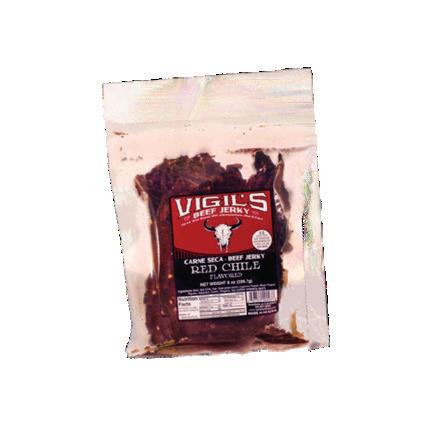

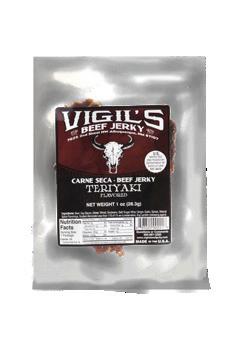




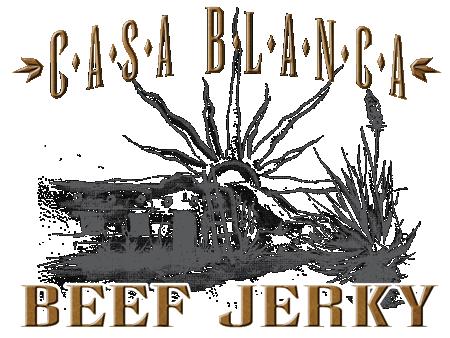


Payne’s Organic Soil Yard 6037 Agua Fria (505) 424-0336 Payne’s South 715 St. Michael’s (505) 988-9626 Payne’s North 304 Camino Alire (505) 988-8011 Happy Gardening! paynes.com Stop By Payne’s Today and GROW Enchanted with Your Garden! TRANSFORM YOUR GARDEN WITH THE BEAUTY AND BENEFITS OF ANNUALS AND PERENNIALS! Santa Fe’s Gardening Experts Dahlias Petunias Geraniums Peonies Daises Yarrow Whether you’re looking for plants that complete their cycle in a growing season, or that come back year after year, Payne’s Nurseries have been the trusted local plant experts for more than 71 years! flybyprovisions.com At Flyby Provisions, we embrace our relationships with talented artisans, sustainable producers, and values-driven small businesses. We make it easy for you to deliver thoughtful, feel-good gifts to the people you love! visit our flagship store at 201 Coal SW, ABQ just a few doors down from Zendo Coffee and Sidetrack Brewing WANTED Casa Blanca Beef Jerky NO PRESERVATIVES NO NITRATES NO MSG Our Jerky is all-natural, and preservative free. Shop all 11 avors! 7625 2nd St NW Building C Albuquerque, NM 87107 (505) 867-3283 (505) 867-3283 www.vigilsbee erky.com CASABLANCABEEFJERKY.COM ITS OWN REWARD
Zucchini Carpaccio

Instead of beef, this recipe uses thin-sliced raw zucchini, and the dish is brightened with Parmesan, lemon, and fresh herbs. Zucchini can be sliced 2–3 hours ahead of time and dressed 15–30 minutes before serving.
2 medium zucchini, ends cut off and sliced lengthwise with a mandolin
Juice from 1/2 lemon
4 teaspoons extra-virgin olive oil
Kosher salt, to taste
Fresh cracked pepper, to taste
1 cup baby arugula
1/4 cup shaved Parmesan
Parsley flowers (or another herb flower)
Combine lemon juice and olive oil. Layer zucchini to cover the bottom of a platter. Season with salt and pepper and drizzle with olive oil and lemon dressing. Repeat layering zucchini, salt, pepper, and dressing until all zucchini is used up. Marinate for at least 15 minutes. Right before serving, top with fresh arugula, shaved Parmesan, and herb flowers.
Build the Menu
Start with a favorite dish, one you love to make and can proudly bring to the table. Then work around it with contrast and complements. Think about the tastes (bitter, salty, sour, spicy, sweet, umami) and textures (chewy, creamy, crispy, crunchy, firm, tender, soft) in your main course, and try to add something different.
Pro tip: Choose dishes you have (successfully) prepared before. Your cooking experience will largely determine what type of dishes you should attempt. Be ambitious, but not too ambitious. If you want to serve a new dish, practice the recipe beforehand. Generally, use recipes that rely on techniques you’ve used before.
46 edible New Mexico | EARLY SUMMER 2023





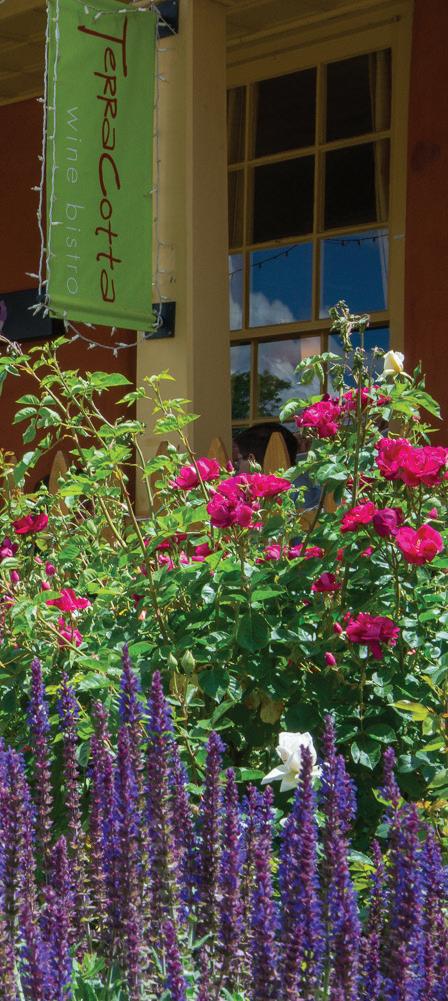





Payne’s Organic Soil Yard (POSY) in Santa Fe 6037 Agua Fria (505) 424-0336 Happy Gardening! paynes.com Create Stunning Gardens with Organic Soil Amendments: Combining Beauty & Sustainability Payne’s Organic Soil Yard (POSY) offers a selection of premium bulk enriched soil, nutrient-rich compost, high-quality mulch, and other sustainable soil conditioners made right here in Santa Fe. GREAT GARDENS START WITH GREAT SOIL! WINE BISTRO DINNER Fri & Sat 5-9pm Sun, Mon & Thurs 5-8pm Closed Tues & Wed 304 Johnson St, Santa Fe 505-989-1166 terracottawinebistro.com Dozens of Interesting Wines by the Glass • Bruschetta Platters to Share • Our Famous French Onion Soup Providing authentic New Mexican culinary creations passed down for generations for more than 58 years. A Timeless Tradition.
300 Juan Medina Rd, Chimayó 505-351-4444 ranchodechimayo.com Stop By and Meet Mrs. J A New Mexico Culinary Treasure! Est. 1965
Winner of the James Beard Foundation America’s Classics Award
Pro tip: Vegetable garnishes can offer a wide variety of color to your menu. Some that are easy to find are edible flowers, carrot curls, green onions, chives, parsley, radishes, herbs, chopped red pepper, lemons, limes, and oranges.
main Course
Pasta al Pomodoro
Adapted from Eric Kim
This dish has become my go-to with fresh tomatoes. Pasta is the perfect vessel to make them shine, the starchiness clinging to the sauce and resulting in a silky texture. The sauce can be made several days ahead, and the pasta can be cooked between courses with little time away from your guests. The pomodoro sauce can also be used in a variety of recipes, including Steak Pizzaiola in this issue on page 53.

1 cup extra-virgin olive oil
8 large garlic cloves, peeled and lightly crushed
6 pounds ripe tomatoes (any mix of plum, grape, cherry, and Roma), coarsely chopped
Salt
1 1/2 pounds thin spaghetti (or linguine)
1/2 cup basil leaves, chiffonade
Parmesan, freshly grated
Add the olive oil and garlic to a large dutch oven. Turn heat to medium high and cook garlic, occasionally stirring, until fragrant and lightly golden, 1–3 minutes. Remove garlic from the pot and discard.
Carefully lower the chopped tomatoes into the hot oil. Stir constantly until the tomatoes let off some liquid and the sauce starts to bubble steadily. Season generously with salt. Lower heat to medium and simmer, stirring occasionally, for about 40 minutes, until the tomatoes break down and the sauce reduces significantly.
Set a metal sieve, strainer, or food mill over a medium bowl. Carefully pour in the tomato sauce. If using a sieve or strainer, push the sauce through with a flexible spatula until all that remains are seeds and skins. Be sure to repeatedly scrape off the valuable pulp collecting on the bottom of the sieve (by holding the sieve against the edge of the bowl and pulling it back). You should have about 4 cups of sauce in the bowl. Taste and add more salt if needed. If you are making it ahead of time, you can refrigerate. Then return the sauce to the dutch oven and continue to heat.

Meanwhile, cook the spaghetti in a large pot of salted boiling water for 6 minutes. It is important to not cook to doneness. Drain the pasta and add to the sauce.
Turn heat to high and cook, constantly stirring, until sauce reduces slightly and pasta is well coated but not drowned in the sauce, about 2 minutes. Remove the pot from the heat and let it sit uncovered so the pasta can absorb the sauce further, about 5 more minutes. Serve family style or as individual nests with fresh basil and grated Parmesan.
48 edible New Mexico | EARLY SUMMER 2023















505.898.3562 AlamedaGreenhouseABQ.com 9515 4th St NW ■ Albuquerque, NM 87114 Visit Visit our Satellite Greenhouse Shops Located at 300 Broadway NE Offering Houseplants & Accessories GROW YEAR-ROUND WITH HOOPED RAISED BEDS AND SEASONAL COVERS NEW THIS SPRING!!! MED BEDS AND SETUPS WHY PHARM, WHEN YOU CAN FARM?! GROWYOWN.COM 505.490.1849 raised bed gardens
Pro tip: Plan on serving 1/2 bottle of wine per person, and choose a wine paired with the main course. Selecting a wine for each course is unnecessary, but you may choose to serve a lighter wine for the early courses.
Wine, Cocktails, and Dessert
During a dinner party, plan to serve about two drinks per person during the cocktail hour, two drinks or glasses of wine during dinner, and one digestif or coffee. Lighten the load by preparing a batched cocktail or specialty drink as the guests arrive. For this menu, we batch Opuntia’s 13 Going On 30 from our Cocktail Guide in this issue. For mocktails, consult our online guide at ediblenm.com/mocktails
Tomato Ice Cream with Candied Basil
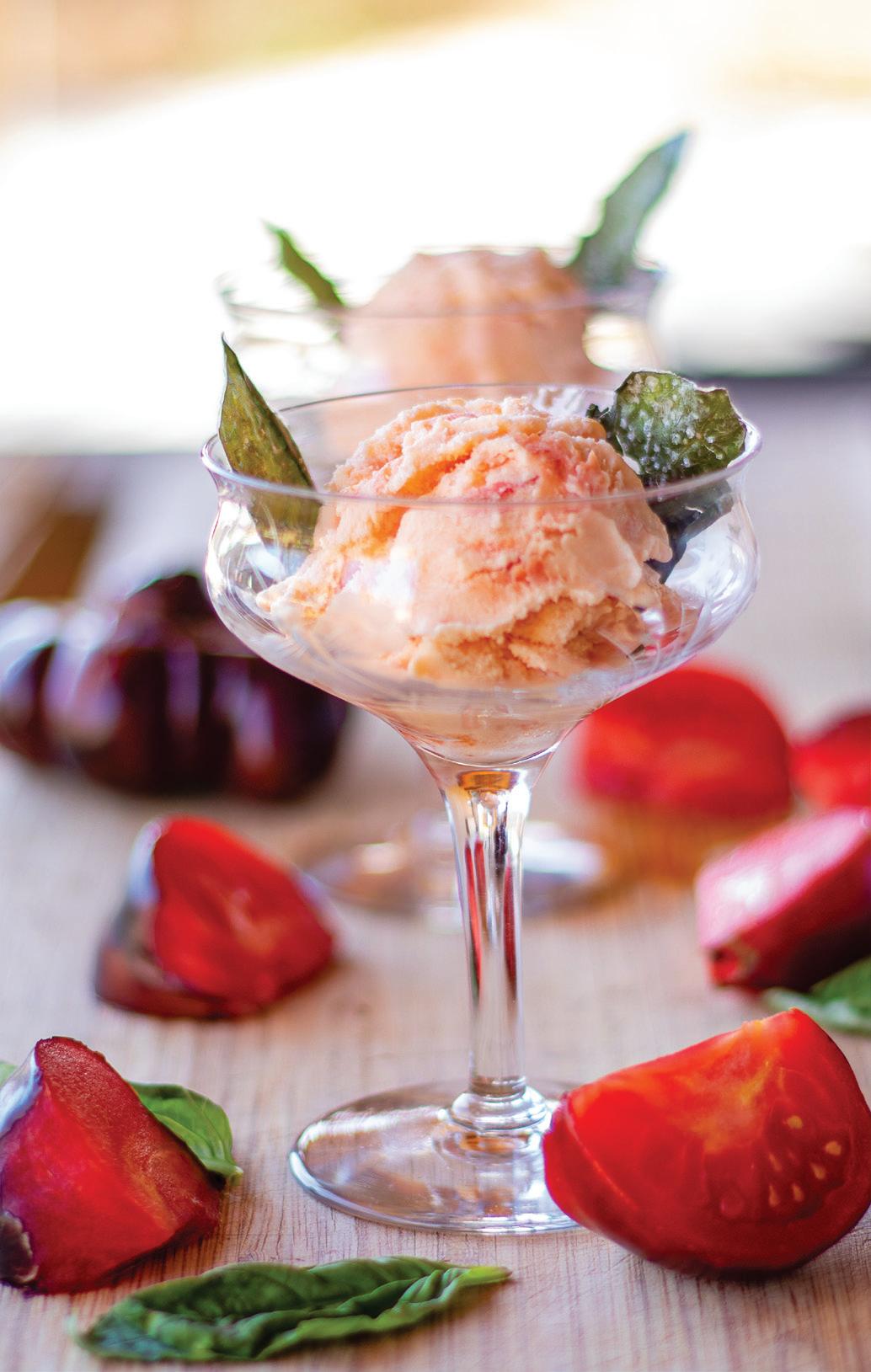
Yes, tomatoes for dessert! The sweet tanginess of tomatoes combined with cream and sugar is a marriage made in heaven. This is no place for canned tomatoes; it is a showcase for heirlooms coming from your garden or local farmer.
Ice cream
1 pound heirloom tomatoes
4 egg yolks
2/3 cup organic cane sugar
1 cup heavy whipping cream
1 1/2 cups milk
2 teaspoons vanilla
2 teaspoons orange liqueur
1/2 teaspoon sea salt
Candied basil leaves
24–30 basil leaves
1 egg whites, beaten with 1 tablespoon water
1/4 cup organic cane or palm sugar
Ice cream
Add tomatoes to a pot of boiling water for about 10 minutes until skin loosens. Peel skin and discard seeds using a strainer, saving only the pulp and juices.
Add tomato pulp to a medium saucepan with heavy whipping cream and milk, and allow the mixture to simmer. In a separate bowl, combine egg yolks with sugar. Reduce heat to low and slowly whisk egg yolk mixture into the simmering tomato liquid, constantly whisking for about 5 minutes until the mixture has thickened slightly. Remove from heat and whisk in vanilla, orange liqueur, and salt.
Pour the mixture into a bowl and cover, cooling for 2–12 hours before freezing. For the best result, use an electric ice-cream maker to complete your ice cream, per the manufacturer’s instructions. If you don’t have access to an ice-cream maker, pour the mixture into a hard container, such as a deep pot or pan; cover; and freeze for at least 6 hours before serving. Serve with candied basil leaves (it is okay if they crumble).
Candied basil leaves
Brush a thin layer of egg whites on to the basil leaves. Sprinkle basil leaves with sugar. Place leaves on a parchment-lined cookie sheet and dry them at 150°F for 45 minutes to 1 hour.
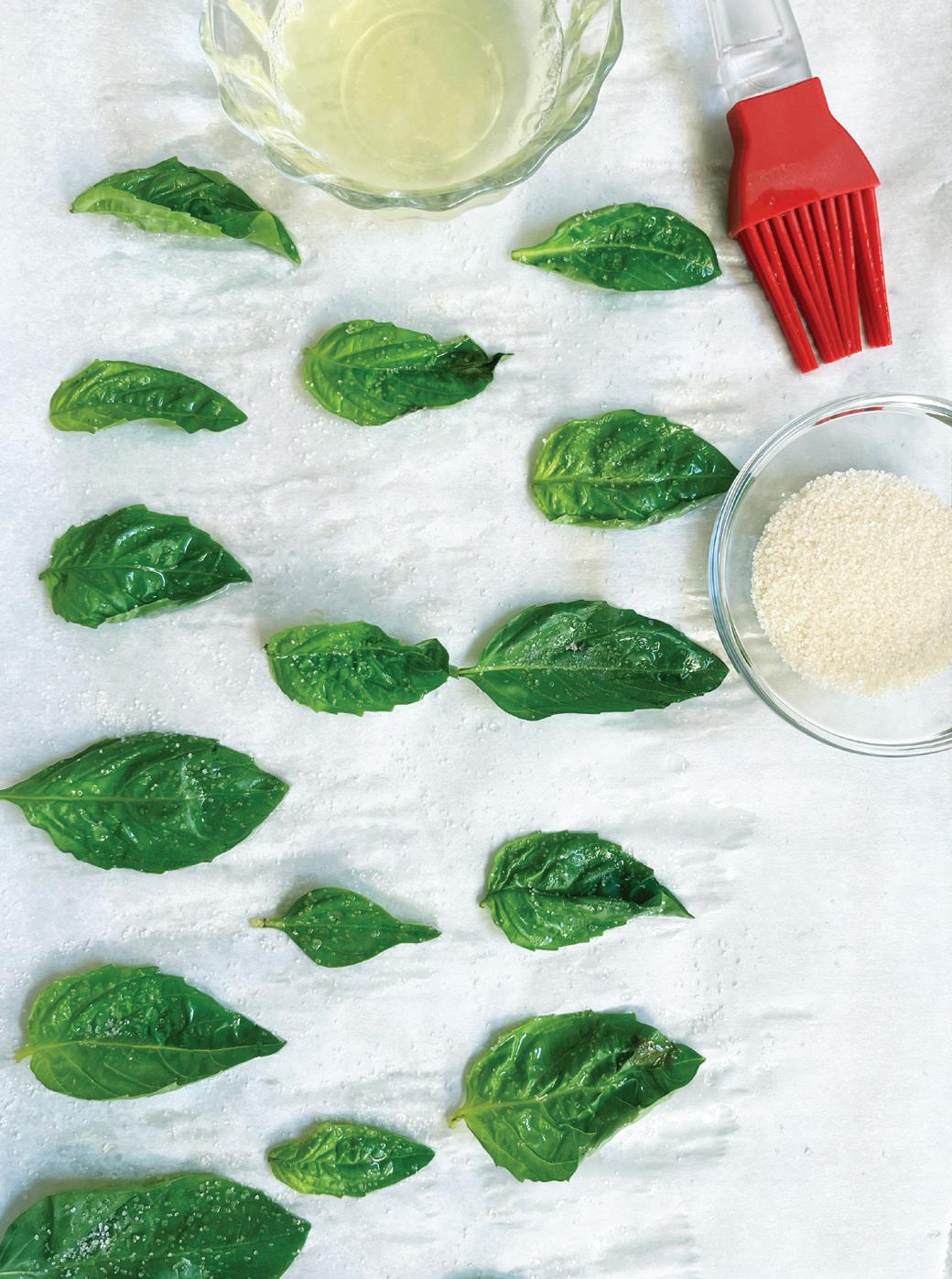
50 edible New Mexico | EARLY SUMMER 2023


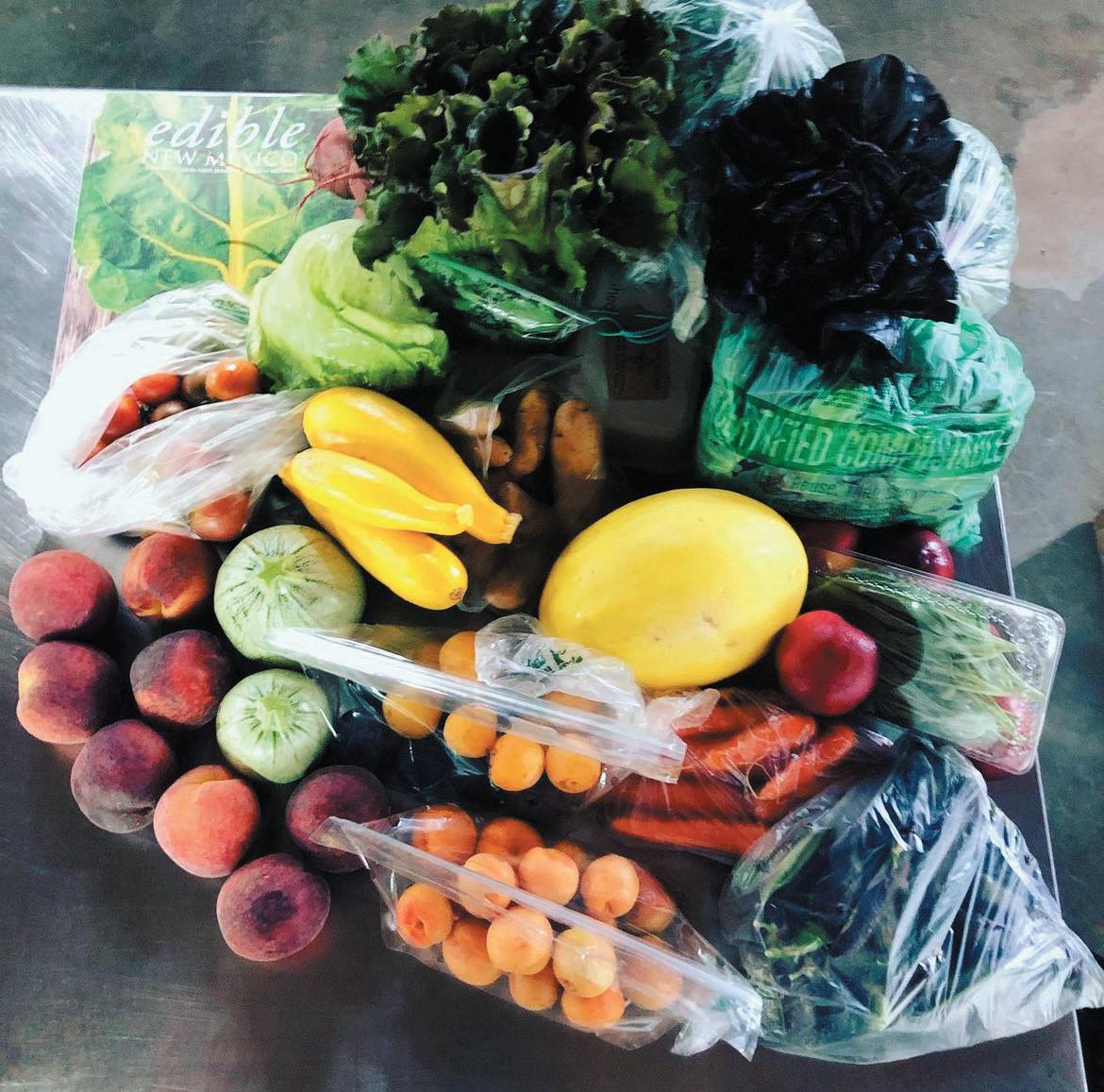

Grass-fed Beef

SPONSORED BY
INGREDIENT
EDIBLE
Photo by Stephanie Cameron
STEAK PIZZAIOLA
Recipe adapted from Serves 4–6


Adding a hearty tomato sauce to a seared steak does not take away from the experience of the steak—rather, searing the steak adds flavor and helps keep it juicy as it finishes cooking in the sauce. This recipe is where garden and in-season tomatoes shine. Preparing the sauce a day or two in advance makes the final preparation quick and easy. Rib eye, New York strip, sirloin tip, eye of round, or top sirloin are all good choices for your cut of steak.
Pomodoro pasta sauce; see ingredients on page 48

2 tablespoons fresh basil, chopped
4 Sweet Grass top sirloin steaks about 1/2-to-3/4-inch thick
Kosher salt and freshly ground black pepper
4 tablespoons extra-virgin olive oil
4 garlic cloves, peeled and halved
1/2 teaspoon red pepper flakes
2 tablespoons fresh oregano, chopped (2 teaspoons dried)
1 cup dry white wine
2 tablespoons fresh basil, chopped, for garnish
Season the steaks on both sides with salt and pepper. Heat oil in a large, sturdy skillet over medium-high heat until hot but not smoking. Add garlic halves and cook for 1 minute. Add steaks and sear each side for 2 minutes, then transfer them to a plate.
Add red pepper flakes and oregano to hot pan, then add wine and cook, frequently stirring, until the liquid is reduced, about 2 minutes. Add 2 cups of tomato sauce; stir. Place steaks into sauce and cook for 6–10 minutes per side for medium (140°F) or to desired doneness, adding a bit more water if the sauce is too thick. Use a thermometer to ensure the correct internal temperature.

Slice steaks and place on a serving dish, then pour sauce over them. Garnish with basil and serve at once.
*Sourcing note: La Montañita Co-op carries several cuts of grass-fed beef.
53 EDIBLENM.COM
DOWNTOWN DESTINATIONS IN OLD DOWNTOWN SPACES

THE FOUNDERS OF EX NOVO AND VINAIGRETTE BRING MODERN-DAY PERSPECTIVES TO NEW HANGOUTS
By Jennifer C. Olson
54 edible New Mexico | EARLY SUMMER 2023 DESIGNING NEW
Joel Gregory, owner of Ex Novo, in front of the old Firestone building on Central.
Photo by Stephanie Cameron.
Two entrepreneurs walk into a bar. Both have fashioned business models around changing the world for the better. Both have created small empires—one beer, one salad, one venue at a time—by building top-quality offerings and telling the stories behind them. Now, both are taking lessons from their past to turn iconic downtown Albuquerque buildings into their dream hangouts. They are planning urban infill projects according to their distinct interpretations of today’s customer penchants, making some of the same decisions while taking somewhat different approaches as they breathe new life into historic areas along Central Avenue.
Joel Gregory, president and founder of Ex Novo Brewing Company, is expanding with a full-service restaurant and taproom in Albuquerque proper. Erin Wade, best known as owner of Vinaigrette, is relocating Vinaigrette Albuquerque and opening more new concepts in the West Downtown neighborhood where she has been established for a decade. Yes, both have their own ideas about what constitutes a perfect restaurant, coffee shop, or watering hole, and they are blueprinting their spaces accordingly.
Edible New Mexico’s sneak peek at their designs revealed commonalities that capitalize on Albuquerque’s 310 days of sunshine while encouraging community and alfresco fun. While the designs make room for more grab-and-go options, they also ensure rich experiences for the occasions when guests do feel social and make time to stick around.
When Joel Gregory walks into a bar, what he expects depends on what time of day he’s there, who he is with, how hungry he feels, and where the space itself pulls him. On a weekday morning, the Corrales native would want a caffeinated sip and a to-go meal. Solo after work, he’d claim a stool with enough space for his thoughts but not so much that he feels lonely. For a languid Saturday afternoon, Gregory would require yard games and space for his kids to frolic. For a romantic night with his wife, he’d seek out a candlelit lounge.
Embracing all eleven thousand square feet of the old Firestone building, Gregory and Walter Gill of Modulus Design are making all these scenarios comfortably possible at the corner of Seventh Street and Central Avenue. “We’re strictly drawn to interesting properties,” Gregory says, listing Ex Novo’s two locations in Oregon, where the brewery began, and its history-laden plot in Corrales.
Having put both Oregon properties up for sale in March, Gregory will bring Ex Novo’s beer and a robust menu to the heart of a city that’s heavy on taprooms. “I think Albuquerque is still growing and can learn from other markets,” he says.
Gregory first toured the old Firestone Tire building in June 2020. He was after “something with a story that’s in a part of town that needs it,” and the 1930s tire shop checked all the boxes.
With the expertise of Modulus Design, which tackled the site development and construction of Ex Novo’s hugely successful brewery and taproom in Corrales, Gregory envisions a restaurant that invites all and sundry in for every occasion. “We’re creating a space that will be utilized a lot more than it has been in previous years,” Gill says.
The building stayed true to its original intent up until Heritage Driven, which restores custom Land Rover Defenders, moved out. Preparing it for another life as Ex Novo Brewing Company involves removing layers of paint and “decades of grease” from previous inhabitants.
With concrete walls and a wood roof, the twenty-four-foot-tall building has multiple storefront openings and garage doors that are close to fourteen feet tall. “It was never a conditioned space. While Ex Novo will have new heating and cooling systems to better control the interior space, we’re keeping that and designing for an indoor/outdoor flow,” Gill says.
Establishing a main entrance on Seventh Street, the redesign downplays the enormity of the space but accentuates the building’s natural light while leveraging its position. “The building lends itself to an open, airy, daylit space for people to enjoy,” Gill says. “During that happy hour, the building itself creates a shade structure for the patio,” which will sit in what used to be the shop’s drive-up lanes.
With an extra bit of square footage, Gregory will open a café and deli that promotes traffic during periods when the brewery is not traditionally open. “The front space where the deli will be operated out of was the Firestone showroom,” he says.
The Ex Novo portion, originally the mechanics’ bays, will comprise three sections: the main floor, mezzanine, and patio.
“From the get-go, we had to really understand the main aspect of this project: being an Ex Novo Brewing Company,” Gill says. “It’s going to be bar-centric. We placed a very large, horseshoe-shaped bar dead center to be the focal point of the space. By doing that, we were able to have the building decide some of the design for us.”
That main floor will also include a lounge area, a nook for shuffleboard, and a family-friendly seating area with chairs and tables. Stairs lead to an existing mezzanine, where small booths for the twentyone-and-over crowd will be adorned with chandeliers on low, dark ceilings, themselves a contrast to the high, white ceilings below.
The lot’s southeast corner will become a three-thousand-squarefoot all-ages patio with firepits and a stage that doubles as a seating area. “The stage will point back at the building and patio,” Gill explains, “so the backdrop of the stage is Central Avenue itself, giving Ex Novo a sense of place.”
A planting strip around the property’s edge will buffer the public zone (read: sidewalk) from where you’re enjoying beverages and elevated pub food prepared—alongside the café’s products—in a shared kitchen built to serve a large occupancy. “The space below the mezzanine was a natural spot to tuck the kitchen, coolers, bathrooms and storerooms to help utilize that double-height garage,” Gill says. “We designed prep space so you could have multiple teams working without being on top of each other.”
After building Ex Novo Corrales, Gregory learned to build the spaces as big as possible. “We are rightsizing the bar to give employees elbow room,” he says.
Corrales’s bright, airy vibe, however, will carry over into the downtown restaurant, where southwestern and bohemian finishes will complete the tone.
55 EDIBLENM.COM
~
Beyond aesthetics, a mix of custom-fabricated communal tables and two-tops let people choose where they feel comfortable, while the layout makes for intuitive circulation. “You want to be able to walk into a space and comfortably understand how it works without too many cues,” Gill says.
Gregory adds: “There’s hopefully a place for everybody.”
When Erin Wade walks into a bar, she longs for a colorful setting. The cook, farmer, and designer whose Vinaigrette restaurants are recognizable by their verdant tile and red metal chairs wants to eat made-from-scratch foods, drink beautiful cocktails, and maybe partake in a little friendly competition. She doesn’t want to take herself or the bar too seriously.
But Wade, who also owns Modern General Feed and Seed in Santa Fe and recently launched the sustainable food delivery app Avocado, is designing her new businesses around what customers want. “The way people use restaurants is different now,” Wade says. “It’s not about cuisine type or even the meal period. It’s about commitment and time.”
Wade’s fiancé, architect Jeff Krolicki, explains: “We see restaurants getting smaller and relying more on outside dining and carryout. The bigger restaurants need to be casual, family friendly.”

So what Wade is bringing to West Downtown—through a cluster of “exciting, traffic-driving concepts” and a changeup in the location of Vinaigrette—builds on the existing restaurants to create a dining zone. In Wade’s view, today’s customers need to be lured from farther afield by establishments that are destinations in themselves. Her plan factors in how customers use and parse markets while maximizing the existing square footage of iconic properties.
Wade’s first priority in that plan is designing a plaza at 1720 Central Avenue, on the sites of a historic roadside motel and gas and service station, where she previously operated Modern General and The Feel Good. “I’ve loved that neighborhood,” says the serial entrepreneur, who first opened Vinaigrette along the same corridor ten years ago. Speaking of 1720 Central, she says, “The curved building with white stucco is an awesome patch of architecture we want to preserve.”
Along the way, Wade will solve problems she’s noticed while in business there. Namely, the orientation of the parking lot, which was intended to suit American autos and satisfy the dream of a road trip. “That rich period when art deco was becoming midcentury modern is an exciting moment to reference,” she says.
But the site modifications match the dreams of 2023, encouraging pedestrian traffic and giving people a place to watch the world go by, which—especially on Sundays—it does literally, thanks to a cruising culture that lives on. “The two buildings form an L shape set back a little from Central, so part of the work is to use the space in a way that brings the energy out to the sidewalk,” Wade says.
Specifically, they are creating a pickleball court and seating areas that can be used by patrons of each surrounding concept. That’s the thing about Wade: she barely refers to her restaurants as restaurants. “During the pandemic, people started to think we were food factories. That hurt. We are about this fully flowered experience,” Wade explains. “Service, design, and food are this trifecta of things we really focus on.”
Encircling the courtyard will be Vinaigrette (in the former Modern General space), Tiny’s (a sixteen-foot Airstream), and the Pickleballer (running the length of the court).
56 edible New Mexico | EARLY SUMMER 2023
~
Architectural rendering of Ex Novo on Central. Courtesy of Modulus Design.
“Vinaigrette has always been a busy restaurant, especially [during] patio season,” Wade says. By shrinking the indoor dining room but expanding more flexible outdoor seating, Vinaigrette’s kitchen can be staffed “more intelligently,” but the new Vinaigrette will have the same uplifting feel and color scheme.
Tiny’s will be playful, in line with its anticipated customer base: parents and students of Manzano Day School across the street. In addition to virgin lemonade to take on the go and boozy drinks for sipping within the breeze-block walls, Tiny’s all-day snacks play off Wade’s fascination with miniature things.
The swanky Pickleballer forming the site’s east boundary, where The Feel Good once was, is “a partial club concept” serving locally distilled spirits and iconic country club items, but reinterpreted. “I grew up with pickleball before it went viral,” Wade explains. “And I love a club sandwich.”
All three restaurants will brush up against each other in the courtyard and share a back of house. That kitchen will also be a centralized hub for producing naturally leavened bread and other scratch-made staples.
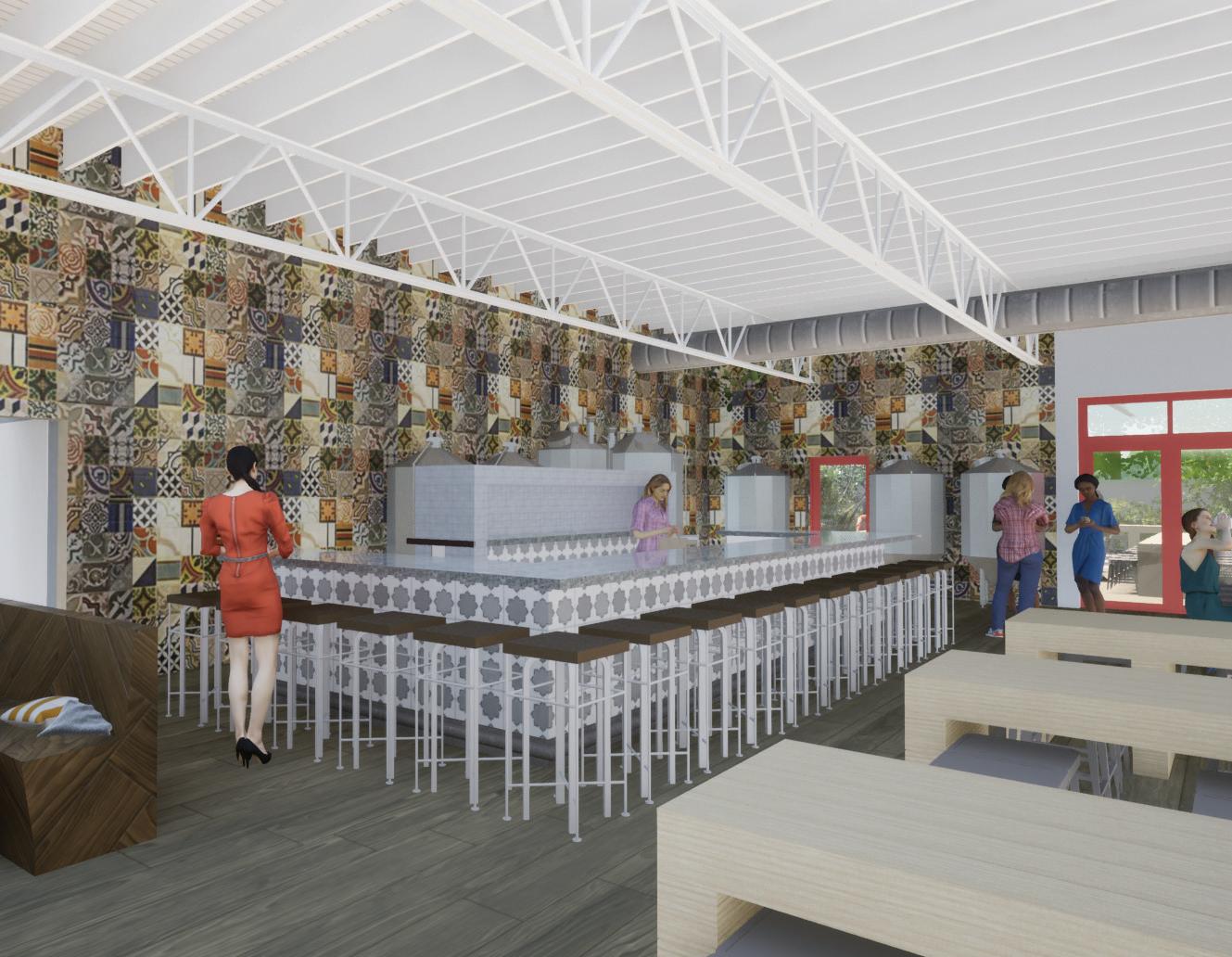
Down the road, the former Vinaigrette space is being converted into a brewery Wade calls Schweinhund and defines as a place for people outside of the typical brewery market. “There’s a quality I crave when I go someplace to hang out, and it’s an atmosphere that feels different than I sometimes get at breweries,” Wade says. That quality, which some would label as feminine, will be conveyed via a menu built around a bakery program, hanging textiles adding softness, and long communal tables impelling togetherness.
The brewing facility and bar will use the sprawling warehouse that Wade renovated before opening Vinaigrette. The reclaimed Dixon pine floors installed then now have a patina. “The space, with a drop

ceiling and exposed metal trusses, already has bones for a brewery with texture,” Wade says.
Modeled after a classic German brewhaus, Schweinhund will reference New Mexico’s culture by integrating Spanish and Indigenous motifs. “There will be some color,” Wade says, alluding to handpainted concrete tile designated for the back wall.
Wade designs for how a space feels to your body rather than how a space looks on social media. In fact, Schweinhund was first a code name for the brewery. She had been considering Umwelt, which means “environment” or “atmosphere.” “It’s your sensory experience,” she explains.
Schweinhund’s translation: “bastard.” “But I was thinking of it as your inner ‘pig dog,’ your lazy bones, couch potato self,” Wade says. “We have this idea that there’s some despicable lazy spirit that we have to conquer as opposed to embrace. Sometimes the best moments in life happen in between our shoulds and supposed-to-dos. That’s what a gathering place is about, especially one with great beer.”
That play against expectations has inspired iconography that guests can look forward to when Schweinhund opens later this year.
Why condense so many different businesses into a district that Wade herself has witnessed cycle through ups and downs? “Instead of building over what could be agricultural land, this is infill. Any urban place needs to have a thriving downtown that people actually use,” she says.
Wade illustrates her commitment by citing the trees she’s planted, the gardens within her restaurants, the planned transformation of 1720 Central Avenue’s parking lot to waterwise, drought tolerant, permeable ground cover. “Sustainability is more than about using recycled materials. Can you root in a place, be there for longer?”
57 EDIBLENM.COM
Left: Erin Wade inside future Vinaigrette (previously Modern General), photo by Stephanie Cameron.
Right: Architectural rendering of Schweinhund (previously Vinaigrette), courtesy of MAKER Architects.
DESIGNING AGRICULTURAL LANDSCAPES FOR

HUMAN WELL-BEING
By Robin Babb ∙ Photos by Stephanie Cameron

58 edible New Mexico | EARLY SUMMER 2023
AgrAbility at Mandy’s Farm in the South Valley.
In 1982, the artist Agnes Denes planted wheat on a two-acre landfill in Battery Park, in the middle of Manhattan. Photos of the field, the “amber waves of grain” image from “America the Beautiful,” nestled right next to Wall Street and the World Trade Center are still jarring to see. We are not used to finding agriculture so close to our centers of culture. But perhaps there are good reasons the two should be more integrated.
Denes’s artwork, called Wheatfield: A Confrontation, was meant to call attention to what she called our “misplaced priorities”—our loss of a close relationship with land, food, and the ways our food is grown. In an interview about the work, she said, “Manhattan is the richest, most professional, most congested and, without a doubt, most fascinating island in the world. To attempt to plant, sustain and harvest two acres of wheat here, wasting valuable real estate and obstructing the ‘machinery’ by going against the system, was an effrontery that made it the powerful paradox I had sought for the calling to account.”
What strikes me most in this quote from Denes is the word wasting . The idea that planting food on these two acres—our most pressing necessity, our most critical resource—is a waste of that land can only be born of a nation that doesn’t see feeding people as its top priority. Thus, the paradox she is talking about: our most valuable land is not that which can grow the best food but that which can create the most profit.
With Wheatfield, Denes was pointing out how we’ve lost touch with the importance of the food we eat, the land we live on, and the ecosystems that we’re a part of, whether we know it or not. Forty years later, the distance between American city dwellers and the food they eat—even in places with rich agricultural traditions like New Mexico—seems, for the most part, to have grown wider.
In their 2020 book Farmscape: The Design of Productive Landscapes, authors Phoebe Lickwar and Roxi Thoren argue that the intentional placement and design of agricultural landscapes is key in any plans we make to create an ecologically sound and humane future. Indeed, they write, “reintegrating food production with domestic, educational, and recreational landscapes is critical in light of contemporary questions of food security and ecological health. We cannot understand or care about that which we cannot see.”
The “out of sight, out of mind” nature of the vast majority of farm labor prevents us from seeing many things about the way our food is grown: the chemicals used and the amount of waste, as well as the human and animal rights violations that often occur on industrialized agribusiness farms. On many American farms, especially those that employ migrant or seasonal laborers, workers’ access to fresh water, bathrooms, and shade to cool off in, or simply spaces to rest and eat, are few and far between, if present at all. The United Farm Workers’ strikes of the 1960s and ’70s sought to make consumers aware of these deficiencies—and they won several cases that helped to secure some of these benefits. But, as we know from any one of the many high-profile legal disputes and labor rights violations in the decades since, there is much progress yet to be made.
Katya Crawford thinks that associating agricultural landscapes exclusively with hard labor is one of the reasons for our troubled relationship with food and the land. Crawford, the chair of and an associate professor in the Landscape Architecture Department at the University of New Mexico’s (UNM) School of Architecture and Planning, believes that we could integrate more humane design principles into farms by considering both social relationships and the importance of rest, especially when it comes to agricultural labor.
“When you work together [on a farm], you create certain bonds, but I think it’s that time of rest when other conversations can happen, when reflection can happen. I also think it’s a time for spontaneous gathering, meal sharing, and meetings. . . . You can see the landscape from a different perspective once you have rested. I think that in today’s world, where people are treated so much as machines, where we have this insane relationship to capitalism—production, production, production!—I feel like rest is an act of defiance, and it is just as important and nourishing as food.”
Having grown up on a small farm in Dixon—the farm of Stanley Crawford, author of the New Mexican cult classics A Garlic Testament and Mayordomo—Katya Crawford now thinks about the spaces of rest that could be included in such agricultural landscapes when she considers that farm and her eighty-five-year-old father. “Everything outside was about work . . . and at night, you would sit on the couch in the living room. You know, those were the rest spaces, but there were no outdoor spaces to relax or lounge or eat or any of that sort of stuff.” Now, she says, she thinks about landscape design as a tool to make outdoor spaces more nourishing and restful. In her own backyard, she and her husband have designed and built what she calls a “napping pavilion”—screened in, with a mattress, perfect for watching birds or for sleeping outdoors when the weather’s nice.
Taking an anticapitalist approach to agricultural design that accounts for human well-being—both on the producer side and on the consumer side—rather than just efficiency would, of course, require a pretty dramatic restructuring of our entire national agricultural system. But that doesn’t mean that there aren’t already some examples of this human-first design principle in existence.
One of those examples is the AgrAbility farm in Albuquerque’s South Valley. AgrAbility is an educational apprenticeship and business incubation program for people in New Mexico with intellectual and physical disabilities who want to pursue a career in farming. The apprenticeship program, which is operated by the local nonprofit Mandy’s Farm, spends a year with each cohort, teaching them how to grow food, giving them the resources and tools they need to work according to their particular needs, and setting them up to either work with an existing farm or start their own farming micro-business.
Paul Ross, the program director at AgrAbility, holds a bachelor’s degree in sustainable development from Columbia University and a master’s degree in landscape architecture from UNM. He says he is grateful that Mandy’s Farm has given him a “super long leash” in terms of how the space gets designed and developed over the next few years,
59 EDIBLENM.COM
~
as he now gets to put into practice some of the landscape architecture principles he has spent his career learning. “I like thinking of design and building as, like, a cycle that keeps informing itself.” Ross says. “And this is a really amazing site to practice that because I get to be the one who builds stuff and draws it up and then, halfway through drawing, or halfway through building it, thinks, ‘Oh, this idea was totally unrealistic or not helpful’ and then [is] able to change it.”
With those design principles, he has built a greenhouse that’s not only wheelchair accessible but specifically designed for workers who are in wheelchairs and those with limited mobility. In line with a more general philosophy of working smarter, not harder, some students from Central New Mexico Community College designed and built a remote-operated mister system to keep the plants in the greenhouse watered with minimal labor. This year’s apprentices, who started in March, are the first to test out the greenhouse, tending to the warm season starts like tomatoes, chiles, and eggplants.

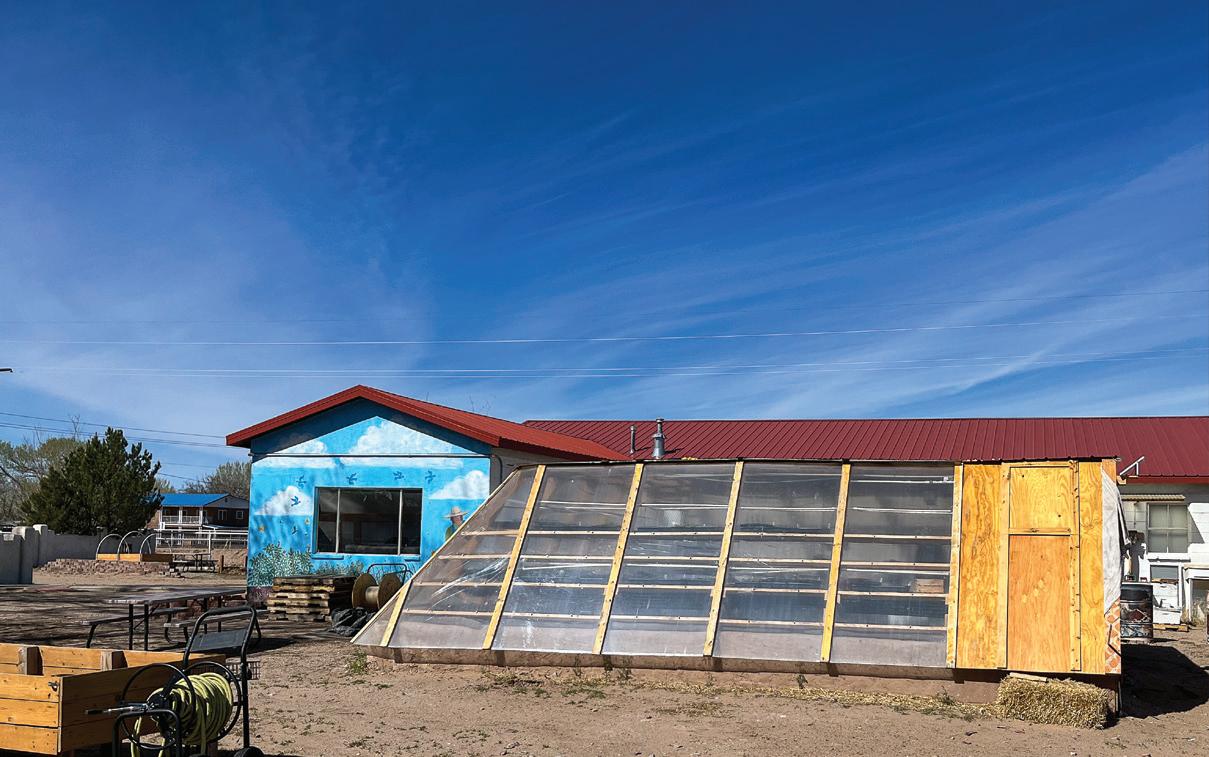
For Ross, though, sustainable and accessible landscape design also means making farms that can continue to be workable and productive through our quickly changing climate. His plan to plant fruit trees on

the west side of the field, closest to the ditch, is with the hope that they can provide both a windbreak and biomass in the form of fallen fruit and leaves in the future. And he knows that water shortages will be an issue in coming years, so choosing drought-resistant crops and trees that can quickly reach the water table is a priority.
“I don’t think we should just say, oh, you know, ‘Just throw more water on it. We need the food.’ That’s an important perspective to challenge,” he says. “And what kind of efficiency could we achieve if we really bent our will to it?”
Another example of centering human well-being in small-scale farm design is Lobo Gardens at UNM’s main campus in Albuquerque. Amara Szrom is the coordinator of the garden, as well as a master’s student in the community and regional planning program at UNM. Szrom, who teaches a sustainability studies class, uses the garden as a hands-on educational tool for students who want to actually implement sustainable designs for their capstone projects. This is not a new endeavor; Lobo Gardens has been in its present location on Campus Boulevard between Vassar and Girard for eleven years. Plenty of
60 edible New Mexico | EARLY SUMMER 2023
~
Top: AgrAbility apprentices with program director Paul Ross (center). Bottom: Exterior and interior of greenhouse at AgrAbility.
students have taken turns managing the garden over that time, adding compost bins, rain catchment systems, greenhouses, and other changes with the intent of making the garden more efficient. But for her professional project, Szrom is hoping to expand the one-acre garden into a neighboring acre that’s currently just grass, which requires a lot of water and doesn’t feed anyone. To Szrom—and, I’d wager, to Agnes Denes too—that is a real waste of real estate.



“All the produce that we grow here that doesn’t get eaten by volunteers, it goes to the [Lobo] Food Pantry,” says Szrom. “The food pantry serves fifteen to twenty students a day. . . . And so if we have more growing space, we can have more food. But then ultimately, I really just think [this expansion] should be a design project for the landscape architecture students.”

Szrom suggests that a properly constructed outdoor classroom would be a worthwhile addition (instead of the ring of chairs that makes up the current classroom), so that grad students like her can teach their gardening classes on-site, and other professors can bring their classes outside on nice days. If Crawford and her students have
some influence over the direction of the expanded gardens, I wonder what they might consider worthy of taking up that space—might we see, in addition to rows or raised beds, a shady spot for the gardeners to take a break and chat? Maybe a picnic table, or even some hammocks? This might not be the most “efficient” use of the space, and encouraging gardeners to take breaks is certainly antithetical to the speed and productivity that many production farms demand, but Lobo Gardens isn’t a production farm. Much like Denes’s Wheatfield, Lobo Gardens is an experiment—a nontraditional use of space and time that doesn’t much line up with our national values of productivity and profit, but whose presence implies the possibility that, perhaps, things could be different.
As Crawford says, we need to consider the ways that things could be different when it comes to agriculture, and experimental spaces like Lobo Gardens and the AgrAbility farm could be our best tools to envision those changes. “I think we desperately need to slow down in just about everything that we do,” she says, “and I think industrialized farming is as fast as it can be. And the environmental cost of that speed is just insane.”
61 EDIBLENM.COM
~
Top left: Volunteers at Lobo Gardens spreading mulch. Top right: Compost bin at Lobo Gardens. Bottom left: Take one, leave one seed bank and book library. Bottom right: Amara Szrom, program coordinator at Lobo Gardens.
EMBODY
FOOD, FASHION, AND LANDSCAPE
 By Christie Green
Sheep hide stretched for tanning in the field at Chispas Farm.
Photo By Stephanie Cameron.
By Christie Green
Sheep hide stretched for tanning in the field at Chispas Farm.
Photo By Stephanie Cameron.
Clothing, like food, is a powerful cultural artifact that expresses values, religion, ritual, celebration, and ceremony. While both what we wear and what we eat are practical and necessary elements of everyday life, they also demonstrate who we are, where we live, and what we believe in.
But how, explicitly, do food and fashion intersect? Is clothing merely a product (or by-product) of the agricultural industry, or can there be a more profound connection between the apparel we wear and the plants and animals that sustain us?
Recognized designers consider the meaning of fashion as something beyond practical provision. Coco Chanel reflected, “Fashion is not something that exists in dresses only. Fashion is in the sky, in the street, fashion has to do with ideas, the way we live, what is happening.” Marc Jacobs sees fashion as identity: “To me, clothing is a form of self-expression—there are hints about who you are in what you wear.”
In my hunting practice, I honor the animals through continued connection by making use of select parts of their bodies. Bone, hair, and hoof—they are more than sustenance. Today, after two days of butchering, transforming a five-hundred-pound cow elk from hoofed body into future food, I feel her remaining weight as I heave her onto the countertop, a mass of matted tawny beige and blonde, long strands of deep umber and swaths of short, dense black.
Now her hide is ready to be fleshed and tanned. I kept her folded into a thick bundle on a wooden stool at the side of my bed through the night. I wanted her to dream me from darkness into light, as if she could be my liminal steward as I was hers when I pulled the trigger at meadow’s edge. This morning, when I carry her heavy skin from bedroom to kitchen, I ask where she grazed, what shadows the moon revealed in the timbers. I ask what to do with her coat that sheltered her through the changing seasons of her life. Her bones, too, and curved collagen hooves now rest on the portal roof as offerings to ravens and vultures, sparrows and thrashers, wriggling worms and shiny, shelled decomposer beetles. “What shall your body become?” I ask her.
As a new artist in the fashion design field, I recognize that the earliest clothiers were Indigenous, originating—and designing—centuries before modern-day runways, boutiques, and ateliers, long before Chanel and Jacobs, Ralph Lauren, Donatella Versace, Christian Dior, Jil Sander, Jeremy Scott, Alexander McQueen, and Vera Wang became household, and elevated, names.
“Of course, Indians invented fashion. Because everyone was just running around naked. They didn’t have no clothes. But first they invented the bow. Fashion accentuated survival,” asserts Marcus Amerman, an Indigenous designer originally from the Choctaw Nation of Oklahoma who is now based in Santa Fe. An iconoclast, Amerman works with many media, but is especially known for his beadwork. He is recognized as an artist who juxtaposes traditional materials and techniques with new forms that directly challenge stereotypes of Indigenous identity and boldly heighten awareness of sociopolitical issues.
Along with local Indigenous designers Patricia Michaels and Orlando Dugi, Amerman is exploring definitions of and inspirations for Native American fashion for a panel hosted by SITE Santa Fe and moderated by Amber-Dawn Bear Robe, professor, art historian, and curator of the Southwestern Association for American Indian Arts Fashion Show, a feature event at Indian Market since 2014.
“I consider Indigenous designers as the original couturiers of Native North America,” Bear Robe says during her introduction to the artists. “You do not get much more couture than, for example, going and killing the walrus, gutting the walrus, cleaning the intestines and, with absolute engineering, skill, and technique, stitching the walrus intestines together to not only make a beautifully stunning, aesthetically amazing piece but also [something] life-saving, protecting you from the elements. And that really represents the diversity of Native North American design.”
Bear Robe reminds us that contemporary Indigenous designers, while developing clothing grounded in landscapes, techniques, and materials of home, are continually evolving their expression with clothing that defies stereotypes and ideological boundaries. “There’s this idea that Native North Americans are buckskin, beads, and leather, and that’s the way we want our Indians to stay. It’s very complicated because Native Americans used to be a national identity marker for America for the rest of the world. The reality is culture—period—not just Indigenous culture, but culture globally is constantly changing. It is a living entity. Culture is living and growing and changing with the world around it.”
Patricia Michaels, of Taos Pueblo and Santa Fe, says, “That’s what we do as Native American designers. We are taking what resources we have and we are pulling [them] to the fullest forefront of our expression.”
When Michaels and I speak, she tells me, “The fabrics are about the hunters and gatherers that we are. If you respect your sanctuary, it’s deeper than just being food. To us, it’s something you bring into your house that nurtures and provides. So, making a garment with the wild plums and wild berries has huge meaning around it.”
I mention Bear Robe’s statement that “every garment tells a story,” and ask Michaels whether her clientele are interested in those stories. Lighting up, she says, “There’s an evolution that’s happened where people want to be part of the meaning of what they’re putting on. Everything we wear has a meaning.”
Michaels named her company, PM Waterlily, for her Native name, and her hand-painted fabrics embrace inspiration from native plants and edibles, micaceous soil, and Pueblo architecture. She repurposes leather in some of her jewelry and creates art for interior spaces from her fabric creations. Her textile palette and sensuous, earthly shapes and textures transport the viewer and wearer to magic stands of aspen forests, graceful arcs of eagle feathers, and micropatterns of roots, fungi, and celestial skyscapes.
Likewise, Orlando Dugi draws on his childhood growing up Diné, surrounded and supported by his grandmothers, with reverence for the landscape and expanse of stars above. The complex and intricate beadwork in his garments is created with a contemporary flair and
63 EDIBLENM.COM
~
~

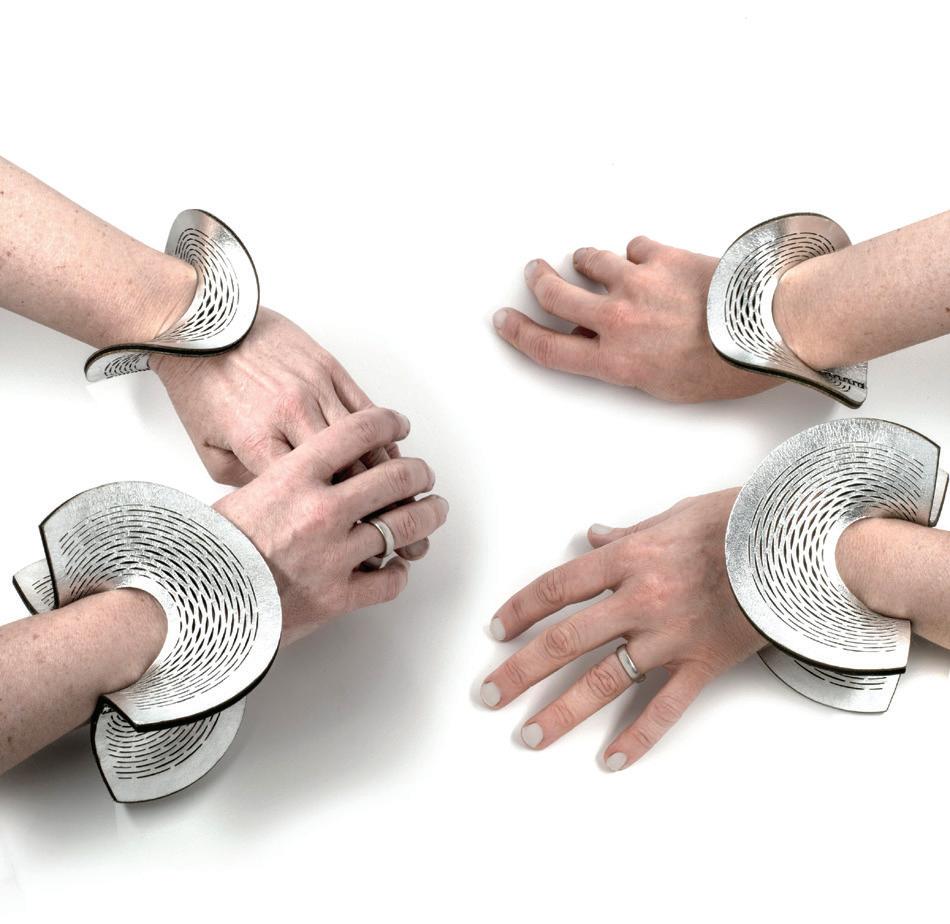



64 edible New Mexico | EARLY SUMMER 2023
new interpretation of his heritage. In the short documentary film Becoming: Orlando Dugi, Dugi reflects on the influence of plant life in his work. “I’ve been thinking of farming and gardening a lot lately. I use a lot of floral motifs. When you look through a garden, you really look at the stems, the plants, how they really curl around something. It’s really beautiful to see. So, I like to mix those kinds of things into my work.”
The animals I hunt and their habitats are the inspiration for my launch into fashion design. Nature, the wisest designer, informs the shapes, textures, and movement of the garments.
With the knives in place on the kitchen counter, I heave the elk hide onto the tile, fur side down. I peel the folds back to reveal the underside of her skin, still fresh and moist, dotted with Ponderosa needles, specks of soil, and tiny blades of dormant grass from where she lay as I dressed and quartered her near Cabresto Creek north of Questa.
Years ago, as a college student, I learned the craft of fleshing hides at a hunting lodge in my home state of Alaska. There I would process caribou, bear, moose, and Dall sheep. The skills I learned thirty years ago remain relevant, vivid. Today I clean and prepare the hides of elk, deer, and oryx. They have become material stories that grace the back of the couch, the office chair, and bancos in our home.
The cutting is slow, methodical, meticulous. I place one hand beneath the hide to feel its thickness and know how light or heavy a cut needs to be. The skin at the neck and rump is much thicker, tougher than the thin, tender skin at the belly. The health of this elk is palpable; her gleaming plump tissue and substantial, dense hair feel alive in my palms. I will get to know her intimately, from the inside out, as I continue slicing away meaty tissue to prepare her for tanning.
“They all go to the dump,” the woman at A&M Meat Processing in Alamogordo tells me. “Yeah, about fifteen cowhides a week and about eight hundred to nine hundred wild game hides a month during hunting season. They all get tossed. Unless a hunter wants to keep one.”
“You mean the hides that could be processed into leather are thrown away?” I ask.
“Yes,” she says, explaining, “there’s no tannery here or way to process them.”
So where do leather crafters like Dwight Lamberson of DL LeatherWorks in Albuquerque source their materials?
“I buy leather from a lot of distributors. I really have no idea where it comes from,” says Lamberson, who resuscitated his love and practice of leather crafting about five years ago, making all kinds of pieces including handbags, wallets, and belts. “Small beef processors have no outlet. Much of the leather comes from Mexico, Europe, and Brazil.”
A by-product of the food industry, leather is a $100 billion worldwide trade. Although leather use dates back at least four hundred thousand years, most of the leather shoes, jackets, and armchairs that humans wear and use today are made from hides produced in places and ways that have no personal or geographic connection to the wearer. In 2016, the United States produced over thirty million hides from cattle, about four million pigskins, and just over two million sheep and goat hides.
R. L. Cox, an Albuquerque company specializing in leather and fur products since the 1920s, offers raw leather made from cow, lamb, pig, sheep, deer, and elk, as well as fox, coyote, bobcat, and other furs. While most of the leather and fur materials are shipped from within the United States, some are imported from countries such as Tibet, Iceland, and New Zealand. Co-owner Ellen Goodson describes the vast uses of various leathers, from crafts and clothing to moccasins, purses, and traditional Native American regalia. Whether traditional or contemporary, leather persists as a staple fashion foundation— which makes it all the more stunning that so many hides are wasted rather than integrated into local supply chain economies.
Still in my kitchen, I finish fleshing the elk’s hide, imagining how her meat will sustain me, how her body will adorn mine.
When the hide is ready, I sprinkle coarse salt on it, covering all areas and rubbing it in as I go. This will help draw out moisture and residual blood in preparation for shipping. To shield the hide from predators, wind, and direct sun, I lay large pieces of cardboard on top of the two freezers in the shade of the portal, then hoist the cleaned hide to the protected, elevated hideaway.
Over the course of about five to seven days, I check on the elk, continuing to rub salt on her surface and into all edges and crevices. Residual moisture drips down the surface of the freezers in sinuous trails. Trickles of pale red fluid mixed with salt collect in crusty puddles on the portal floor.
Then, when she’s ready to be tanned, I crumple multiple wads of newspaper on her skin, roll her into herself, wrap the bundle with more newspaper, pack her in a box, and kiss her farewell as I ship her two states away.
Working out of their Albuquerque studio, Karole Mazeika and Grady Jaynes of Oropopo have been imagining and handcrafting leather wrist cuffs, earrings, necklaces, and sculptural pieces like seedpod wall hangings for seven years. Although the wife-andhusband team source their leather from a world-renowned company back east, rather than locally, they feel their work is rooted in place. Mazeika’s training as an architect and structural engineer influences
65 EDIBLENM.COM
~
~
~
~
From top left, clockwise: Suit with elk fur and ivory accents and blouse with elk heart–inspired fabric—designed by Christie Green, sewn by Lorraine Gruys, photo by Peter Ogilvie; skirt saddle bracelets by Oropopo, photo courtesy of Oropopo; seedpod wall hanging by Oropopo, photo courtesy of Oropopo; Patricia Michaels design, photo by Jusua Tso; Patricia Michaels design, photo by Bill Curry.
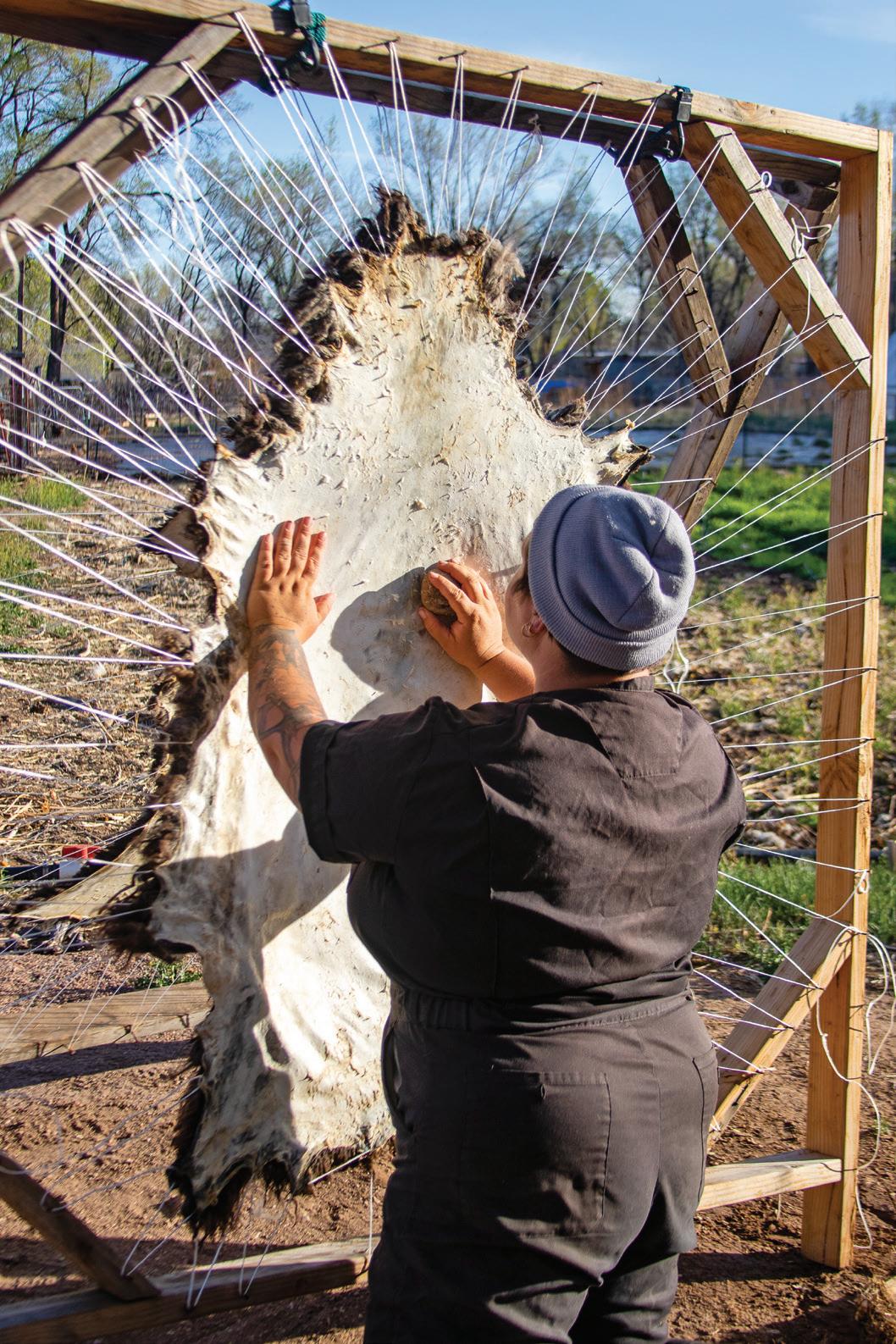

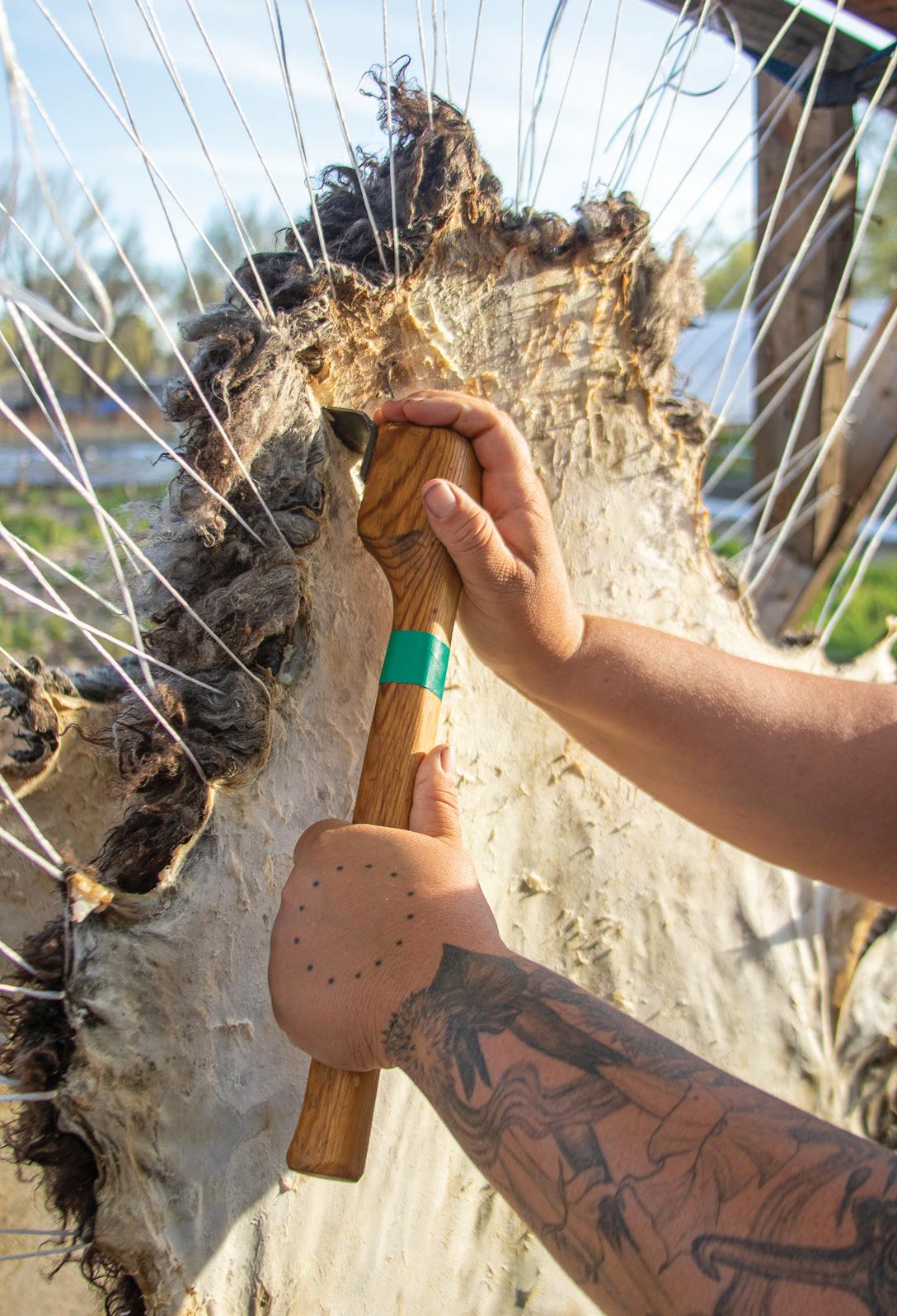

66 edible New Mexico | EARLY SUMMER 2023
the form and function of each piece. “While I really enjoyed it,” Mazeika says of her career in architecture, “I got a little frustrated not being able to actually build things. I learn on my own by making things with my hands.”
The pair’s distinctive, deeply contemporary work takes inspiration from the landscape. Milkweed, cottonwood, rain clouds, ocotillo, and oryx are among the New Mexico landscape features and animals that shape their line of laser-cut, hand-assembled leather.
The essence of veined leaves emanates from gold-dyed leather earrings, honoring the autumnal gilded glory of the bosque. Finely calculated curls of black-and-white leather mimic dramatic oryx horns, forming a striking blossom cluster of a necklace. “Each of our pieces has a story. And each is a form of celebration. Leather is the oldest material of self-adornment. . . . but with newer technology and imbuing it with place, site, time, and culture. We produce an ornament that has significance for the wearer beyond what we give it. Women feel that it is a shield, armor, a source of power. I love that,” beams Mazeika.
“I’ve been asking questions like, ‘What is home? What is belonging? What are borders? What is land? What is stolen land? What is the world we live in?’ Coming into hide tanning has been a process of trying to understand what it means to be a visitor of this place and it’s been a practice of reparation,” Marissa Sieck shares on a call from Chispas Farm in Albuquerque’s South Valley.
Sieck has lived at the farm with their partner, and in community relationship with others who help there, for almost five years. More recently, they have begun to provide hand-tanning services and workshops in addition to co-stewarding the land they live on.
“We have dairy goats and a small herd of sheep,” Sieck says. “As I’ve been learning hide tanning, I have integrated meat and dairy and fiber animals on the farm. We have meat rabbits, so that’s the main process that I’m a part of. It’s like this death practice. We’ll share the meat with the people who take care of the land here, the farmers, and then anything left over we sell or give away.” Working with the farm’s domestic animals, Sieck tans hides for their use, to share with others and to sell. “People also come to me with domestic and wild hides. I’ll be working with a couple of teenagers who harvested an elk with a bow this past year. Eating that elk meat and tanning those hides will be such a wonderful experience.”
Sieck tells me that making connections with New Mexico ranchers and farmers through the practice of tanning has been an unexpected gift. “People will just reach out and tell me they’ve had these animal hides but didn’t know what to do with them. So I either teach them how to do it or do the tanning for them.” Reflecting on the unlikely intersections that have evolved through tanning, Sieck says, “It feels so connected and is a real bridge across identities and difference. I’m
a nonbinary, queer, white settler and I get to just hang out with people who really love their animals and welcome me into their home. There’s a softening that happens through building relationships that way and I really love it.”
Sieck’s tanning workshops attract participants from many places and of diverse ages. “People come to the workshops, and everyone works on their own hide and then they take that home. These pieces bring their stories out. A lot of people who come are Diné. I try to provide a free workshop for everyone who needs a space. That feels important. . . . It has been a very emotional experience. I’ve found that people are showing up because they love their animals, or they didn’t have access to this kind of learning before. Grief around loss of who we are is evident.”
Although tanning is very much a hands-on, tactile, and utilitarian practice, Sieck emphasizes its significance, symbolism, and potential impact for meaningful healing. “There’s a slow rippling impact that I’m most interested in,” they say. “There are more hides than I can do as one person. This is rooted in mutual aid and community building. It’s a practice of how to do this in an anti-capitalistic way and support each other instead of being in competition.”
Roosters crow in the background as our call ends, and Sieck says something that will echo and reverberate inside me: “I can feel the sheep are taking care of me.”
Seven months later, the elk returns home from the tannery. Now she feels supple, like smooth, buttery suede. Her hair is clean, soft. Colors blend and converge like caramel ombré from her back to her rump and down her flanks. As I move my palms across her, I imagine again how I will wear her.
I decide on simple accentuation for a black tailored jacket and trousers. The elk will be the ultimate refinement for this classic silhouette. I craft textured earrings from fine strands of hair from her rump, held by shiny, silver hardware. The crimped tufts dangle from my ears, her hair tangling with mine.
Her two polished ivories (eyeteeth) punctuate the waistline of the pants, a shiny off-white contrast to the matte black. I select parts of her hide from her belly and neck to trim and tack onto the jacket lapels. Drilling holes into two of her toes, I sew them on the sleeves as mock cuff links. Lastly, a thin, round button honed from a scapula bone becomes the button on the front of the jacket.
To complement the ensemble, I design silk fabric for a deep red blouse whose print is imbued with the colors and textures of her heart—bruised blue, indigo, ripe scarlet. As I ease my arms into the sleeves and button the blouse around my chest, I feel the pulse of her, inside me.
She envelopes me, body to body, blending her story with mine.
67 EDIBLENM.COM
~
~
From top left, clockwise: Marissa Sieck tanning a sheep hide in the field at Chispas Farm; salted sheep, elk, deer, antelope, and goat pelts; sheep hide being tanned; Sieck with finished sheep hide. Photos by Stephanie Cameron.
LOCAL SOURCE GUIDE
CANNABIS
Carver Family Farm
No-till, hand-trimmed, organically grown cannabis producer and dispensary. 8917 Adams, Albuquerque, 505-508-5910, carverfamilyfarm.com
KURE
We pride ourselves on providing a unique, friendly, and welcoming environment. 220 N Guadalupe, Santa Fe, 505-930-5339, kureforlife.com
The Herb Taxi
Local cannabis delivery for medical and recreational consumers. theherbtaxi.com
FOOD ARTISANS / RETAILERS
Barrio Brinery
Bringing fine fermented foods to Santa Fe. 1413-B W Alameda, Santa Fe, 505-699-9812, barriobrinery.com
Bountiful Cow Cheese Company
Purveyors of fine cheese, meats, and provisions from around the world. 505-473-7911, B-cow.com
Del Valle Pecans
From our southern New Mexico orchards to your kitchen. Order online. 575-524-1867, delvallepecans.com
Eldora Chocolate
Eldora crafts chocolate using natural, organic, and fair-trade ingredients. 8114 Edith NE, Albuquerque, 505-433-4076, eldorachocolate.com
Heidi's Raspberry Farm
Sumptuous, organic raspberry jams available throughout New Mexico and online! 505-898-1784, heidisraspberryfarm.com
La Montañita Co-op
New Mexico's largest community-owned, natural, and organic food market. Locations in Albuquerque, Gallup, and Santa Fe. lamontanita.coop
New Mexico Harvest
A community of people that actively invests in our food system. Eat local. Eat seasonal. Eat outside the box stores. Delivering across New Mexico. newmexicoharvest.com
Owl Peak Farm
Grains grown and milled in La Madera. Order online at owlpeakfarm.com
Skarsgard Farms
Delivering fresh, local, and organically grown produce and natural groceries to doorsteps across New Mexico. 505-681-4060, skarsgardfarms.com
Susan's Fine Wine & Spirits
Your local liquor store in Santa Fe. 632 Auga Fria, sfwineandspirits.com
The Mouse Hole Cheese Shop
Itty-bitty cheese shop in ABQ.
300 Broadway NE, Ste A, Albuquerque, 505-554-2994, mouseholeabq.square.site
Vigil's Beef Jerky
All natural, preservative free, and made with only the best local ingredients.
7625 Second Street NW, Albuquerque, 505-867-3283, vigilsbeefjerky.com
HEALTH & WELLNESS
Daisy's Holistic Health
We offer a wide range of herbs, vitamins, supplements, and high-pH H2O. 4056 Cerrillos, Unit D-1, Santa Fe, 505-780-8687, daisysholistichealth.com
Desert Sol Alchemy
Acupuncture and classical Chinese medicine. Now accepting patients in Albuquerque and Santa Fe. 505-475-7855, desertsolalchemy.com
SageWork Organics
Topical magnesium, herbal remedies, and more. 5401 Lomas NE, Ste D, Albuquerque, sageworkorganics.com
LODGING
Heritage Hotels and Resorts
Hotels in Albuquerque, Santa Fe, Taos, and Las Cruces. hhandr.com
Los Poblanos Historic Inn & Organic Farm
4803 Rio Grande NW, Los Ranchos de Albuquerque, 505-344-9297, lospoblanos.com
Rosewood Inn of the Anasazi
113 Washington, Santa Fe, 505-988-3030
Sarabande B & B
5637 Rio Grande NW, Albuquerque, 505-348-5593, sarabandebnb.com
The Parador
220 W Manhattan, Santa Fe, 505-988-1177, elparadero.com
NURSERIES & SERVICES
Alameda Greenhouse
Veggies, fruit trees, flowers, shrubs, and perennials. 9515 Fourth Street NW, Albuquerque, 505-898-3562, alamedagreenhouseabq.com
Grow Y’Own
Year-round cedar raised beds with hoops and covers. 505-466-0393, raisedbed.biz
Osuna Nursery
A family-owned and -operated nursery, gardening center, and landscaping company. 501 Osuna NE, Albuquerque, 505-345-6644, osunanursery.com
Payne’s Nursery
Payne’s North, 304 Camino Alire, 505-988-8011; Payne’s South, 715 St Michael’s, 505-988-626; Payne’s Organic Soil Yard, 6037 Agua Fria, 505-424-0336; Paynes.com
ORGANIZATIONS & EDUCATION
Museum of New Mexico Foundation
Philanthropic support for our state’s cultural heritage. museumfoundation.org
Slow Food Santa Fe
Slow Food is about enjoying food and the community it creates. Intrigued? Learn more at slowfoodsantafe.org.
OTHER SERVICES
Rio Grande Credit Union Multiple locations in Albuquerque. riograndecu.org
RETAILERS
Black Diamond Curio
Modern mercantile in downtown Santa Fe. 219 W San Francisco, Santa Fe, 505-390-2025, blackdiamondcurio.com
Flyby Provisions
Enjoy shopping for boutique local New Mexico gifts—thoughtfully selected and packaged with care. 201 Coal SW, Albuquerque, flybyprovisions.com
Gallery Ethnica
Live globally! 1301 Cerrillos, Santa Fe, 505-557-6654, galleryethnica.com
Kei & Molly Textiles
Hand-printed kitchen linens and curated gifts. 4400 Silver SE, Ste A, Albuquerque, keiandmolly.com
Kitchenality
Irresistible and gently used gourmet cooking and entertaining ware. 1222 Siler, Santa Fe, 505-471-7780, kitchenangels.org
Living Threads
100% natural ingredients from around the world. 1610 Lena, Ste D, Santa Fe, 505-663-7784, livingthreads.org
Mountain Standard Time
High-desert bodega and corner store. 504 Galisteo, Santa Fe, 505-699-1067, mtnstd.com
Poulin Marketplace
Home, decor, coffee, and tea.
8600 Pan American Fwy NE, Albuquerque, 505) 880-2555, poulinmarketplace.com
Sarabande Home
We have a passion for finding the perfect gift. 4022 Rio Grande NW, Albuquerque, 505-344-1253, sarabandehome.com
The Next Best Thing to Being There
An eclectic shop for handmade products. 1315 Mountain NW, Albuquerque, 505-433-3204, beingthereabq.com
The Perfect Gift Shoppe
The perfect place to find something for everyone. 901 Rio Grande NW, Ste D-126, Albuquerque, theperfectgiftshoppe.com
Tin-Nee-Ann Trading Co.
Family operated and family friendly since 1973. 923 Cerrillos, Santa Fe, 505-988-1630, tin-nee-ann-trading-co.myshopify.com
68 edible New Mexico | EARLY SUMMER 2023
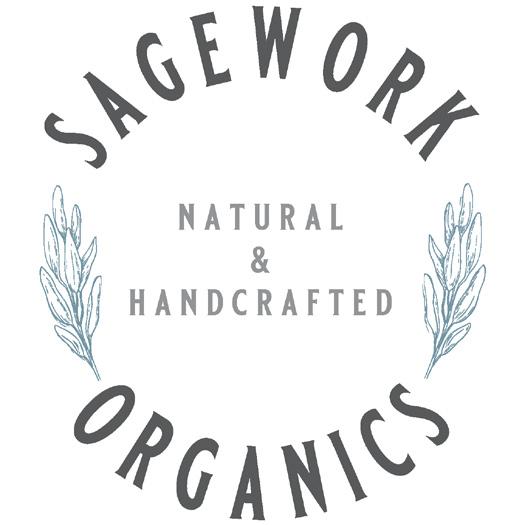










topical magnesium candles & soaps herbal remedies 5401 lomas blvd ne ste.d sageworkorganics.com Acupuncture + Classical Chinese Medicine Now accepting patients in Albuquerque + Santa Fe Desertsolalchemy@gmail.com desertsolalchemy.com | 505.475.7855 Mouse Hole CheeseShop 300 Broadway Blvd NE, Ste A, Albuquerque 505.554.2994 mouseholeabq.square.site (The Albuquerque Journal) 923 Cerrillos Road at St. Francis Dr 505.988.1630 10–5, Mon thru Sat tinneeann2@gmail.com TIN-NEE-ANN Trading Co. Family Operated - Family Friendly Since 1973 Loyal locals love us. come see why! cafecito (505) 310-0089 | 922 Shoofly St. SF, NM cafecitosantafe.com | @cafecito.santafe BREAKFAST, LUNCH, DINNER & BRUNCH Daisy’s takes a unique approach to Holistic Health. We offer a wide range of Bulk Herbs, Vitamins, Supplements, and High pH H2O. 4056 Cerrillos Road, Unit D-1, Santa Fe daisysholistichealth.com ∙ 505-780-8687 Daisy’s Holistic Health is locally owned and dedicated to great customer service. 225 East Marcy St natural wine · coffee · all day menu ·· now open ··
ALBUQUERQUE RESTAURANTS

Campo at Los Poblanos
Historic Inn & Organic Farm
Rio Grande Valley cuisine rooted in seasonal organic ingredients from our own farm. 4803 Rio Grande NW, 505-344-9297, lospoblanos.com

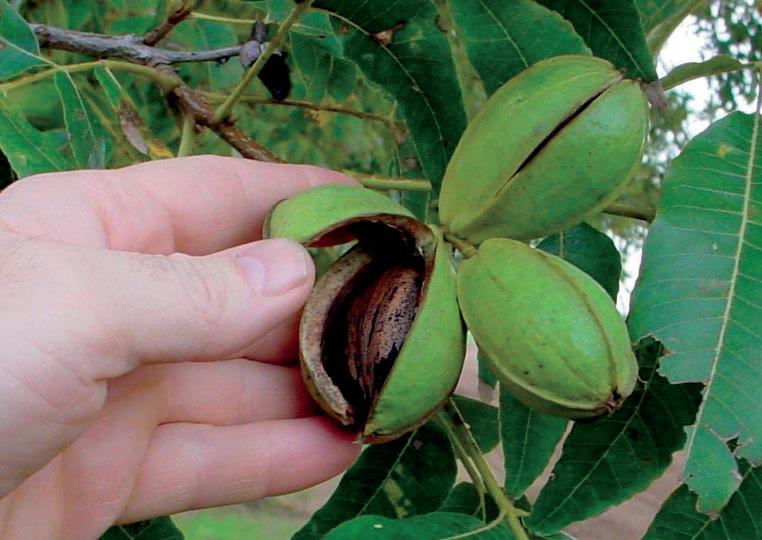
Cutbow Coffee
One of the nation’s most accomplished artisan coffee roasters, Paul Gallegos. 1208 Rio Grande NW, 505-355-5563, cutbowcoffee.com
Farm & Table
Enjoy delectable seasonal dishes created from scratch, sourced from local farmers and our beautiful on-site farm. 8917 Fourth Street NW, 505-503-7124, farmandtablenm.com
Grassburger
The feel-good, award-winning burger—100% grassfed beef, vegan, or poultry!

11225 Montgomery, 505-200-0571, and 5600 Coors NW, Ste 3, 505-361-2368, eatgrassburger.com
Mata G Vegetarian Kitchen
International vegan and vegetarian cuisine. 116 Amherst SE, 505-266-6374, mata-g.com
Mesa Provisions
A playful, Southwest-inspired menu. 3120 Central SE, Albuquerque, 505-494-5264, mesaprovisions.com
B URGERS D FRIES
Savoy Bar & Grill
California wine country in the Northeast Heights. Farm-to-table dining and a casual patio. 10601 Montgomery NE, 505-294-9463, savoyabq.com

Sawmill Market
Eclectic collection of bars and eateries, plus an expansive courtyard. 1909 Bellamah NW, sawmillmarket.com
Seasons Rotisserie & Grill
Oak-fired grill, local and seasonal ingredi
ents, and the best patio dining in Old Town. 2031 Mountain NW, 505-766-5100, seasonsabq.com
The Grove Cafe & Market
The Grove features a bustling café experience serving breakfast, brunch, and lunch. 600 Central SE, 505-248-9800, thegrovecafemarket.com
The Shop Breakfast & Lunch
Serving breakfast and lunch Wednesday through Sunday. 2933 Monte Vista NE, 505-433-2795, theshopabq.com
Trifecta Coffee Company
We roast coffee and brew in unique ways. 413 Montaño NE, 505-803-7579, trifectacoffeeco.com
SANTA FE RESTAURANTS
Anasazi Restaurant & Bar
Contemporary American cuisine inspired by locally sourced seasonal ingredients. 113 Washington, 505-988-3030, innoftheanasazi.com
Arroyo Vino
We serve progressive American fare inspired by our on-premise garden and local purveyors. 218 Camino La Tierra, 505-983-2100, arroyovino.com
Cafecito
Cafecito is a family-owned business blending cultures to bring you a delicious menu in a beautiful gathering space. 922 Shoofly, 505-310-0089, cafecitosantafe.com
Cafe Fina
Casual counter-serve café offering New American fare. 624 Old Las Vegas Hwy, 505466-3886, cafefinasantafe.com
Iconik Coffee Roasters
Amazing food, unique coffees roasted on-site, and superfast high-speed internet. 314 S Guadalupe, 1600 Lena, 1366 Cerrillos, 505-428-0996, iconikcoffee.com
La Casa Sena
Mediterranean-inspired cuisine, craft cocktails, and an award-winning wine list, located in the beautiful courtyard oasis of historic Sena Plaza. 125 East Palace, 505-988-9232, lacasasena.com
70 edible New Mexico | EARLY SUMMER 2023
-
GRASS-FED & DARN HEALTHY www.grassburger.com
Aw d winn since 2017
F resh and sweet organic pecans , F rom our southern new mexico orchards to your kitchen order online at delvallepecans com 575.524.1867
La Mama Santa Fe
Coffee, natural wine, all-day menu, grocery, and flowers. 225 East Marcy Street, lamamasantafe.com

Loyal Hound
Locally sourced modern comfort food paired with craft beer, cider, and wine. 730 St Michaels, 505-471-0440, loyalhoundpub.com
Ohori’s Coffee Roasters
Locally roasted coffee beans, gifts, and gathering. 505 Cerrillos and 1098 St Francis, 505-982-9692, ohoriscoffee.com

Paper Dosa
Bringing fresh, authentic homestyle South Indian dishes to your table. 551 W Cordova, 505-930-5521, paper-dosa.com
Pranzo Italian Grill
Upscale Italian cuisine. 321 Johnson, 505-984-2645, pranzoitaliangrill.com
Radish & Rye
Farm-inspired cuisine: simple yet innovative food and drinks sourced locally whenever possible. 505 Cerrillos, 505-930-5325, radishandrye.com
Rio Chama Prime Steakhouse
Refined ranch space known for prime rib and filet mignon along with a popular bar and happy hour. 414 Old Santa Fe Trail, 505-955-0765, riochamasantafe.com
Daily Brunch: 8am–3pm, Tues–Sun Dinner (take-out only): 4pm–8pm, Tues–Sat
624 Old Las Vegas Hwy, Santa Fe 505 466-3886 cafe nasantafe.com
Rustica
Sophisticated yet casual—Rustica serves fresh, homemade Italian food. 2547 Camino Entrada, 505-780-5279, rusticasantafe.com
TerraCotta


Seasonally changing, globally inspired cuisine and an extensive, value-priced wine list. 304 Johnson, 505-989-1166, terracottawinebistro.com
The Compound Restaurant
Chef Mark Kiffin preserves a landmark tradition of elegant food and service at his Canyon Road institution. 653 Canyon Road, 505-982-4353, compoundrestaurant.com
Wild Leaven Bakery
Artisan sourdough bread and baked goods using organic, local grains and ingredients. 130 N Guadalupe, wildleavenbakery.com
Genuine Food & Drink
Enchanting, Dusty... Wild West Style
28 MAIN STREET LOS CERRILLOS
505.438.1821
Thursday - Sunday blackbirdsaloon.com
200 N Bullard St, Silver City, 575-956-6144, and 119 N Main St, Las Cruces, 575-556-9934, littletoadcreek.com



Pajarito Brewpub & Grill
Open for lunch Tuesday–Sunday. Open for dinner every day. 30 craft beers on tap. 614 Trinity Dr, Los Alamos, 505-662-8877, pajaritobrewpubandgrill.com
Pig + Fig
Comfort food for everyone using highquality, ethically sourced, seasonal ingredients. 11 Sherwood Blvd, White Rock, 505-672-2742, pigandfigcafe.com
Prairie Hill Café
Local farm-to-table restaurant that serves classic Americana comfort food with an epicurean flare. 230 Plaza St, Las Vegas, 505-434-0022, prairiehillcafe.com
GREATER
NEW
MEXICO RESTAURANTS
Black Bird Saloon
Genuine food and drink, Wild West style. 28 Main St, Los Cerrillos, 505-438-1821, blackbirdsaloon.com
Blades’ Bistro
Chef Kevin Bladergroen brings together fine and fresh ingredients, artistic vision, and European flair in every dish. 221 Hwy 165, Placitas, 505-771-0695, bladesbistro.com
Little Toad Creek Brewery & Distillery Taste Southwest New Mexico.
Rancho de Chimayó
Famous for its signature dishes of spicy guacamole, hand-rolled tamales, blue corn enchiladas, carne adovada, and chile rellenos. 300 Santa Fe County Road 98, Chimayó, 505-351-4444, ranchodechimayo.com
The Skillet
American, Southwest, vegetarian friendly. 619 Twelfth Street, Las Vegas, 505-563-0477, giant-skillet.com
Wild Leaven Bakery
216 Paseo Del Pueblo Norte, Taos, wildleavenbakery.com
71 EDIBLENM.COM







SLOWFOODSANTAFE.ORG SANTA FE Linking the pleasure of good food with local community. Barrio Brinery SANTAFE NewMexico Santa Fe's source for fine fermented foods. Our lacto-fermented pickles, sauerkraut, and escabeche are hand-crafted in small batches. 1413-B West Alameda, Santa Fe www.barriobrinery.com ∙ 505-699-9812 413 Montano NE, Albuquerque 505-803-7579, trifectacoffeeco.com We roast coffee and brew it uniquely, utilizing some of the best methods available. All our baked goods, sweet and savory, are made in-house. TRIFECT A COFFEE COMP ANY Chef and owner Kevin Bladergroen brings together fresh ingredients, artistic vision, and European flair in every dish. Award-winning wine list. Creative Casual Cuisine 221 Highway 165, Placitas 505-771-0695, www.bladesbistro.com www.b-cow.com 505-473-7911 Est. 1984 Wholesale Specialty Cheese/Meats/Provisions 300+ Cheeses from around the World Your grass. Our gas. Brought to you by your amigos at TheHerbTaxi.com

June 2-10, 2023
Guide to Toast-worthy Celebrations across the Land of Enchantment
PRESENTED BY THE LIQUID MUSE AND EDIBLE NEW MEXICO

Patrón Paloma
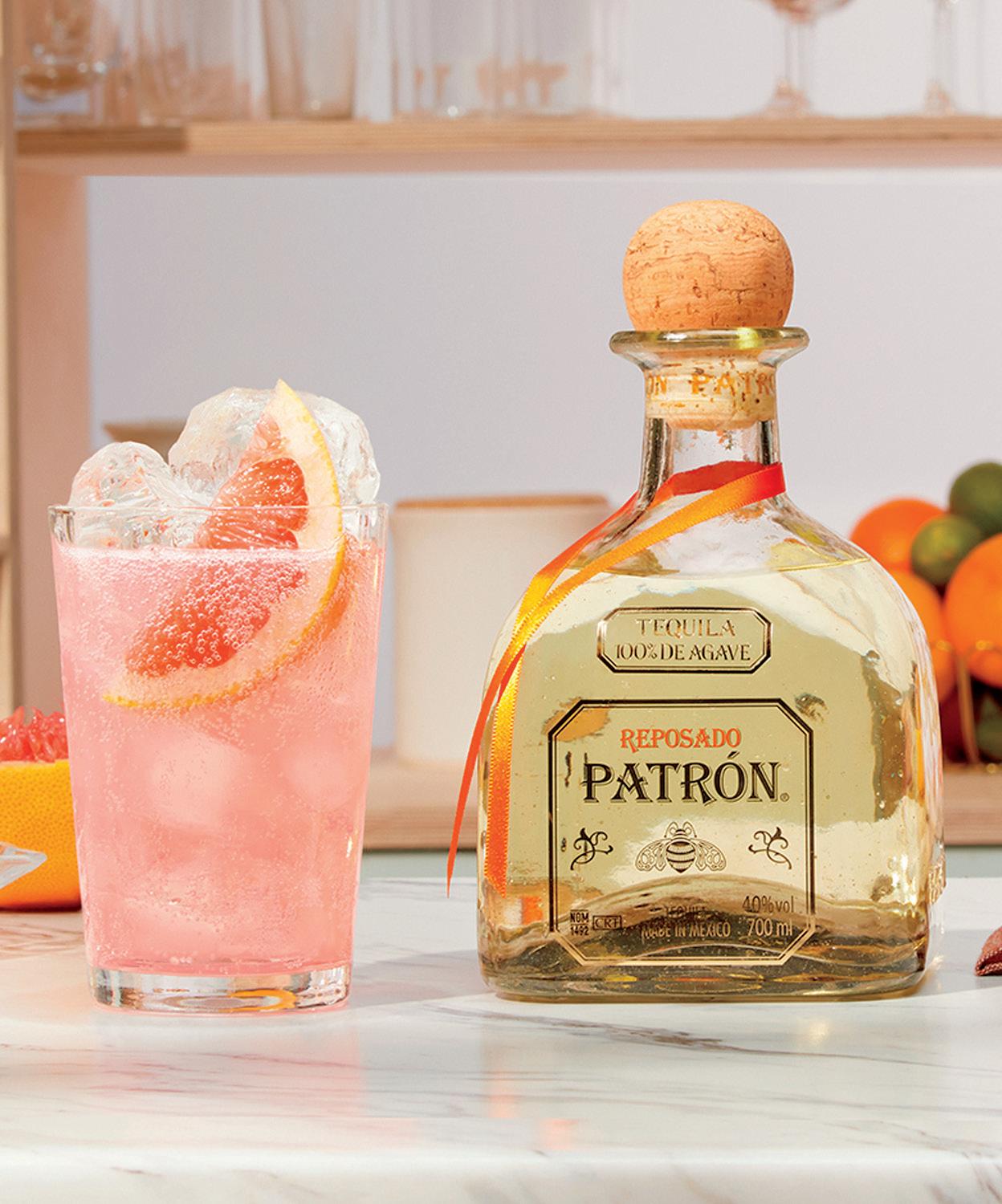
1 1/2 ounces Patrón Reposado tequila

1/2 ounce simple syrup
1 ounce lime juice, fresh squeezed
4–5 ounces grapefruit soda
Grapefruit salt rim
Grapefruit slice, for garnish
Rub a lime wedge on the rim of a tall glass, then dip it in a sea salt and dried grapefruit dust mixture. Fill the glass with ice, add ingredients. Garnish with fresh grapefruit slice.
St~Germain Spritz
1 1/2 ounces St-Germain
2 ounces Martini prosecco
2 ounces soda water
Lemon twist for garnish
Pour St-Germain over ice into glass. Top with prosecco and soda water. Give the drink a good stir. Gently twist lemon peel on top of drink, and serve with edible flowers (optional).

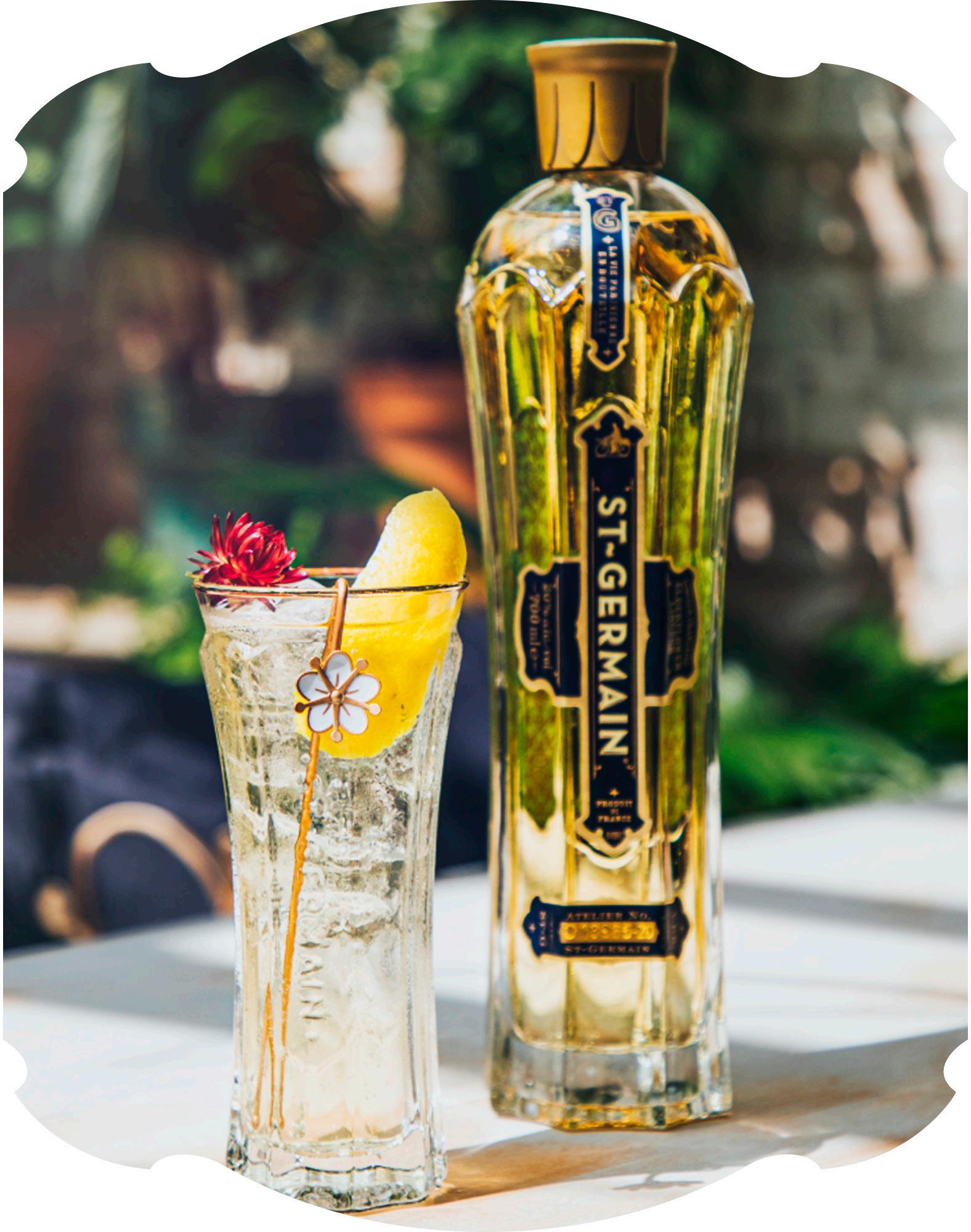
PATRONTEQUILA.COM STGERMAINLIQUEUR.COM
Cocktails & Culture Festival
June 3–5 in Santa Fe
BY THE LIQUID MUSE EVENTS
TACO WARS
June 3, 1–4 pm
201 W Marcy (Santa Fe Convention Center Rooftop Terrace)
Details and tickets: NMCocktailWeek.com
SUNSET TERRACE
Rest & Digest Yoga Brunch
June 4, 9 am
Emily Branden yoga, sound bath, and sumptuous brunch featuring Hendrick’s gin
Details and tickets: NMCocktailWeek.com
SUNSET TERRACE
Mixology Seminars
June 4, 10:30 - 5:30 pm
Special tastings and classes by visiting experts from William Grant & Sons, Beam Suntory, Patron tequila, Bacardi brands
Details and tickets: NMCocktailWeek.com
PALACE PRIME
Four Course Chef & Shaker Dinner
June 4, 6:30 pm and 7:15 pm
Featuring: Chef Doug Hesselgesser with Roku gin, El Tesoro tequila, Knob Creek rye, Maker’s Mark bourbon

142 W Palace
Details and tickets: palaceprimesf.com
SUNSET TERRACE
Five Course Chef & Shaker Dinner
June 5, 6:30 pm
Featuring: Chef Dale Kester (Santacafé) and Consulting Chef Dakota Weiss (Coyote Cafe) with Patrón tequila,
Angel’s Envy and Teeling whiskeys, Santa Teresa rum
112 W San Francisco, Ste #310
Details and tickets: santafesunsetterrace.com
SPECIAL ADVERTISING SECTION
nmcocktailweek.com #NMCOCKTAILWEEK
drink
Please
responsibly.
Peaches & Cream
By the Vara Vinoteca Bar Team


Grilled peaches, 6–8 small chunks
8 mint leaves
3/4 ounce honey syrup
1 ounce lemon juice
1 1/2 ounces Vara Fine Alembic brandy
2 ounces Vara Silverhead Brut
Mascarpone and sea salt foam
Mint sprig, for garnish
Muddle peaches and mint in cocktail shaker. Add syrup, lemon juice, and brandy, then shake with ice. Strain into a chilled ice-filled collins glass. Top with Brut and mascarpone and sea salt foam. Add a mint sprig.

Pearl Jam
By Nidia Galindo-Coronado
2 ounces Four Pillars Rare Dry Gin
1/2 ounce green Chartreuse liqueur
1/2 ounce fresh lime juice
1/2 ounce simple syrup
4 ounces tonic water
Splash of butterfly pea flower water
Sour apple sugar rim
Encapsulated lemon pearls, for garnish
Rub rim of a highball glass with a lime wedge. Dip into sour apple sugar. Place a large rock of ice and one tablespoon of encapsulated lemon pearls into glass. Shake gin, liqueur, lime juice, and syrup with ice, then pour into glass. Top with tonic. Finish with butterfly pea flower water.

VARA WINERY & DISTILLERY 329 W San Francisco, Santa Fe 505-898-6280, varawines.com SASSELLA 225 Johnson, Santa Fe 505-982-6734, sassellasantafe.com
Calendar of Events
June 3
1–4 pm
TACO WARS
Vote top taco and sample cocktails. 21+ only. Santa Fe Convention Center Rooftop Terrace
201 W Marcy, Santa Fe NMCocktailWeek.com
June 6
6:30 pm
VERNON’S SPEAKEASY COCKTAIL CLASS with light hors d’oeuvres and take home bar tools
6855 Fourth Street NW, Albuquerque 505-341-0831, yougottapassword.com
June 7
7–10 pm
PRAIRIE HILL CAFÉ & BYRON T’S SALOON
LIVE MUSIC with Strings Attached 230 Plaza St, Las Vegas 505-434-0022, prairiehillcafe.com
June 4
9 am
REST & DIGEST YOGA BRUNCH
Emily Branden yoga, sound bath, and sumptuous brunch featuring Hendrick’s gin
Sunset Terrace, 112 W San Francisco, Ste #310, Santa Fe NMCocktailWeek.com
10:30–5:30 pm
MIXOLOGY SEMINARS
Sunset Terrace, 112 W San Francisco, Ste #310, Santa Fe NMCocktailWeek.com
6:30 pm and 7:15 pm
CHEF & SHAKER DINNER AT PALACE PRIME featuring Roku gin, Knob Creek rye, El Tesoro tequila, and Maker’s Mark bourbon
142 W Palace, Santa Fe palaceprimesf.com
June 8
3 pm
STILL SPIRITS DISTILLERY COCKTAIL CLASS 120 Marble NW, Albuquerque, 505-203-6626 @stillspirits
6:30 pm
VERNON’S SPEAKEASY COCKTAIL PAIRING
DINNER 6855 Fourth Street NW, Albuquerque, 505-341-0831, yougottapassword.com
6:30 pm
RESTAURANT MARTÍN COCKTAIL PAIRING
DINNER 526 Galisteo, Santa Fe, 505-820-0919, restaurantmartin.com
6:30 pm
THE SKILLET LIVE MUSIC by Mineral Hill followed by late-night karaoke. 623 Twelfth Street, Las Vegas, 505-563-0477, giant-skillet.com
June 5
6:30 pm
CHEF & SHAKER DINNER AT SUNSET TERRACE featuring St-Germain liqueur, Patrón tequila, Angel’s Envy and Teeling whiskeys, and Santa Teresa rum
112 W San Francisco, Ste #310, Santa Fe, santafesunsetterrace.com
7 pm
FARM & TABLE 11TH BIRTHDAY
DINNER: five-course cocktail pairing dinner on the farm. 8917 Fourth Street NW, Albuquerque 505-503-7124, farmandtablenm.com
Get all the details at nmcocktailweek.com
June 10
12 pm
LA BOCA SHERRY COCKTAIL CLASS AND TASTING
72 W Marcy, Santa Fe, 505-982-3433, labocasantafe.com
3 pm
THE SKILLET BACKYARD BEACH PARTY with five courses of food and cocktail pairings plus live entertainment
623 Twelfth Street, Las Vegas, 505-563-0477, giant-skillet.com
4–5:15 pm
PRAIRIE HILL CAFE & BYRON T’S SALOON
AMOR AND AMARI, AMARO CLASS AND TASTING
230 Plaza St, Las Vegas, 505-434-0022, prairiehillcafe.com
7–10 pm
PRAIRIE HILL CAFE & BYRON T’S SALOON LIVE MUSIC with Zay Santos “An Outlaw Tribute to Byron T” 230 Plaza St, Las Vegas, 505-434-0022, prairiehillcafe.com
7 pm–12 am
OPUNTIA CAFE DANCE PARTY
1607 Alcaldesa, Santa Fe, 505-221-1112, opuntia.cafe
SPECIAL ADVERTISING SECTION
Garden Martin-i
By David Pecorari
1 3/4 ounces Tumbleroot High Desert Gin
1/3 ounce tarragon-infused Yukikage sake
1/4 ounce Oka Kura Bermutto
1 ounce tomato water
Lemon peel
Dehydrated tomato and lemon peel, for garnish
Stir ingredients with ice and strain into a cocktail glass. For best results, prebatch the liquid components and store in a freezer before making. Express lemon peel over cocktail, then discard. Garnish with a dehydrated tomato.
Pineapple Upside-Down Cake
By X Johnson
1 1/2 ounces Tahitian vanilla–infused Expedition vodka

1 ounce pineapple juice
1/2 ounce cane simple syrup
2–3 dashes of cherry bitters
Almond foam, for garnish
Shake vodka, juice, syrup, and bitters with ice, and strain into a cocktail glass. Top with almond foam.
June 8, 6:30 pm: Four-Course Cocktail Pairing Dinner


526 Galisteo, Santa Fe, restaurantmartin.com

RESTAURANT MARTÍN
SANTA FE SPIRITS 308 Read, Santa Fe, 505-780-5906, santafespirits.com
Featured Cocktails
Enjoy these featured cocktails all week long at venues around the state.
SANTA FE

Featured Cocktail: MAI WORD
218 Camino La Tierra 505-983-2100, arroyovino.com
Featured Cocktail:
NEW MEXICO NEGRONI
545 Camino de la Familia 505-916-8596, aasbdistillery.com


Featured Cocktail: SOUTHWEST SIDE 201 Washington, lospoblanos.com
Featured Cocktail: THE MIRAGE
132 W Water, 505-983-1615 coyotecafe.com


*Special Cocktail Pairing Dinner Menu all week

Featured Cocktail: FLOR DE MANZANILLA
72 W Marcy, 505-982-3433 labocasantafe.com

*Signature Cocktail Menu all week
Featured Cocktail:
BAD HABITS
401 S Guadalupe, 505-467-8624 palomasantafe.com
*Special Cocktail Menu all week

Featured Cocktail: ”LA CHISME”
NONE OF YOUR BEE’S KNEES
211 Old Santa Fe Trail 505-983-7992, hotelloretto.com

Featured Cocktail: ELOTE CON CHILE MARGARITA
187 Paseo De Peralta 505-982-3033, drfieldgoods.com

Featured Cocktail: TOKYO ICED-TIKI
142 W Palace, palaceprimesf.com

Featured Cocktail: 13 GOING ON 30 1607 Alcaldesa, 505-221-1112 opuntia.cafe

Featured Cocktail: PEACHES AND CREAM
329 W San Francisco, 505-898-6280, varawines.com
Featured Cocktail: RAJA RAJA 551 W Cordova, 505-204-6626 paper-dosa.com
Featured Cocktail: GARDEN MARTIN-I 526 Galisteo, 505-820-0919 restaurantmartin.com

SPECIAL ADVERTISING SECTION
Byron T
2 ounces Rough Rider Straight Bourbon Whisky
1 ounce Atapiño Liqueur
3 big dashes Peychaud bitters
1/2 ounce Bonal Gentiane-Quina aperitif
1 cinnamon stick, for garnish
Stir over ice and strain into rocks glass with an ice sphere. Serve with a smoking cinnamon stick.

Smoky Vibes
1 1/2 ounces Dry Point agave spirit
2 ounces Verde organic grapefruit juice
1/2 ounce fresh-squeezed lime juice
1/2 ounce fresh-squeezed lemon juice
1/2 ounce mint-infused simple syrup
Dehydrated grapefruit rimmer
Mint sprig and grapefruit wedge, for garnish
Dip the rim of a margarita glass into the mint syrup, then into the grapefruit rimmer. Fill with ice and set aside. Shake agave spirit, juices, and syrup with ice in a cocktail shaker. Double strain into rimmed glass, then add mint sprig and grapefruit wedge.

PRAIRIE
June 10, 4–5:15 pm: Amor and Amari, Amaro Class and Tasting ∙ June 7, 7–10 pm: Live music with Strings
Attached ∙ June 10, 7–10 pm: Live music with Zay Santos
230 Plaza St, Historic Plaza Hotel, Las Vegas
505-434-0022, prairiehillcafe.com
THE SKILLET
June 8, 6:30 pm: Live music by Mineral Hill followed by late-night karaoke ∙ June 10, 3 pm: Backyard Beach
Party with five courses of food and cocktail pairings, plus live entertainment. 623 Twelfth Street, Las Vegas

505-563-0477, giant-skillet.com
 HILL CAFÉ & BYRON T’S SALOON
HILL CAFÉ & BYRON T’S SALOON
Featured Cocktail: CLARIFIED RUM PUNCH
113 Washington, 505-412-9907 rosewoodhotels.com
Featured Cocktail: PINEAPPLE UPSIDE-DOWN CAKE 308 Read, 505-780-5906 santafespirits.com

Featured Cocktail: RYE BAYOU 2920 Rufina, 206-708-3332 secondstreetbrewery.com
Featured Cocktail: ROSEMARY MANHATTAN

231 Washington, 505-984-1788 santacafe.com


Featured Cocktail: PEARL JAM 225 Johnson, 505-982-6734 sassellasantafe.com
Featured Cocktail: NEVER A DAHL MOMENT 632 Agua Fria, 505-363-3923 sfwineandspirits.com
SILVER CITY LAS CRUCES
Featured Cocktail: SPRING THYME
605 Canyon Road, 505-982-4353 compoundrestaurant.com

Featured Cocktail: WATERMELON JALAPEÑO MULE 200 N Bullard St, 575-956-6144 littletoadcreeek.com
LAS VEGAS

Featured Cocktail: WATERMELON JALAPEÑO MULE 119 N Main St, 575-556-9934 littletoadcreeek.com
Featured Cocktail:
CHEF’S TOMATO GARDEN MARTINI
524 Railroad Ave, 505-434-1005 kinlvnm.com
PRAIRIE HILL CAFÉ & BYRON T’S SALOON

Featured Cocktail: BYRON T 230 Plaza St, Historic Plaza Hotel 505-434-0022, prairiehillcafe.com
Featured Cocktail: SMOKY VIBES 623 Twelfth Street, 505-563-0477 giant-skillet.com
SPECIAL ADVERTISING SECTION SANTA FE cont. . .
Southwestern Sun
By Michael Gallegos
1 1/2 ounces El Tesoro Reposado Tequila

1/2 ounce Cappelletti Aperitivo
1/2 ounce Ancho Reyes
1/2 ounce house-made orgeat
3/4 ounce lime juice
3 dashes habanero bitters
Lime wheel
Combine all ingredients into a shaking tin and shake with ice. Double strain over a large cube into a rocks glass. Garnish with a lime wheel.
Flor de Jerez
By Thomas Sell
2 ounces Lillet Blanc
1 ounce Sandeman Sherry Don Fino
3 dashes Angostura bitters
3 dashes orange bitters
Orange twist, for garnish
Stir all ingredients with ice in a mixing glass. Strain into a chilled cocktail glass. Cut a fresh orange twist over the drink so oils from orange zest spray on the surface of the cocktail.

3009 Central NE, Albuquerque, zinqabq.com
June 5, 7 pm: 11th Birthday Dinner: five-course cocktail pairing dinner on the farm. 8917 Fourth Street NW, Albuquerque 505-503-7124, farmandtablenm.com
 FARM & TABLE
ZINC WINE BAR & BISTRO
FARM & TABLE
ZINC WINE BAR & BISTRO
Featured Cocktail: FLOR DE JEREZ 8917 Fourth Street NW 505-503-7124, farmandtablenm.com
Featured Cocktail: DESERT 75 120 Marble NW, 505-203-6626 @stillspirits

Featured Cocktail: LEÓN DE ALBUQUERQUE
800 Rio Grande NW, 505-843-6300 hotelabq.com





Featured Cocktail: Summer’s Harvest 125 Second Street, 858-205-9881 hotelandaluz.com
Featured Cocktails: Botanic Bar’s FLOWER POWER; Flora’s FLORA MARGARITA; West Cocktail & Wine Bar’s WEST OLD FASHIONED 1909 Bellemah NW, 505-563-4473 sawmillmarket.com
Featured Cocktail: THE BEACH CRUISER 6855 Fourth Street NW 505-341-0831
yougottapassword.com


Featured Cocktail: SUNDAY BEST 10601 Montgomery NE 505-294-9463, savoyabq.com
Featured Cocktail: MIDNIGHT ZONE 2031 Mountain NW, 505-766-5100, seasonsabq.com
*Cocktail and Food Pairings all week


Featured Cocktail: SHISO THE BEES KNEES 600 Central SW, 505-503-6722, oniabq.com
TOWN AND RANCH
Featured Cocktail: SOUTHWEST SIDE 1318 Fourth Street NW lospoblanos.com
Featured Cocktail: DUKE CITY SOUR IN RED, GREEN, OR PINK and paired with chicken wings served with red, green, or pink sauce 105 Harvard SE, 505-407-2347 505spirits.com
Featured Cocktail: SOUTHWEST SIDE 4803 Rio Grande NW, Albuquerque, lospoblanos.com
Featured Cocktail: SOUTHWESTERN SUN 3009 Central NE, 505-254-9462 zinqabq.com
SPECIAL ADVERTISING SECTION
ALBUQUERQUE
Southwest Side
By Los Poblanos
2 ounces mint-infused Los Poblanos Lavender Gin
3/4 ounce Chareau
1/2 ounce lime juice
1/2 ounce grapefruit juice
3/8 ounce Los Poblanos Lavender Simple Syrup
2 dashes Peychaud’s Bitters
Cucumber wheel with basil and mint sprigs, for garnish
Shake all ingredients with ice, then strain into a chilled coupe glass. Insert basil and mint sprigs into the cucumber wheel and slide onto rim of the glass.
Tokyo Iced-Tiki
By Todd Walker + Ashley Lynn
3/4 ounce lime and lemon juice (1:1 ratio)
1/4 ounce orgeat and honey mix (2:1)
1/2 ounce coconut oil–washed Midori
1 bar spoon Giffard apricot liqueur

1 ounce sun-soaked, green tea–infused
Salers Gentian Aperitif
1 ounce Roku gin
1/2 ounce coconut cream
2 dashes orange bitters
Shiso leaf and sesame tuile, for garnish
Fill a hurricane glass to the top with crushed ice. Combine all ingredients and dry shake in cocktail shaker, then pour into ice-filled glass. Add shiso leaf and sesame tuile.

4803 Rio Grande NW, Albuquerque, lospoblanos.com
TOWN & RANCH

1318 Fourth Street NW, Albuquerque BAR NORTE
201 Washington, Santa Fe
June 4, 6:30 pm and 7:15 pm: Chef & Shaker Dinner 142 W Palace, Santa Fe, palaceprimesf.com
 LOS POBLANOS BAR CAMPO
PALACE PRIME
LOS POBLANOS BAR CAMPO
PALACE PRIME
Blue Bell Daisy
1 1/2 ounces El Tesoro Blanco Tequila

3/4 ounce DeKuyper Triple Sec
2 ounces fresh lemon sour (equal parts simple syrup and fresh lemon juice)
1/2 ounce yellow bell pepper puree
6–8 fresh blueberries
3 blueberries on a pick or a lemon wheel, for garnish
Muddle blueberries in a mixing glass, then add remaining ingredients and shake with ice. Double strain into a chilled cocktail glass. Garnish with lemon wheel or blueberries on rim of the glass.
Join Beam Suntory’s Master Mixologist Bobby G for his cocktail seminar at Sunset Terrace and Chef & Shaker dinner at Palace Prime on June 4. Tickets available at nmcocktailweek.com.

SPECIAL ADVERTISING SECTION
ELTESOROTEQUILA.COM
Enchanted Negroni

2 parts Sigil Gin

2 parts Aradia Aperitivo
1 part Vara Vermut Dulce
1 part 505 Aristology Red Vermouth
Orange peel, for garnish
Stir gin, aperitivo, and vermouth in a mixing glass filled with ice until well chilled. Strain over a large ice cube in a rocks glass. Lay orange peel onto surface of the drink.
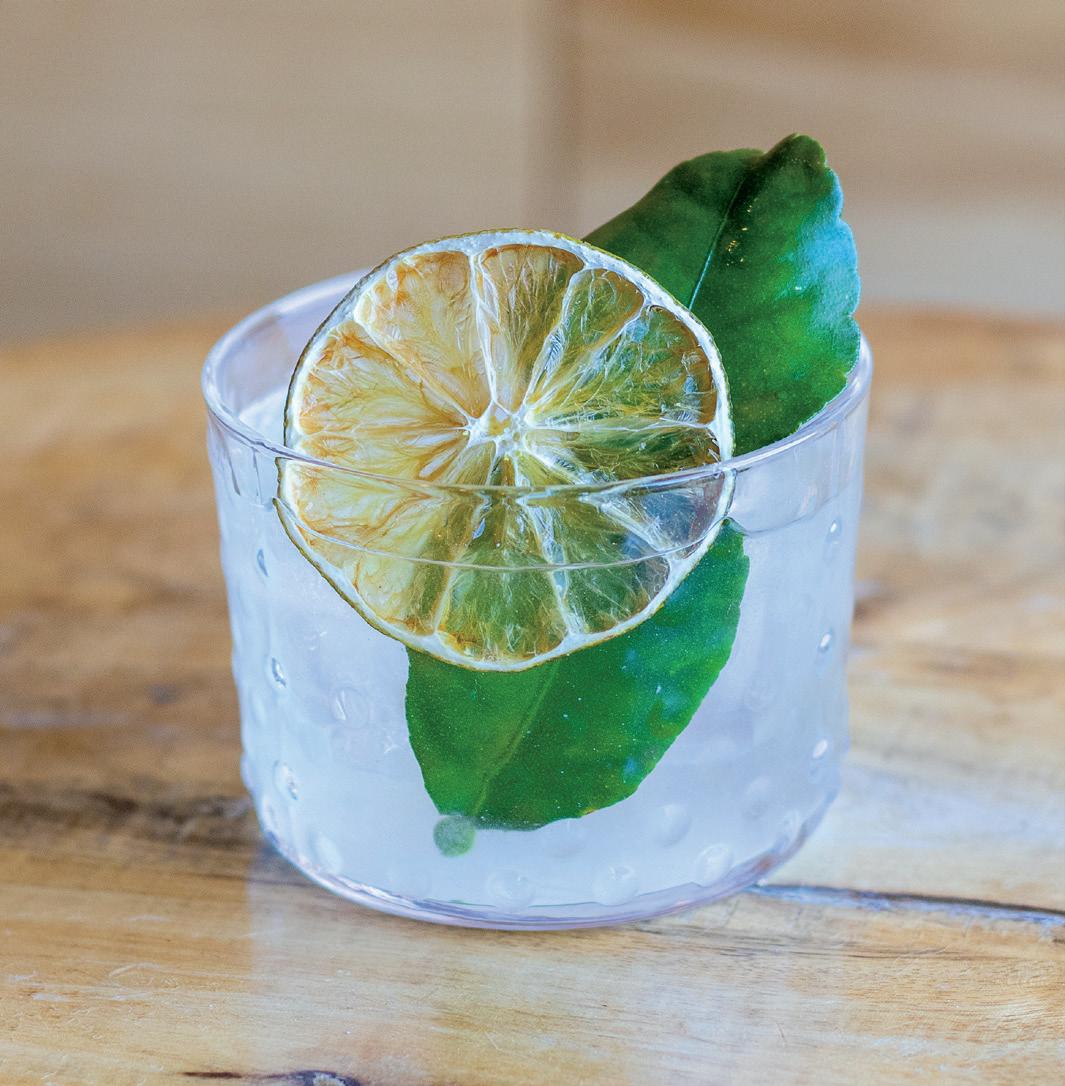
13 Going On 30
By Anna Marie Apodaca | Serves 18
15 ounces key lime leaf–infused tequila
15 ounces reposado tequila

15 ounces simple syrup
10 ounces lime juice
10 ounces St. Elizabeth Allspice Dram
20 ounces coconut milk
Lime leaf or candied lime wheel, for garnish
Combine all ingredients in a large pitcher, adding coconut milk last. The coconut milk should curdle when combined. Refrigerate for 24 hours, then strain mixture once. Place a coffee filter in the strainer and strain again. (With double straining, the cocktail will become clear.) Serve over a large ice cube and add lime leaf or candied lime wheel.
AS ABOVE SO BELOW DISTILLERY 545 Camino de la Familia, Santa Fe 505-916-8596, aasbdistillery.com
OPUNTIA
10,
1607
CAFE June
7 pm–12 am: Dance Party
Alcaldesa, Santa Fe, 505-221-1112, opuntia.cafe
Watermelon Jalapeño Mule

By Mixed-Up Cocktail Co

1 1/2 ounces vodka
2–4 slices of jalapeño
4 ounces watermelon juice
1 teaspoon each: ginger juice, lime juice, lemon juice, agave nectar
Tajín
Jalapeño slices and orange slice, for garnish
Rub rim of glass with a lime wedge, then dip it into powdered Tajín, fill with ice, and set aside. Muddle jalapeño in bottom of a cocktail shaker, add other ingredients, and shake with ice. Pour into ice-filled rimmed glass. Garnish with jalapeño and orange slices.
OM Chocolate Espresso Martini
1 1/2 ounces vodka
1 1/2 ounces OM Chocolate Liqueur


1 1/2 ounces espresso
Whipped cream and chocolate shavings, for garnish
Shake all ingredients with ice. Strain into cocktail glass. Top with whipped cream and chocolate shavings.
SPECIAL ADVERTISING SECTION
MIXEDUPCOCKTAIL.COM ORGANICMIXOLOGY.COM
Rosemary Manhattan
 By Quinn Stephenson
By Quinn Stephenson
3 ounces Buffalo Trace bourbon
1 1/2 ounces Carpano Antica sweet vermouth
3 heavy dashes Angostura bitters
1 teaspoon Amarena cherry syrup
Rosemary vapor, for garnish
Stir all ingredients with ice until very cold. Strain into a small decanter and add rosemary vapor. Pour over a highball glass filled with ice.
Spicy Mango Daiquiri
1 1/2 ounces Santa Teresa 1796

1 ounce lime juice
1/2 ounce mango syrup
1/2 ounce agave syrup
1-3 dashes Scrappy’s Hellfire Bitters
Garnish: Tajín rim and lime wheel
Add all ingredients in tin. Shake with ice and fine strain into a chilled coupe glass.

SANTACAFÉ

231 Washington, Santa Fe 505-984-1788, santacafe.com

COYOTE CAFE
132 Water St, Santa Fe 505-983-1615, coyotecafe.com
SANTATERESARUM.COM
JUNE 4–5, SUNSET TERRACE
Join the Bacardi Brand Ambassador team for COCKTAIL SEMINARS at Sunset Terrace on Sunday afternoon, and a five-course CHEF & SHAKER dinner on Monday evening with Chef Dale Kester (Santacafé) and Consulting Chef Dakota Weiss (Coyote Cafe)!.Tickets available at nmcocktailweek.com.
Irish Maid
2 slices cucumber
2 ounces Teeling small-batch or single-grain whiskey


1 ounce lemon juice
1/2 ounce St-Germain elderflower liqueur
3/4 ounce simple syrup
Muddle cucumber in cocktail tin. Add liquid ingredients, shake with ice, and double strain into cocktail glass.
Angel’s Envy Manhattan
2 ounces Angel’s Envy bourbon finished in port barrels
1 ounce Noilly Prat sweet vermouth
2–3 dashes Angostura bitters Amarena cherry, for garnish
Stir all ingredients with ice in a mixing glass for 20–25 seconds to dilute. Strain into a chilled cocktail glass, and garnish with an Amarena cherry.

SPECIAL ADVERTISING SECTION TEELINGWHISKEY.COM ANGELSENVY.COM
Rye Bayou
2 1/2 ounce Big Nose Kate Western Whiskey 1/2 ounce 2920 anise wort syrup (see recipe below)

4 dashes Peychaud’s bitters
Lemon zest, for garnish
Anise wort syrup: Simmer 2920 IPA wort with lemon peel and star anise.
Coat cocktail glass with 1/2 ounce wort syrup. Set aside. Stir whiskey and bitters with ice in a mixing glass. Strain into coated cocktail glass. Garnish with lemon zest.
Pisco Punch
2 ounces Caravedo Puro Torontel pisco
1/2 ounce pineapple juice

3/4 ounce simple syrup
1/2 ounce lemon juice
1/4 ounce passion fruit puree
2 dashes of Angostura orange bitters
Orange peel, for garnish
Shake all ingredients with ice. Strain over fresh ice in a rocks glass. Lay orange peel onto surface of the drink.
CARAVEDOPISCO.COM
SECOND STREET BREWERY 2920 Rufina, Santa Fe 206-708-3332, secondstreetbrewery.com
Cucumber Lemonade
1 part Hendrick’s gin
1/2 part lemon juice
1/2 part simple syrup
Soda water
3 rounds of cucumber and 1 lemon wheel, for garnish
Combine all ingredients in a highball glass filled with cubed ice and lightly stir. Garnish with 3 thinly sliced rounds of cucumber and 1 lemon wheel. HENDRICKSGIN.COM

Join Hendrick’s gin ambassador Mattais Horseman for Rest & Digest yoga + brunch + seminar at Sunset Terrace on June 4. Get tickets at nmcocktailweek.com.


PLEASE DRINK THE UNUSUAL RESPONSIBLY PLEASE DRINK THE UNUSUAL RESPONSIBLY. HENDRICK’S GIN, 44% ALC./VOL. ©2022 IMPORTED BY WILLIAM GRANT & SONS, INC. NEW YORK, NY.
Milagro tequila

Patrón tequila
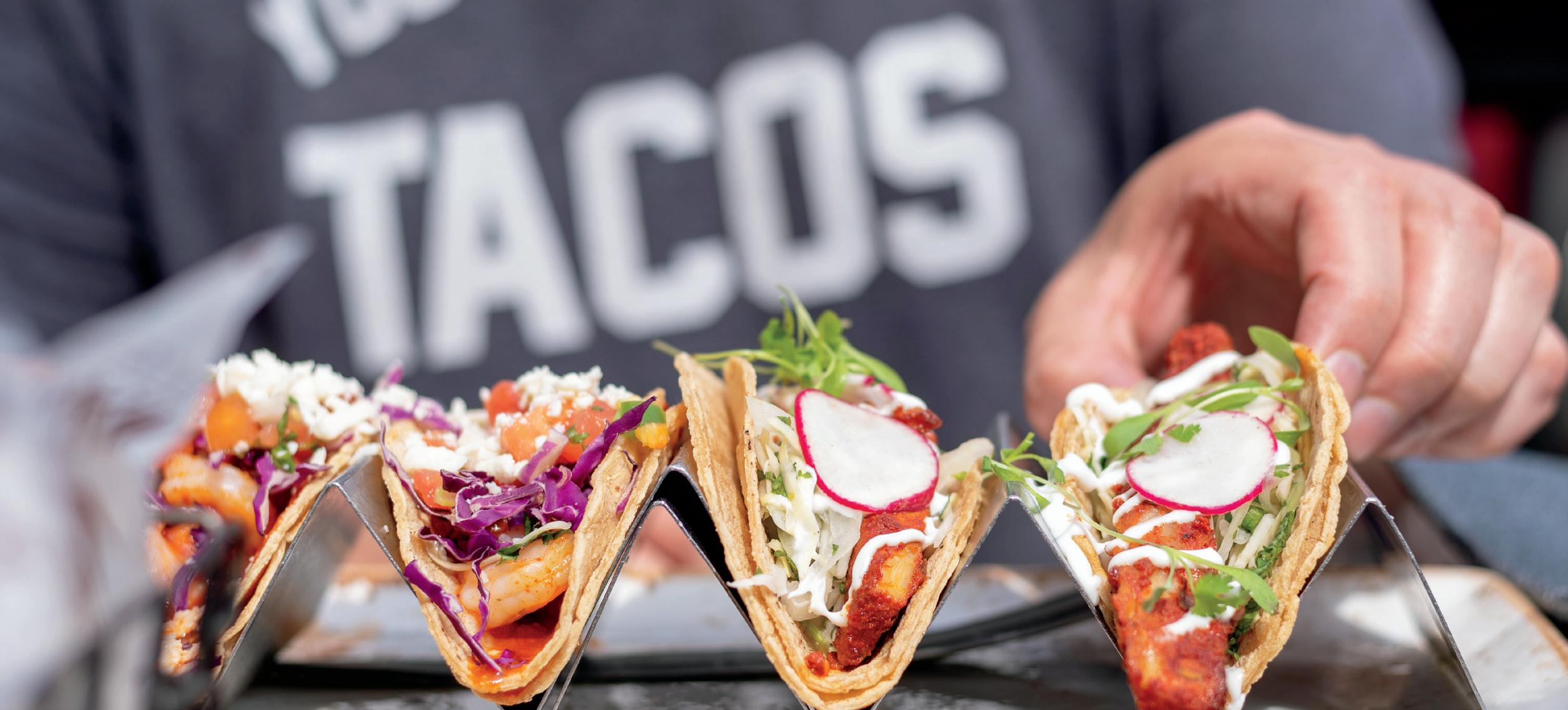
St-Germain liqueur
Teeling whiskey
Restaurants Escondido, Santa Fe Garduño’s of Hotel Albuquerque at Old Town, Albuquerque Horno Restaurant, Santa Fe La Boca, Santa Fe Last Call Baja Mexican Eatery, Albuquerque New Mexico Hard Cider, Santa Fe Opuntia Cafe, Santa Fe Rowley Farmhouse Ales, Santa Fe Santacafé, Santa Fe Sassella, Santa Fe Scalo, Albuquerque Seasons Rotisserie & Grill, Albuquerque Sheraton Uptown, Albuquerque VOTE
TACO AND SAMPLE COCKTAILS TICKETS AVAILABLE AT NMCOCKTAILS.COM Portion of ticket sales donated to Espanola Humane Animal Shelter June 3 1–4 pm 21+ only* * ID Required * No children 201 W Marcy Santa Fe Convention Center Rooftop Terrace Spirits
Distillery Angel’s Envy
TOP
As Above So Below
whiskeys Caravedo pisco
El Tesoro tequila
Hendrick’s gin
Mixed-Up Cocktail Co
Chocolate
Nikle Co OM
liqueur
Santa Teresa rum
Cocktail Vision (specialty garnishes)
Zia Beverage (nonalcoholic)

95 EDIBLENM.COM Join at t he $100 $150 • Free, unlimited admission to the Vladem Contemporar y, 11 state museums and historic sites throughout New Mexico and 1,000 cultural institutions in North America • A 10% discount and free gift with purchase at the Vladem Contemporar y Shop • Commemoratve membership card design and the special designation of Milestone Member • Members-only Preview and Grand Opening Celebration before the public opening • Be permanantly recognized with an inscribed brick at the $300 Patron level or higher Become a Member Today! • Online at museumfoundation.org/member100 • Call 505.982.6366 ext. 107 • In person at any of our Museum Shops New Mexico Museum of Art’s Vladem Contemporary Grand Opening Summer 2023
LAST BITE
COCINA AZUL
The original Cocina Azul restaurant, located on Mountain Road in Albuquerque, was founded by Frank Barela Sr. and his wife, Evelyn, in 2009. Barela developed recipes that recalled the taste of his grandmother’s cooking and the dishes he grew up with in Albuquerque. Over the years, Cocina Azul has expanded its menu and its locations. In 2020, Frito-Lay selected Cocina Azul’s chile relleno as one of five iconic dishes from restaurants across the country to become a special limited-edition Lay’s potato chip flavor. Today, the restaurant remains a beloved fixture in the Albuquerque community, offering authentic New Mexican cuisine with fresh ingredients.

The original: 1134 Mountain Rd NW, Albuquerque, 505-831-2500 cocinaazul.com
4243 Montgomery NE, 505-831-2600 cocinaazulabq.com/montgomery-blvd 5916 Holly NE, Albuquerque, 505-831-4500 cocinaazulabq.com/holly-ave
The Last Bite is brought to you by Rio Grande Credit Union and highlights New Mexico’s food entrepreneurs and small businesses.
Green chile relleno with chicken and red chile relleno with brisket.
Photo by Stephanie Cameron.
Add Some Flavor To Your Finances.


DIVIDEND CHECKING REWARDS.
At RGCU, we’re anything but bland. Savor the flavor of a checking account that pays you money market rates on your balances - AND rewards.
Ingredients (a.k.a. the fine print): Federally insured by NCUA. We don’t make you jump through a bunch of cumbersome hoops to earn rewards or dividends. You don’t have to do things like have a bunch of transactions, or eStatements to qualify. You’ll earn dividends on balances $500 and greater. There is a monthly fee if you don’t keep a daily balance of $500. You can waive that if you’re over 55 years of age. So, if you don’t plan to keep $500 in the account and you’re younger than 55, get our Free Checking account. It pays rewards too. In other words, everything you want and need, and nothing you don’t.

RioGrandeCU.org/Zia 505.262.1401


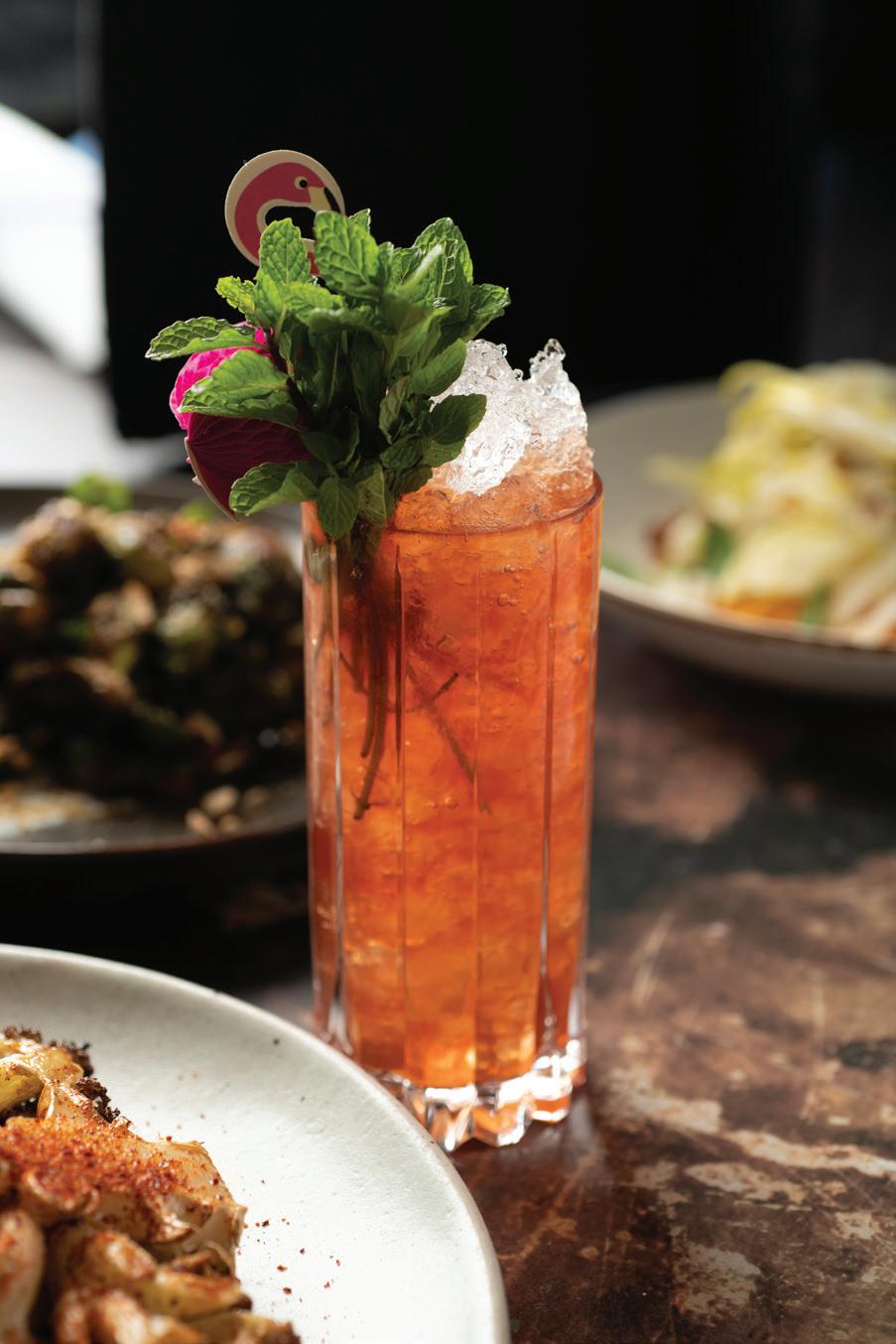




A R R O Y O V I N O C O M 5 : 0 0 P M ARROYO VINO Restaurant and Wine Shop Celebrating 5 years with Chef Allison @ | 2 1 8 5 0 5 9 8 3 2 1 0 0 | A R R O Y O V I N O WINE SHOP: TUESDAY–SATURDAY 11AM-–7PM
















































































































 By Mariko O. Thomas
Photos by Douglas Merriam
By Mariko O. Thomas
Photos by Douglas Merriam







































































































 By Christie Green
Sheep hide stretched for tanning in the field at Chispas Farm.
Photo By Stephanie Cameron.
By Christie Green
Sheep hide stretched for tanning in the field at Chispas Farm.
Photo By Stephanie Cameron.


































































 HILL CAFÉ & BYRON T’S SALOON
HILL CAFÉ & BYRON T’S SALOON








 FARM & TABLE
ZINC WINE BAR & BISTRO
FARM & TABLE
ZINC WINE BAR & BISTRO













 LOS POBLANOS BAR CAMPO
PALACE PRIME
LOS POBLANOS BAR CAMPO
PALACE PRIME










 By Quinn Stephenson
By Quinn Stephenson

























